
Read it to filth.


Read it to filth.
04 Readers Respond
04 Editor’s Note Proud as punch.
06 Pride | Isaacs With Love, Mommie Dearest goes behind the scenes of a camp classic.
14 Pride | Cover note We made two of them.
18 Pride | Op-ed Intergenerational

07 Reader Bites Ube Bismark at Somethin’ Sweet Donuts
08 Pride | Trans rights How the Illinois Department of Corrections fails trans prisoners
10 Pride | Queer history Gerber/Hart keeps queer history alive.
12 Pride | Language The word

“sapphic” is having its moment in the limelight.
20 Pride | Community art A new collaboration between ALMA Creates and PrEP4Teens
21 Pride | Cra Work The ghostly glamor and macabre camp of Bill Crisafi’s costumes.
24 Pride | Reid About Face Theatre marches on.
25 Pride | Preview Joss Barton seeks Transvengence.
27 Plays of Note Antigonick, Attempts on Her Life Footholds Vol. 5, and more

29 Pride | Caporale Fetish media empire House of Milan was bound to please.
30 Pride | Movie retrospective Go Fish at 30
32 The Moviegoer The Media Mixer, plus Méliès and Go Fish
33 Movies of Note Cora Bora solidifies a star, Robot Dreams sweetly explores friendship, and The Watchers is distinctly Shyamalan.
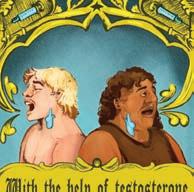
34 Pride | Brown For transmasculine singers, the choice to undergo hormone replacement therapy is rarely a simple one.
36 Pride | Chicagoans of Note Liz Jackson Hearns, founder of the Voice Lab
38 Shows of Note Previews of concerts including Rich Robbins, Mdou Moctar, Orville Peck, and the Lyrical Lemonade Summer Smash.
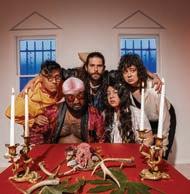
44 Gossip Wolf Oddball hiphop band Mother Fortune hit the stage with a new EP, and Tara C. Mahadevan throws an IRL party for her online interview show.
45 Jobs
46 Marketplace
46 Matches
46 Professionals & Services
46 Savage Love Pegging and other pursuits
ON THE COVER: FIRST LOOK AT BILL CRISAFI’S NEW CREATURE CREATIONS DEBUTING IN THE READER, PHOTOGRAPHED AT JACKHAMMER BY READER ART DIRECTOR JAMES HOSKING. FOR MORE OF CRISAFI’S WORK, VISIT BILLCRISAFI.COM OR FOLLOW HIM ON INSTAGRAM @BILLSAFI. THANKS TO HOGAN MCLAUGHLIN, MARK AND MIKE AT JACKHAMMER, AND READER PRODUCTION MANAGER KIRK WILLIAMSON. COVER PULL QUOTE SAID BY PAUL KOBASA IN “WE’VE BEEN HERE ALL THIS TIME” BY KAYLEIGH PADAR, P. 10.







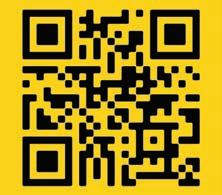
CEO AND PUBLISHER SOLOMON LIEBERMAN
ASSOCIATE PUBLISHER AMBER NETTLES
EDITOR IN CHIEF SALEM COLLO-JULIN
MANAGING EDITOR SHEBA WHITE
ASSISTANT MANAGING EDITOR
SAVANNAH RAY HUGUELEY
ART DIRECTOR JAMES HOSKING
PRODUCTION MANAGER KIRK WILLIAMSON
SENIOR GRAPHIC DESIGNER AMBER HUFF
THEATER & DANCE EDITOR KERRY REID
MUSIC EDITOR PHILIP MONTORO
CULTURE EDITOR: FILM, MEDIA, FOOD TARYN ALLEN
CULTURE EDITOR: ART, ARCHITECTURE, BOOKS
KERRY CARDOZA
NEWS EDITOR SHAWN MULCAHY
ASSOCIATE EDITOR & BRANDED
CONTENT SPECIALIST JAMIE LUDWIG
DIGITAL EDITOR TYRA NICOLE TRICHE
SENIOR WRITERS LEOR GALIL, DEANNA ISAACS, BEN JORAVSKY, MIKE SULA
FEATURES WRITER KATIE PROUT
SOCIAL JUSTICE REPORTER DMB (DEBBIE-MARIE BROWN)
STAFF WRITER MICCO CAPORALE
SOCIAL MEDIA ENGAGEMENT
ASSOCIATE CHARLI RENKEN
VICE PRESIDENT OF OPERATIONS ANN SCHOLHAMER
CHIEF DEVELOPMENT OFFICER JIM STRUTHERS
VICE PRESIDENT OF PEOPLE AND CULTURE ALIA GRAHAM
DIRECTOR OF MARKETING AND STRATEGIC COMMUNICATIONS CHASITY COOPER
MULTIMEDIA CONTENT PRODUCER SHAWNEE DAY
MARKETING ASSOCIATE MAJA STACHNIK
MEMBERSHIP MANAGER MICHAEL THOMPSON
GRANTS MANAGER JOEY MANDEVILLE
VICE PRESIDENT OF SALES AMY MATHENY
SENIOR SALES REPRESENTATIVE LINDSAY FIGURSKI
SALES REPRESENTATIVE WILL ROGERS
DIGITAL SALES ASSOCIATE AYANA ROLLING
MEDIA SALES ASSOCIATE JILLIAN MUELLER
ADVERTISING
ADS@CHICAGOREADER.COM
312-392-2970
CLASSIFIEDS: CREATE A LISTING AT CLASSIFIEDS.CHICAGOREADER.COM
DISTRIBUTION CONCERNS distributionissues@chicagoreader.com 312-392-2970
TO CONTACT ANY READER EMPLOYEE, EMAIL: (FIRST INITIAL)(LAST NAME) @CHICAGOREADER.COM Donate
READER INSTITUTE FOR COMMUNITY JOURNALISM, INC.
CHAIRPERSON EILEEN RHODES
TREASURER REESE MARCUSSON
SECRETARY TORRENCE GARDNER
DIRECTORS MONIQUE BRINKMAN-HILL, JULIETTE BUFORD, JAMAL DEGERATTO, DANIEL DEVER, MATT DOUBLEDAY, TIMO MARTINEZ, JAKE MIKVA, ROBERT REITER, CHRISTINA CRAWFORD STEED
READER (ISSN 1096-6919) IS PUBLISHED BIWEEKLY BY THE READER INSTITUTE FOR COMMUNITY JOURNALISM 2930 S. MICHIGAN, SUITE 102 CHICAGO, IL 60616 312-392-2934, CHICAGOREADER.COM
COPYRIGHT © 2024 CHICAGO READER
PERIODICAL POSTAGE PAID AT CHICAGO, IL ALL RIGHTS RESERVED. CHICAGO READER, READER, AND REVERSED R: REGISTERED TRADEMARKS ®















































































































































Re: Savage Love columns written by Dan Savage
It’s great to have the Reader back to weekly. Congratulations! I’m a longtime reader and now donor with one question: WHAT HAPPENED TO DAN SAVAGE?! Best wishes . . . —Mark McKelvey, via email
I may be wrong but it seems like the last few editions of the Reader that I have read did not contain the Savage Love column. Is Dan Savage still being featured in the Reader? —Scott Cleator, via email
Savage Love is the first thing I look at in your newspaper. Without it, I will be less likely to pick up your newspaper at all. Please do not discontinue that column. I have enjoyed it for many years. —Mark Sherkow, via email
A reply from the Reader: We’re pleased that so many of you continue to enjoy Savage Love. Dan Savage no longer syndicates his columns online, in favor of directing his readers to the URL savage.love, where you’ll find all columns, podcasts, merch, and more. Columns are available to us for use strictly in our print edition. We will continue to publish Savage Love in print when we have space to do so. We are working on a Chicago-centric sex-, relationships-, and health-focused column to debut in the coming months.
Find us on socials: facebook.com/chicagoreader twitter.com/Chicago_Reader instagram.com/chicago_reader linkedin.com search chicago-reader
The Chicago Reader accepts comments and letters to the editor of fewer than 400 words for publication consideration. m letters@chicagoreader.com




Here at the Reader , we have some statistics. A very robust 45 percent of our staff consider themselves members of the LGBTQ+ community. And 13 percent of us are genderqueer, nonbinary, and/or trans people.
For some of you reading this, these numbers may be staggering. Perhaps you work for an employer with conservative values, where your coworkers may not be as comfortable being public during work hours with their gender expression or sexual identities. Perhaps you feel the opposite, though, and you’re reading this and thinking, “Forty-five percent?! That’s nothing! What are you, a newsroom from the 1840s?” Your mileage may vary, as they used to say on the Internet, but in my experience, our ratio is pretty high and also a welcome difference from Reader mastheads of old.
While past versions of the Reader sta list no doubt had many LGBTQ+ people in various roles, the fact is that gender identity and sexual orientation were not protected classes in the workplace in Illinois until 2005. Back then, Governor Blagojevich (I know, right?) signed legislation that amended the Illinois Human Rights Act to include protections that prohibit employers from discriminating on the basis of sexual orientation. The current wording prohibits discrimination on the
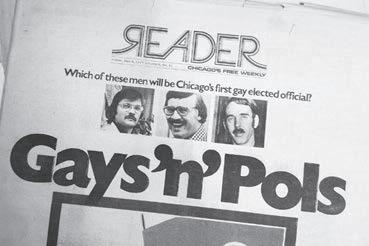

basis of “sexual orientation (which includes gender-related identity.)”
We’ve come a long way since 1971, even though the communities that celebrate Pride were living and working in every sector since before then. I’m privileged to share my workplace with a delightful and diligent crew of LGBTQ+ people and allies from a variety of backgrounds, generations, and, most importantly, neighborhoods. Pride is not just a monthlong celebration here at the Reader or, more broadly, for the Reader Institute for Community Journalism. It’s one of the pillars of our work here: honoring the brave, the unique, and those willing to forge a new path and reporting on all the best people and groups in Chicago.
I mentioned the “communities that celebrate Pride” earlier, and some of you might think, “Hey, that’s all of us!” While you’re welcome to grab your share of
The Reader has updated the online version of Miles MacClure’s June 6 print feature “Edifice Complex,” about Mayor Johnson’s pitch for a new Bears stadium. The story has been updated to clarify that the term “vaportecture” was coined by writer Neil deMause in 2009. A previous version of this story attributed creation of the term to
corporate-logo-emblazoned rainbow sunglasses at the next parade or tea dance you attend, please remember that your celebration of the LGBTQ+ community need not be limited to keeping up on RuPaul’s Drag Race and minding your business when it comes to your sister’s dating life.
Donate funds if you have them to organizations like the ones that Karen A. Morris of the LGBTQ+ Intergenerational Dialogue Project mentions in her guest column on page 18. Patronize LGBTQ+-owned businesses. Subscribe to LGBTQ+-led newspapers, like ours, and Windy City Times (starts on page 25).
Remember: Pride is joy. Chicago is joy. It’s important for those of us who love rainbows to ensure that everyone knows exactly what they represent. v
—Salem Collo-Julin, editor in chief m scollojulin@chicagoreader.com
Barry Petchesky due to an incorrect byline currently visible on a Deadspin article that was actually originally penned by deMause. The Reader is not sure why the article on the Deadspin website is currently attributed to someone who did not actually write it, but we are appreciative of readers who pointed out the error so that the proper person could be credited. v


















With Love, Mommie Dearest goes behind the scenes of the infamous biopic.
By DEANNA ISAACSLegendary Hollywood star
Joan Crawford died in 1977. In 1978, her adopted daughter, Christina, published Mommie Dearest, a memoir that revealed the abusive reality of her life in the Crawford household. The book became a controversial bestseller and inspired the movie of the same name, released in 1981 and quickly entrenched as an unintentional camp classic. In 1998, Peoria native A. Ashley Hoff, then a recent Columbia College graduate, met Christina at a showing of the film at the Music Box Theatre. This month, Ho was back at the Music Box for a screening of the film and a discussion of the book he wrote about it, With Love, Mommie Dearest, published in May by Chicago Review Press. He said he wanted to explore how a film with serious dramatic intentions that had “everything going for it” (high-profile true story, superb acting talent, glamorous costumes and sets), could have wound up as a notorious joke. Working through the pandemic, he conducted dissertation-worthy research, including interviews with many people who worked on the film, and wove it into a lively
It’s a part she lusted after, threw herself completely into, and then— apparently to this day— regretted as the spoiler of her career.
behind-the-scenes account of how the movie got made.
I might not have been the only first-time Mommie Dearest viewer in the Music Box audience that night, but it felt like I could be. The gu aws all around me began with the striking opening frames in which we saw an alarm go o at 4 AM, a pair of hands prepare an ice cube facial, and the ensuing multipart ritual of a Golden Age movie star getting ready for a
day at work—without seeing her face until she steps out with studio makeup and we’re hit with the trademark Crawford eyebrows and mouth, more strident and flamboyant than ever.
This is Faye Dunaway channeling Crawford, in a role Dunaway landed by arriving for a social evening out with producer Frank Yablans in full Crawford drag. It’s a part she lusted after, threw herself completely into, and then— apparently to this day—regretted as the spoiler of her career.
Dunaway wasn’t the first choice for the part. Anne Bancroft had been set to play Joan until her husband, a prescient Mel Brooks, told her that if she got herself made up to look like Joan Crawford and was filmed hacking down a rose garden in the middle of the night (a notorious episode from the book), audiences would be laughing at her. Bancroft backed out before production began, as did the prestigious originally slated director, Franco Zeffirelli.
After other possibilities were explored, Frank Perry—who’d been struggling with subsequent projects after his low-budget independent film, David and Lisa , had broken new ground and been nominated for two Academy Awards (including Best Director) in 1963—got the job.
Christina’s book elicited significant pushback from Joan’s legion of carefully cultivated and loyal fans, as well as the Hollywood community, most of whom wanted to protect her image. Perry and especially Dunaway were more sympathetic to Joan than to Christina.
On the set, it began to look like Method actor Dunaway—who kept cast and crew waiting as long as five or six hours while she prepared for her takes—had been taken over by her character. Perry, who saw the role as Medea, the child killer, didn’t curb her performance. The nonstop, high-intensity result (eyes a-glitter; jaw set) split critical opinion: it was either over-the-top melodrama or an epic, operatic triumph. The New Yorker ’s Pauline Kael invoked arias and Kabuki.
Within a week of opening, after learning that audiences were laughing at some of the movie’s most dramatic moments (including an infamous wire hanger beating scene), Paramount changed its marketing, embracing the camp vibe with posters displaying a wire hanger and a tagline that said “biggest mother of them all.” Yablans sued over that and the studio backed off, but the film’s identity as camp classic and drag queen inspiration was cemented, accounting for most of its continuing popularity more than 40 years later.

The Music Box audience shouted out the iconic lines (“Tina! Bring me the axe!”) and found plenty of humor in the film’s excesses. But, although the movie’s final words give the impression that a disinherited Christina wrote her memoir out of spite, she has said all along that her goal was to shed light on the mostly hidden tragedy of child abuse. In the midst of all the laughter, a dinner scene featuring then nine-year-old Mara Hobel (who should have had an Oscar for her performance as young Christina) transfixed me, bringing back memories of clean-your-plate battles I hadn’t thought about in decades. When children are very young, parents can wield a terrible power. Two days after this screening, the DCFS investigator who failed to protect five-year-old AJ Freund from the mother who killed him in 2019 was sent to jail.
The problem Mommie Dearest was meant to address is still out there. v
m disaacs@chicagoreader.com



Look, I understand the idiom “shock of” signifies an unpleasant kind of surprise. I also want to preface this review by explicitly saying everything about the ube bismark from Albany Park’s Somethin’ Sweet Donuts is appealing. This squat, plump treat is a platonic ideal for a doughnut; it’s a little larger than an apple; it’s sugary but not overwhelmingly so; its light, downy pastry functions as a terrific sheath to the thick ube filling.
known a color quite as warm and voluptuous as this. In truth, I’m familiar with ube, the purple yam from Southeast Asia, which I’ve usually come across in Filipino bakeries.
Somethin’ Sweet’s founding owners, Jim and Ling Chao, draw from their Chinese and Cambodian heritage in their work. They opened Somethin’ Sweet along a busy stretch of Kedzie Avenue in 2012.
I tend to pick up a matcha bismark along with an ube one. Both hit the spot, but the ube bismark has a subtle savory complexity that edges out the matcha doughnut as my favorite. Whenever I finish the ube doughnut, I usually want another. I’m shocked I’ve yet to buy more than one per visit.

That filling is a delightful shock. Whenever I’ve reached the center of this doughnut, the dense ube sits in great contrast to every other ingredient—hell, to anything else in my field of vision. The dark purple exudes an elegant richness and suggests I’ve never

—LEOR GALIL SOMETHIN’ SWEET DONUTS 4456 N. Kedzie, $4.49, 773-654-3117, somethinsweetdonuts.com v
Reader Bites celebrates dishes, drinks, and atmospheres from the Chicagoland food scene. Have you had a recent food or drink experience that you can’t stop thinking about? Share it with us at fooddrink@ chicagoreader.com.
The bombs envision equal access to Arab, Druze, Bedouin, and Ethiopian Israeli populations.
Their death-making strategy is focused on expanding fractures to promote a divided society, promising underrepresented populations become reduced to ashes.
High-tech war machines destroy core civic and education institutions.
Entry points for aid are a thriving place for diversified armed settlers.
Through the General Dynamics portfolio, we maintain commitments to inequity and terror and an apartheid society.
FOOTNOTE: ISRAEL
By Stavroula HarissisWe envision a thriving Israel where underrepresented populations have equal access to the country’s high-tech sector and its promising career and economic opportunities.
CFP’s Israel grantmaking strategy is focused on diversifying Israel’s high growth, high-tech sector to promote equity and reduce fractures within Israel’s socially and economically divided society. This requires intentionally expanding entry point opportunities to the sector—particularly amongst the Arab, Druze, Bedouin, and Ethiopian Israeli populations. Through the Israel portfolio, we also maintain commitments to supporting core civic and education institutions, as well as promoting a shared society.
-Excerpt from: https://crownfamilyphilanthropies.org/our-work/jewish-giving/
Stavroula Harissis is a librarian and ESL educator living on the north side of Chicago.
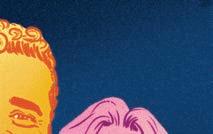
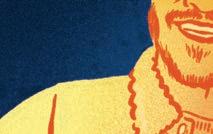




Poem curated by Bindu Poroori (@himabindu). Bindu wishes for the annihilation of class, caste, and race. They are Interim Director of Community Organizing at Arts Alliance Illinois, an organizing member of @chicagodesiyouthrising (CDYR), an organizer with UChicago Alumni for Palestine (@uchialum4palestine), and part of the surf punkBollywood cover band, Do The Needful (@dtn_chicago). She would love to talk to you about green mango dal.






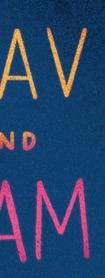
A weekly series curated by the Chicago Reader and sponsored by the Poetry Foundation.
Summer Hours
Wednesday– Saturday: 11:00 AM–5:00 PM
Poetry on Stage: Sarah Ruhl’s Letters from Max







Join us for a reading of Sarah Ruhl’s play, Letters from Max, directed by Polly Noonan. This play shares letters and poems passed between Ruhl and her former student, poet Max Ritvo, as he candidly discusses terminal illness and tests poetry’s capacity to put to words what otherwise feels ineffable. Sarah Ruhl will play herself and Zane Pais will read the role of Max Ritvo. A brief talkback with the playwright will follow the program. Saturday, June 29 at 2:00 PM CT
Learn more at PoetryFoundation.org



Attorneys and incarcerated people say IDOC staff o en fail to listen to transgender prisoners and are disconnected from their needs.
By KATIE SCHULDER-BATTISEditor’s note: This story contains references to sexual assault and suicide.
Hannah Finnegan transferred to Lawrence Correctional Center in southeastern Illinois in May 2021. She’d previously been imprisoned at Centralia Correctional Center, another men’s prison about an hour outside Saint Louis. At Centralia, Finnegan, a transgender woman, experienced harassment and abuse from sta and others incarcerated alongside her. She received letters expressing unwanted sexual and romantic interest. She often relied on friends she met inside for physical protection.
The Illinois Department of Corrections (IDOC) classified Finnegan as “vulnerable,” meaning she was supposed to be housed alone or with others whom staff determined to present a low risk of danger. But at Lawrence, o cials assigned her to a cell with someone who’d been convicted of predatory criminal sexual assault, and who was already under investigation by the IDOC for allegedly abusing a past cellmate. While housed together, in June 2021, Finnegan’s cellmate sexually assaulted her.
“If he had been screened, no one would have ever thought that it would be appropriate to place her in a cell with him,” says Elizabeth Mazur, an attorney representing Finnegan in an ongoing legal battle against the IDOC. “It’s one thing to have good policies. But it’s another thing to actually have systems in place where people are following those policies.”
safety of the individuals inside. According to Mazur, correctional sta often fail to listen to transgender prisoners and are disconnected from their needs. “Prisons can be such unsafe places, especially if you have any kind of vulnerability. I think it’s a mistake to assume that the system is going to get it right.”
In response to a request for comment, IDOC public information officer Naomi Puzzello wrote, “The Illinois Department of Corrections is committed to ensuring world class care for transgender individuals in custody. Every person in our custody deserves to have their needs fully met and humanity fully recognized, and we are deeply committed to this critical work.”
In 2021, after 13 years of imprisonment in IDOC facilities for men, prison officials relocated Hannah Finnegan to Logan Correctional Center, one of the state’s two prisons for women, in central Illinois. According to Mazur, Finnegan’s experience is far from unique, and transgender women continue to be held in facilities for men.
In the IDOC’s annual report for the 2022 fiscal year, prison officials say they hope to improve the “knowledge of our staff around transgender education and risk assessment.”
But the same report, which contains a statistical breakdown of prisoners into 28 “holding o ense” categories, does not distinguish between gender and sex and categorizes people as either male or female.
Discrimination against trans women by medical staff is pervasive in women’s prisons.
In prison, the gap between written policies and the enforcement of those policies can have lasting implications for the health and
In official documents, including responses to grievances, prison sta repeatedly use Finnegan’s dead name and refer to her as “male,” despite her many attempts to initiate the process of changing these identifiers while inside. “When referring to me, please use female pronouns,”
she wrote in a 2018 grievance to the IDOC. (In their response, the prison’s grievance o cer again referred to Finnegan using incorrect pronouns.)
After her assault at Lawrence, Finnegan filed an emergency grievance on August 8, 2018. “Before placement, I had informed sta of my concerns regarding being placed in a cell with men,” she wrote. She worried she’d be moved out of her cellblock and into solitary confinement “for her protection,” a common outcome after filing a report under the Prison Rape Elimination Act (PREA). Moving to a new part of the prison would mean losing access to trusted individuals within the facility. “I’m afraid they’ll construe [the assault] as consensual because I gave into pressure, or of being placed in segregation while they investigate.”
After she submitted her PREA report, Finnegan sat for a series of interviews with the IDOC’s internal affairs division. During these interviews, according to a grievance Finnegan filed with the IDOC, investigators asked her seemingly unrelated questions about previous sexual relationships and her gender identity. Once, she recalled, a lieutenant remarked to her that he thought Fin-
negan could’ve bested her abuser in a fight. “I think you could have took him,” the guard quipped. (She weighed 135 pounds at the time of the attack and had been taking estrogen for four years, according to her grievance; her attacker weighed 180 pounds.)
On the other hand, investigators questioned the person who assaulted Finnegan for a mere 13 minutes, court documents show. The interview appeared casual; investigators never even read the alleged attacker his Miranda rights. Instead, they simply requested he make a statement to the internal a airs department.
In October, Finnegan filed another grievance when she learned the IDOC continued to house the person who assaulted her in a shared cell. In their response nearly two weeks later, prison officials relayed that the “IDOC reserves the right to assign offender housing as deemed appropriate.” (By now, her attacker had been transferred to a lessersecurity prison.) “It is really a systemic problem that something went so wrong and there was such a catastrophic outcome,” says Mazur. “And from the agency’s perspective, it’s just business as usual.”
An internal investigation in 2022 concluded Finnegan’s sexual assault claim was “unsubstantiated,” a resolution assigned to twothirds of all PREA investigations into sexual abuse among incarcerated people in the U.S. that year, compared to less than 8 percent of claims prison o cials deemed substantiated.

Evidence presented in Finnegan’s lawsuit suggests the IDOC’s failure to protect Finnegan’s safety could constitute deliberate indi erence, a violation of the Eighth Amendment’s prohibition against cruel and unusual punishment. Finnegan expects her case against the IDOC will go to trial later this year.
According to Vanessa del Valle, clinical associate law professor at the MacArthur Justice Center, part of the Northwestern University Pritzker School of Law, merely housing trans people in appropriate facilities does not guarantee safety from discrimination or violence. “The second problem, then, is . . . how does IDOC manage having a transgender woman in a women’s facility?” del Valle explains. “They’re abused by staff—many of whom believe that trans women should not be in women’s facilities. And then there’s also harassment from other women who also do not want a trans woman at the women’s facility.”
Del Valle represented three trans women in lawsuits against the IDOC. One of her clients, Strawberry Hampton, became the first transgender woman in the state to be transferred to a women’s prison, after she and del Valle successfully fought the prison system. In her suit, Hampton detailed horrific abuse she experienced while at Menard Correctional Center in southwestern Illinois and Pinckneyville Correctional Center, near the southern tip of the state. Del Valle says guards forced Hampton and her cellmate to engage in sexual acts while they watched, and they once made Hampton pretend to engage in phone sex during a prank call for an o -duty lieutenant’s birthday. “The o cers were not doing anything to protect her from that abuse,” del Valle says. “They were actually kind of encouraging it and letting it happen.”
PREA was designed to provide people in prison with an avenue to safely report sexual violence. But del Valle says it fails to protect those inside from abuse by prison sta . “There is a PREA hotline that all individuals are supposed to have access to. But to get access to that hotline, you have to then ask the ocer—who’s the one that’s been harassing you and sexually abusing you—to let you use the hotline in the first place.”
After Hampton reported some of the abuse that she experienced in IDOC facilities, del Valle says guards retaliated. “Some of the officers that she had reported were withholding meals from her. And then they were claiming that she went on a hunger strike because they had to document why she wasn’t eating.”
After her assault, Hannah Finnegan requested medical assistance.
During her initial medical appointment, she recalls being given only an HIV test. In a 2018 grievance, she wrote, “I just wanted to lay in bed and cry, so the faster I got out the better. I figured I’ll receive testing at some point soon anyway. And therapy.” But when she filed another grievance a month later, requesting additional testing and therapy, the IDOC rejected her requests. “Mental health treatment as well as medical care will be provided as deemed necessary by qualified providers,” an officer wrote in response.
“I’m afraid they’ll construe [the assault] as consensual because I gave into pressure, or of being placed in segregation while they investigate.”
chologist and the IDOC’s southern regional psychologist administrator, issued recommendations in response to Hampton’s case that correctional officers and mental health staff partake in training on traumainformed care and mental health care for transgender patients.
against her further by having her housed in a very restrictive unit where she’s only let out of her cell two hours a day.”
The cellblock Monroe is now assigned to is supposed to act as transitional housing for folks who are preparing to be moved to lowersecurity housing areas within the prison. People on the tier can enroll in “step-down” programming that, once completed, offers them opportunities for more lenient housing. Monroe completed the programming, del Valle says, but remains locked in solitary confinement for 22 hours a day.
Finnegan still hadn’t received proper testing a full year later, and she filed another grievance citing an institutional directive that supposedly guaranteed treatment to victims of sexual abuse. That treatment, according to Finnegan, is supposed to include tests for syphilis, hepatitis B and C, and HIV, as well as follow-up tests administered three, six, and nine months after the initial appointment. “The only STI/STD testing I received since reportedly being raped by him was one HIV test,” Finnegan wrote.
Discrimination against trans women by medical staff is pervasive in women’s prisons, according to del Valle. While representing Janiah Monroe, a trans woman who was repeatedly assaulted during her time behind bars, del Valle observed that her client continued to experience harassment even after being relocated to Logan.
“It’s not only correctional sta , but it’s also mental health staff,” she adds. “These are counselors—who should be providing her mental health treatment—who are misgendering her.”
Following Hampton’s suit, Chief Judge Nancy Rosenstengel of the Southern District Court of Illinois issued a memorandum in November 2018 ordering the IDOC to provide staff with a variety of training sessions.
Dr. Shane Reister, a licensed clinical psy-
Prior to the training, Reister and other mental health staff observed staff misgendering Hampton and calling her names while at various IDOC facilities, including Lawrence and Dixon Correctional Center, in the northwestern portion of the state. The memorandum notes that, according to Reister, sta members at various IDOC facilities were unfamiliar with the concept of misgendering as well as gender dysphoria. “From at least what we see with Janiah Monroe’s cases, the training hasn’t been e ective,” del Valle says. “IDOC has really struggled with that with Janiah. And as a result, their solution has been to discriminate
Harassment from guards, including false or retaliatory disciplinary tickets, has led to further restrictions, which, del Valle says, has taken a toll on Monroe’s mental health. “She has attempted suicide more times now in the women’s facility than she did in the men’s facility. It’s great that IDOC has decided to transfer a number of trans women to Logan. But then, they have to figure out how to manage the facility so that everyone feels safe—including the transgender women at the facility.” v

m letters@chicagoreader.com
At the largest independent queer library and archive in the midwest, people of all ages work together to preserve LGBTQ+ history and ensure it remains accessible to the community for years to come. From drag costumes to love letters, the librarians and archivists at Gerber/ Hart, 6500 N. Clark, safeguard thousands of artifacts, documents, and books that help to tell the stories of queer midwesterners.
“Lots of queer people have a collector’s mindset, thinking, ‘If I don’t save this, who else will keep it?’” says Erin Bell, the archive’s director of operations. “Gerber/Hart is the answer to that. You can put your worries aside because we have a repository where we’re actively collecting these stories. We’ll take care of them and preserve them for generations to come.”
QUEER HISTORY
‘We’ve been here all this time’
The
Gerber/Hart Library and Archives fosters intergenerational connection through
the preservation of LGBTQ+ history.By KAYLEIGH PADAR
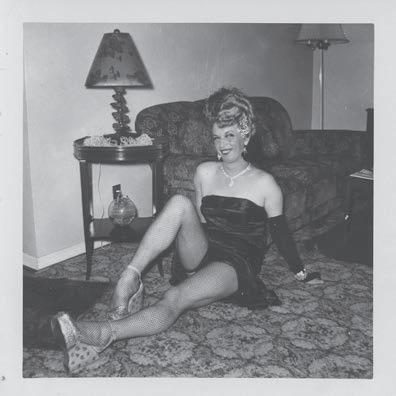
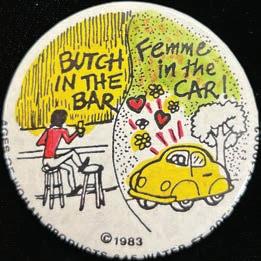
A group of queer academics founded Gerber/ Hart in 1981. The library and archives grew out of the Chicago Gay History Project, which queer historian Gregory Sprague founded in 1978 to research LGBTQ+ history and share it with the community. Since there weren’t any institutions in the midwest where people could find LGBTQ+ literature and records, Sprague and other volunteers collected hundreds of documents detailing queer people’s lives—government records, diaries, photo albums, newspaper clippings—to preserve their history. Paul Kobasa, a Gerber/ Hart volunteer, says the most important thing the archives teach people is that “we’ve been here this whole time.”
Early archivists at the organization “felt a sense of urgency” to collect queer historical materials they worried could be “discounted or discarded,” says Jen Dentel, Gerber/Hart’s community outreach and strategic partnerships manager. Early on, the museum hosted events to collect books and other ephemera

couldn’t just go into a regular public library and find books about LGBTQ+ issues,” Hansen remembers. “One of our main focuses early on was ensuring people could use our materials in [a] safe, welcoming space where they didn’t have to worry about anyone making judgments or telling their parents or coworkers they were seen reading gay books.” He continues, “The archive is still important today because if we don’t know our history, we don’t know where we’re going.”

Clockwise from center: Stickers from Queer Nation Chicago, a direct-action group from the 1990s; lesbian and transgender activist and author Leslie Feinberg (right); Lorrainne Sade Baskerville, founder of transGenesis, a social services agency for transgender Chicagoans; a vintage button from 1983; drag queen Miss Tillie, “the dirty old lady of Chicago,” circa 1940
GERBER/HART
that depicted experiences of queer life, like photo albums and diaries. “When you think about how dangerous it was to be found out as queer, documenting yourself was an act of resistance in itself,” Dentel says. “Giving those materials to the public involved a lot of risk as well.”
The archival collection was initially tucked away in residential basements throughout
Lakeview and, later, in office spaces shared with other LGBTQ+ organizations. Roland Hansen, who’s volunteered at and donated to Gerber/Hart intermittently since 1986, remembers many days spent wearing his winter coat while categorizing donated books in a chilly, 900-square-foot basement under a four-flat building on She eld Avenue. “Back then, it felt even more crucial because people
In November 1998, Gerber/Hart moved into a 5,000-square-foot, two-story storefront at 3352 N. Paulina, which housed a circulating library and archival collections as well as sta work areas and gallery space for exhibits. In 2012, the library and archive moved into its current Rogers Park digs— similar in size but with climate-controlled storage for the special collections, dedicated sta o ces, and a larger gallery space.
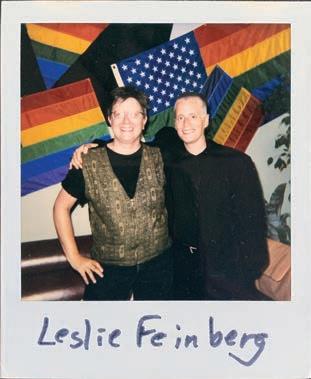
For most of its history, Gerber/Hart has been run by volunteers. But it’s grown significantly in the past few years. Now, the museum employs three full-time staff members who are working to expand community access to the archives through online exhibits, partnerships with scholars and artists, and public events. Bell says, “As a librarian and archivist, the number one goal is to serve the information and knowledge needs of the community. We want to provide a fun, sober LGBTQ+ space where questions can be asked.” “When people think of an archive or library,” adds Dentel, “they might picture dusty shelves. But our work is about making it come to life.”
In recent years, Kobasa says he’s noticed Gerber/Hart’s materials become a greater “source of inspiration for artists and researchers” and witnessed the library become more of a community space as well as a “venue for performance and discussion. . . . It’s gratifying that the wider culture is studying this subject, but it also really underlines the value of a place like Gerber/Hart.” The organization isn’t part of the public library system, meaning it can prioritize its mission to distribute information about the queer community regardless of growing e orts to limit access to LGBTQ+ materials across the country.
Inside, shelves are stocked with hundreds of queer books and movies, available to check out. The materials span genres, including children’s and young adult books. The museum also has a special collection of other LGBTQ+ print materials, like zines, newspapers, and erotica. In the archives, aisles of boxes contain ephemera of all kinds, including board games, T-shirts, flyers from community organizations, buttons, boas, and sequins.
There are, however, significant gaps in the archive, particularly surrounding information about LGBTQ+ communities of color. Gerber/ Hart has always been located on the north side and its collection was donated by people who had a close relationship with the archive. But Gerber/Hart’s leaders are working to build relationships with community organizations, like the Gage Park Latinx Council, who’ve preserved historical materials from queer BIPOC communities. They’re also working to bring the museum to more people throughout the city through virtual events and events in a variety of neighborhoods. “We want to be clear about the gaps in our collection,” says Dentel, “and we don’t want to proclaim to represent the entirety of gay Chicago. We’re trying to be more proactive about this by partnering with organizations that have access to materials that Gerber/Hart is missing so that we can amplify other work that’s being done. . . . Ideally, it would be wonderful if our collection can become more representative as well, but we don’t want to be extractive and make people feel like they should give us their stu if we haven’t built that trust yet.”
Much of the library’s archival materials come from home attics and personal collections—things that might otherwise be thrown away after someone dies. Unlike some archives, Gerber/Hart collects items from everyday people in addition to belongings from well-known figures. It aims to represent more than just “the big names in Chicago queer his-
tory,” says Dentel. For example, the archive is home to a massive collection of bacon-themed merch that was displayed in the o ce of former state representative Greg Harris, lead sponsor of legislation to legalize same-sex
“When people think of an archive or library, they might picture dusty shelves. But our work is about making it come to life.”
marriage, and sapphic love letters donated by an anonymous couple who recently split. Artifacts and firsthand accounts of LGBTQ+ experiences help illuminate the lives of queer people in ways that can’t be captured elsewhere. One donated journal includes an
When school groups tour the archives, Bell enjoys watching kids’ eyes widen when they realize its expanse. “I learned almost nothing about queer history in school growing up. It wasn’t until I started volunteering at Gerber/ Hart that I got to actually handle and touch and interact with materials about our history. Seeing yourself is really important.”
As part of her classwork, Nadia Carolina Hernandez, a senior journalism major at DePaul University, is helping curate an exhibit at the museum. “Do Say Gay: Banned Books and LGBTQ+ Freedoms’’ examines the role of queer libraries in preserving and celebrating queer stories. Hernandez and her group created one of the exhibit’s four main themes: open books, open minds. It explores libraries as accessible community spaces for political organizing and collective

entry from a person who was diagnosed with HIV/AIDs in the 80s. It details their fear and thoughts at a harrowing time. “It’s deeply moving and personal, and there’s no replacement for something like that,” Dentel says.
will be on display all summer. The archives helped Hernandez “challenge what we think of as normal or natural. It just makes you feel like you’re not alone. There have always been people with the same questions who’ve been dealing with the same problems you have. Our stories can be used as a symbolic force to unpack larger systems of oppression.”
Items in the archive o er a glimpse into the past, but the space itself fosters connections between LGBTQ+ people of all ages, allowing visitors to learn from one another as they explore their shared history. “There’s so much we can learn from each other, even in just a casual way when we’re talking about an experience we all share or realizing that we’re all interested in this history,” Dentel says. “There [are] so few places where you can go and spend time with people who are in different stages of life.”

For every young person who feels relieved to find proof someone just like them lived decades ago, there’s an older person who’s similarly moved to witness and relate to the increased freedoms younger people experience today. Kobasa began volunteering at the archives when he retired a few years ago. He especially enjoys listening to younger visitors discuss their art and research projects. Their reflections often give him “little epiphanies” about the world, and they help him see the archives in a di erent light. Once, he overheard some younger volunteers talking about going out in Northalsted. He regaled them with stories of his own experiences meeting people in gay bars in the 1970s and ’80s. “I asked them, ‘Why would you go to bars, when you have all these other options to meet people?’ And their answer was, ‘Because it’s a safe place. If I meet someone online, we’ll meet up in a gay bar. And if something goes sideways, I know I can get help.’ I thought that was brilliant. It helped me understand some of the reasons these spaces still exist today, and it was just a casual conversation.”
power-building. Other themes unpack the e ort to ban LGBTQ+ books, the ways society has minimized queer experiences throughout history, and storytelling during the HIV/AIDS epidemic. The exhibit opened on June 7 and
For Hernandez, informal conversations with older volunteers bring the archive’s historical materials to life. “You learn so much from the people who came before you, and there’s all these broad connections we have. They’ve been questioning society for so long, and obviously we’ve made progress, but we’re still talking about similar issues today.” v



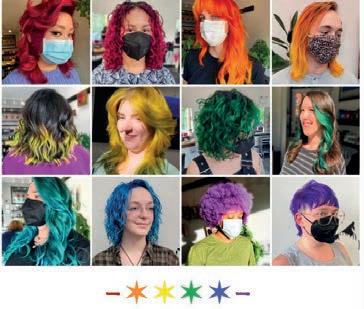

As understandings of gender and sexuality become more fluid, the term sapphic seems to be having its moment in the limelight.
By MCKENZIE SCHWARK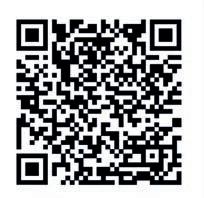
The number of words devoted to any one thing often corresponds to the fascination or care we have for it. In many ways, for the queer community, the number of words we have to define love and relationships demonstrates our commitment to dismantling and redefining what it means to love and relate to one another. As understandings of gender and sexuality become more fluid, the term sapphic seems to be having its moment in the limelight. The word is everywhere, from sapphic takeovers and themed events to queer folks using the term to identify themselves and their community.
characteristic meter.” It wasn’t until the 1890s that the term came to mean “sexual relations between women” and, by the early 1900s, to mean “female homosexual.” It surged in popularity, first in the 2000s and then again in the mid-2010s, whereas the term lesbian steadily declined between 2007 and 2019, according to the Google Ngram Viewer, which tracks the frequency of words used in books.
For the Chicago queer community, the term seems to have stuck, sparking several events and resonating with the lesser-recognized community who don’t identify as or date cis men. GoMagazine even recently called Chicago the “new epicenter of Sapphic life in the United States,” citing events like Slo ’Mo, Strapped, and Eden, and bars like Nobody’s Darling, Dorothy Downstairs, Whiskey Girl Tavern, and the Closet.





Sapphic certainly isn’t a new identifier. It originates with Sappho, a Greek poet from the island of Lesbos, whose horny and lovesick poetry about other women has been memorialized across lesbian Tumblr and Instagram. The term’s first use can be traced back to the 1500s. According to the Oxford English Dictionary , it meant “pertaining to Sappho and her poems, especially in reference to her

Sapphic has become like a silent letter in LGBTQ+, resting somewhere between lesbian and gay. For many people who identify or date outside the gender binary, queer feels too broad, lesbian too specific. Sapphic seems to have emerged as a term nestled neatly in the middle.
Lee Healy, a 28-yearold therapist living in Oak Park, feels sapphic defines their romantic life—and their relationships more broadly.
“Sapphic for me is more about the way that I romantically relate to people, whether in friendships or romantic partnerships. As someone with a lived feminine experience, I think sapphic is how I relate to other people who have a similar lived experience, whether

that’s cis women or someone who’s nonbinary or trans.” The term defines their romantic relationships in a way others can’t always see firsthand. “Saying we’re bisexual or lesbian feels like something we can see more optically. I think sapphic is more of a felt sense, like a romantic sense. I feel like I share sapphic love with my transmasc, nonbinary partner. It’s not something other people can necessarily see when they look at us. But it’s how we relate to one another.”
The way we identify has bigger implications than just who we date or sleep with. For some,
the word lesbian in particular has a sordid, complicated history. Edie McKenna, a singersongwriter living in Logan Square, came out eight years ago at 18. Ever since, she’s had a complicated relationship with the term. “Growing up, I felt like it was an ugly word, and I wasn’t sure if I was a lesbian. To distance myself, I called myself just gay. Now, I feel like I’ve learned to love it and reclaim it for myself.”
Over time, her understanding of the word changed. “It’s a really complicated word. I’ve seen it weaponized against my trans friends. And it can bring back bad memories for me sometimes. But it’s what I am. It’s kind of like my gender identity, sexuality, and lifestyle all wrapped into one word for me. I feel like it’s the way I live and see the world.”
Laura Young is the founder of Sapphic Before Sunset, which holds mixers for older queers in the Berwyn area. When she came out at 44 years old, she wanted to find a queer community close to her age and home. The term lesbian didn’t quite resonate with her because organizations and events that marketed themselves as such typically only welcomed cis women. She often found it associated with TERFs, or transexclusionary radical feminists. “Words matter, and it’s so interesting how, for example, queer used to be a slur that the community is now taking back,” says Young, who teaches high school English. “I talk about that when we talk about language in my classes. We read [Chimamanda Ngozi Adichie’s Dear Ijeawele, or a Feminist Manifesto in Fifteen Suggestions]. And one of [Adichie’s suggestions] is to question language, question the terms you use, and be willing to shift and change.”
Today, lesbian bars and sapphic events represent a more welcoming and inclusive environment, and one that is interested in challenging societal norms, even within the
queer community. Rainn Thomas, cofounder and host of Dorothy’s queer open mike, Fruit Salad, feels being sapphic is far bigger than sexuality. “At a lesbian bar, there is a divestment from patriarchy in a way that other gay spaces aren’t doing. It’s an important critique of queer spaces. How do we divest from these power structures of cishet normativity and patriarchy and white supremacy?” Being sapphic goes beyond sexuality. It’s a way of living that challenges romantic, political, and social norms. “For me, it’s also a huge part of my Blackness as well. There have been so many incredible Black lesbian scholars who have come before me and done incredible work in queer spaces for the good of all queer people. . . .
It’s a sense of pride to call myself a Black lesbian in the way that I also want to be someone who is making that kind of change. And I think that’s tied to sapphic culture.”
Molly Fryda started the Hoyden, an organization that aims to create inclusive and empowering events for Chicago’s “shes, theys, and transgays.” The group’s “sapphic takeovers” are a way to take space at traditionally nonsapphic bars. Their first takeover was at the Parrot, a Lakeview dive she describes as “heterosexual and fratty,” where the sapphics had a great evening hanging out and playing pool. “I think we’re moving toward getting rid of labels,” says Fryda, “and bigger labels like sapphic will become our default. You can be so fluid, and that should be reflected in our language.”
Drag performer Kari BunnE and her girlfriend, Stef, wanted a place to party with other sapphics. They pitched Sapphic Saturdays—an event to celebrate sapphic drag performers, pop music, and culture—to the Northalsted bar Sidetrack. “I wanted to go to the club and shake my ass,” says BunnE, about the lack of party spaces for sapphic people. “We play all sapphicidentifying music and invite all sapphic-identified performers. We have AFAB [assigned female at birth] and nonbinary drag queens, drag kings, and it’s turned into this very beautiful
and fun way to celebrate sapphics.” “This is the year of the sapphic,” adds Stef. “It has to be, and we have to be visible, and take up space to make it that way.”
For all the ways the word helps us be in community with one another and understand or define our relationships, it’s the way it helps deepen our understanding of ourselves that might be most meaningful. Thomas recalls a quote from Sappho’s poetry: “You burn me.” While closeted, they “couldn’t imagine what it would be like to burn for another person. . . . It’s such a wonderful thing to be out and queer even though it was a scary change to make. On an anatomical level, this is who I always was. And I feel love so much di erently than when I was closeted because I’m really loving myself for the first time.” v
m letters@chicagoreader.com


In the 1970s, the illustrator Arnold Lobel created a series of children’s picture books about the bond between Frog and Toad, a friendship that felt like more to many readers. Four years after publishing the first book in the series, he came out to his family as gay. Years later, his daughter suggested that writing about Frog and Toad was the start of that coming out process. He went on to create more magical tales and died in 1987 from AIDS-related complications.
As LGBTQ+ children, we often escape into fantasy and art to find respite from a world that can be alienating, or worse. Bill Crisafi’s work marries our favorite fairy-tale archetypes with drag camp, adding a splash of adult humor. His creatures embody a stage of transformation, caught between human, animal, and mythic worlds. They’re both the princess and the monster. They’re also in the tradition of LGBTQ+ art that takes gender tropes, mass culture, and the mythic and turns them into something fascinatingly unfamiliar, perhaps a bit challenging, and unmistakably queer. For me, Pride is a celebration of that unique aesthetic space. It’s a place that LGBTQ+ people can call our own and find solace in.
To the left is an alternate cover that we liked too much not to share. I hope you also enjoy these two first looks at Crisafi’s new creature creations, debuting here in the Reader. Maybe you’ll see them this month in a corner of a club or nursing a drink at the bar. Happy Pride. v
—James Hosking, Art Director jhosking@chicagoreader.com







































to end the HIV/AIDS epidemic with your purchase of the Illinois Lottery’s $200,000!
In recognition of World AIDS Day in 2009, the Illinois Lottery and the Illinois Department of Public Health (IDPH) launched a new Instant Ticket to raise funds for the Quality of Life grants, which are distributed to organizations across the state that work in HIV/AIDS prevention education, and treatment. Since its inaugural year, sales from the ticket have raised over $12.6 million to increase awareness of HIV/AIDS and access to testing, prevention education, treatment, and other resources. In addition, IDPH collaborates with Quality of Life recipient organizations for staff training in areas such as HIV test counseling, HIV risk-reduction interventions, and patient navigation. These efforts directly support the Getting to Zero Illinois plan—the ambitious campaign, launched by Governor J.B. Pritzker and IDPH in 2019, that aims to end the AIDS epidemic in the state by 2030. In 2024, the Illinois Lottery introduced their joint specialty ticket, the $200,000! Bingo Tripler Instant Ticket, to fund the Quality of Life grants, along with other worthy causes. The ticket, which has a bright sunshine yellow color perfect for summer, costs $5 and is available for purchase at more than 7,000 Illinois Lottery retailers throughout the state. Visit the Illinois Lottery website for more information.

Percent of People Living
HIV by Transmission Category: Illinois, 2021
The AIDS epidemic is a public health crisis impacting millions of people across the globe. The illness, first identified in 1983, is caused by the human immunodeficiency virus (HIV), which targets the immune system, leaving the body vulnerable to life-threatening infections. While medical breakthroughs such as antiretroviral therapies and pre-exposure prophylaxis (PrEP) treatments have reduced the risk of contracting HIV and have made it possible to manage the illness as a chronic condition, the fight to eradicate the disease continues; the Centers for Disease Control (CDC) reported that in 2021, 15 percent of people living with HIV were unaware of their status, 10 million people living with HIV were not accessing potentially lifesaving treatment, and 1.5 million people had newly acquired the illness.
In Illinois, where, as of 2021, approximately 48,000 people (of 38.4 million people worldwide) lived with HIV, Governor Pritzker and the Illinois Department of Public Health (IDPH) joined forces with healthcare providers, community groups, activists, and people living with HIV or AIDS for the Getting to Zero Illinois plan. The campaign seeks to reduce the number of new transmissions in Illinois and en-
sure that every Illinois resident living with HIV or AIDS receives proper care, with a vision of ending the epidemic in the state by 2030.
The Jolt Foundation is working to make that dream a reality. The Peoria-based group was founded as a Narcan distribution initiative by Dr. Tamara Olt in 2012, following the accidental overdose death of her 16-year-old son, Joshua Olt (the name Jolt combines Joshua’s first initial and surname). They’ve since expanded operations to provide comprehensive harm-reduction services to people who use drugs, engage in sex work, or are experiencing homelessness or other forms of marginalization.
Behaviors such as engaging in risky sexual activity (including unprotected sex) and sharing needles and syringes are associated with an increased risk of contracting HIV and other blood-borne illnesses; the World Health Organization estimates that of the 11 million people who use intravenous drugs worldwide, one in eight live with HIV.
According to Jolt director Chris Schaffner, that all makes HIV prevention and support services a natural and essential part of the foundation’s work.
This sponsored content is paid for by Illinois Lottery
Male Transmission Categories
Injection Drug Use: 6.3%
Heterosexual Contact: 6.8%
Male-to-Male Sexual Contact: 79.3%
Male-to-Male Sexual Contact and Injection Drug Use: 6.6%
Other/Unknown*: 1.0%
Female Transmission Categories
*Includes risk factor not reported or identified, along with hemophilia, blood transfusion, perinatal exposure, or missing/suppressed data.
“Because we’re in the streets, we can access some of the most high-risk and vulnerable folks. We’re able to identify them and [if necessary], get them linked to care with our partners,” he says.
The very principles of harm reduction—which involve practices and strategies that reduce negative consequences associated with drug use—have roots in the dawn of the HIV crisis, a er it became clear that the illness was transmitted via direct contact with specific bodily fluids, such as blood. “It was people at risk for HIV helping to take better care of themselves,” Schaffner says. “Once [HIV] jumped outside of the population that we call in public health languagel ‘men who have sex with men,’ and got into the [general] blood supply, people who injected drugs and were sharing needles were at risk. Syringe access was really about preventing that from blowing up in that population.”
Thanks to Jolt and their partner organizations, the number of new HIV transmissions via needle sharing has gone down in the 15 counties of IDPH’s region 2. “We haven’t had a positive transmission of HIV through needle sharing in several years,” Schaffner says. “The state has actually deprioritized that as a risk category.”
Jolt’s ability to meet people where they are without judgment has been key to that success. As a small organization, Schaffner says, staffers are able to wear multiple hats, but whenever possible, they empower team members to focus on areas where they can draw on their own lived experiences. For example, a former sex worker might be connected with community members who are currently engaged in sex work. “I’m a firm believer that it’s important to get the right people on the bus, and the right people in the right seats,” Schaffner says. “Not just because that’s how a good efficient organization will run, [but also] because they’re most likely to get the greatest amount of pleasure and meaning from the job.”
The funding Jolt receives through the Illinois Lottery’s specialty ticket program helps fuel their vital HIV testing and outreach

services. “We start by recruiting peers—either somebody who lives with HIV, or who has their viral load suppressed and is engaged in care and services—who then help others with HIV prevention, or navigating PrEP, and especially health education,” Schaffner says.
People in Jolt’s target populations Jolt serves can visit their office for HIV testing Mondays through Fridays between 9 AM and 5 PM. “People can come in on a walk-in basis,” Schaffner says. “A test takes 15 to 20 minutes. If you’re positive, we’re gonna sit with you and we’re gonna walk you through that process—it’s a lot to deal with.”
While Jolt does not provide medical treatment, its peer navigators can assist clients with things like transportation to and from medical appointments, accessing funding for medication, and connecting them with treatment providers. They also conduct mobile testing at outreach events during Pride month and throughout the year, and through the ongoing efforts of their street team. “If they encounter people that meet criteria for [HIV risk], they can test them right there,” Schaffner says.
“We really believe harm reduction is radical love expressed in really practical ways,” Schaffner says. “People are more likely to make positive changes when they engage in nonjudgmental programs like ours, where we just meet people where they’re at. We don’t coerce anybody, and yet we see people make significant changes all the time—and even if they don’t, their lives still matter.”
Support the Jolt Foundation and other Illinois organizations and help end the HIV/AIDS epidemic with your purchase of the Illinois Lottery’s, $200,000! Bingo Tripler Instant Ticket.

Opportunities for connection between LGBTQ+ people of different generations are valuable and should be encouraged.
By KAREN A. MORRISIn my 18 years of teaching college students, I have found that many LGBTQ+ young adults do not realize that older gay, bi, trans, nonbinary, or queer people exist. A significant number believe that they themselves won’t live past 40. Earlier this year, a 20-year-old transgender student began crying in my class as they described the elation they felt exploring a collection of photographs and interviews with older transgender adults. “To see people like me who made it—and they’re happy,” they whispered, “it gives me hope.”
Younger and older LGBTQ+ people need each other. Yet, unlike most marginalized populations in the U.S., LGBTQ+ folks rarely interact across generations. They are seldom born into families and communities with openly LGBTQ+ adults. For decades, our society and educational institutions have actively kept LGBTQ+ adults away from our youth to “protect” them.
The stakes are high. The Trevor Project’s 2024 U.S. National Survey on the Mental Health of LGBTQ+ Young People reported that LGBTQ+ teens are four times more likely to attempt suicide than heterosexual or cisgender peers. The fury of recent anti-LGBTQ+ legislation (much of it focused on youth) has increased their precarity and anxiety.
Today’s estimated three million LGBTQ+ older adults living in the U.S. experience significantly higher rates of social isolation, poverty, homelessness, and illness as a result of a lifetime of discrimination, lack of protection for employment and same-sex partnerships, inadequate access to affirming health care, and estrangement from family. As this population ages, they are confronted with a scarcity of a rming housing and care options for older
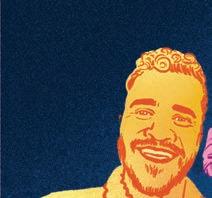
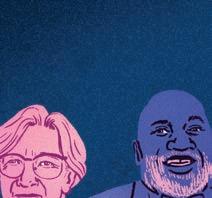
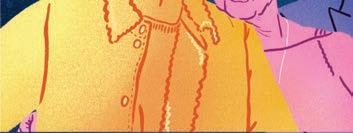
adults and face tough decisions like possibly going back in the closet to ensure their safety in nursing homes.
While research has overwhelmingly shown the power of intergenerational connection to improve mental and physical well-being in youth and aging populations, opportunities for LGBTQ+ people are rare. Both mainstream and LGBTQ+-focused news outlets have recently reflected concern about “the generational divide” in queer communities. Yet there are few models for how we can actually start to close that divide, especially in sustained and meaningful ways.
To those who are searching, I say: Look to Chicago. Our city, long a leader in LGBTQ+ rights and movements, is emerging as an innovator in queer intergenerational community building. New programs focused on intergenerational connection intersect with established organizations and activism in which younger and older adults work (and play!) alongside each other. In Chicago, we can see models piloted and refined, learn from their challenges, and identify what’s needed to keep moving forward.
One Roof Chicago is building affordable housing for LGBTQ+ elders and young adults in Bronzeville. A nity Community Services centers Black queer women through intergenerational community organizing, education, and healing justice. The LGBTQ+ Intergenerational Dialogue Project (which I cofounded in 2019) brings together “elders” and “youngers” for dialogue and collaborative artmaking through a partnership between faculty at three academic institutions and the Center on Halsted’s senior services program. Gerber/Hart Library and Archives offers a robust volunteer program and community events for generations to come together over history, archiving, and


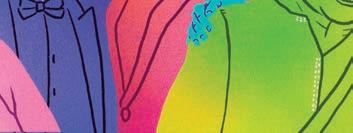
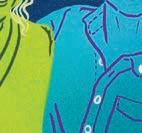

current events. Monthly OUTSpoken! LGBTQ+ storytelling events at Sidetrack feature multigenerational storytellers and audiences. Key challenges arise in practice. Many funding sources unwittingly reinforce generational divides by focusing on either “youth” or “aging” initiatives, but not both. LGBTQ+ community centers and social service organizations often lack sta and resources to sustain them. Stigma about elder/younger encounters between LGBTQ+ people prompts older adults to distance themselves from youth for fear of being seen as predators. Even with the best of intentions, it can be challenging to find common ground for folks whose experiences intersect in diverse ways with race, class, identity, and history.
This is where you, dear readers, come in. LGBTQ+ folks and our allies of di erent ages, backgrounds, and socioeconomic statuses must come together to pull for change.
First, we must recognize that coalition across queer generations is radical and worth fighting for. Our elders are untapped resources for youth-focused activism, education, and mentorship. They bring personal experience with LGBTQ+ histories, movements, struggles, and cultures that span 80 years of tremendous change. Our youth bring energy and knowledge about contemporary LGBTQ+ cultures and terminologies, social media strategies, and organizing. They can be powerful allies for LGBTQ+ elders as co-activists agitating for rights to a rming housing and health care, as well as mentors to older adults who come out and/or transition later in life.
Second, we should support the organizations that are, or would like to be, doing the work. Funding is the biggest need; make donations to support intergenerational programming. See if your employer will match these
donations or, even better, make one of their own. Encourage funders to create grants and incentives for LGBTQ+ organizations to offer programs bridging generational divides. Push media outlets to feature positive stories and images of LGBTQ+ intergenerational friendships, chosen families, and communities. Third, be intentional in seeking out and participating in events, programs, groups, and activism geared toward folks of generations di erent from your own. In addition to getting involved with the organizations listed above: sign up for the Chicago Social Butterflies weekly calendar of LGBTQ+ happenings, and the Chicago mayor’s Advisory Council on LGBTQ+ newsletter. Attend events like the upcoming exhibition “People Who Came Before Us” at South Asia Institute, which documents histories of Chicago’s South Asian LGBTQ+ community; the LGBTQ+ Intergenerational Dialogue Panel with Gerber/Hart at Dorothy; and One Roof Chicago’s intergenerational discussion table at Pride South Side. Volunteer with the Chicago LGBTQ+ Hall of Fame, Center on Halsted’s youth and family services program, Big Brothers Big Sisters (ask to be paired with an LGBTQ+ young person), Howard Brown’s Vernita Gray Council, or SAGE x HearMe. Or get involved with Chicago Therapy Collective, Sisters in Cinema, Reunion Project, Brave Space Alliance, or AgeOptions’s Thrive With Pride in suburban Cook County. This issue features the portraits and stories of three intergenerational pairs who met through Chicago organizations: Alexis and Iggy (p. 30), Yoav and Pam (p. 7), and Donald and Christopher (p. 46). Their bonds illustrate the power of connection across generations. Like LGBTQ+ folks who have come before us, we are creating our own models, spaces, and ways of living to uplift, empower, and care for each other. v
Karen A. Morris is a lesbian mother, cultural anthropologist, and cofounder of the LGBTQ+ Intergenerational Dialogue Project. She teaches at the School of the Art Institute of Chicago.
m letters@chicagoreader.com

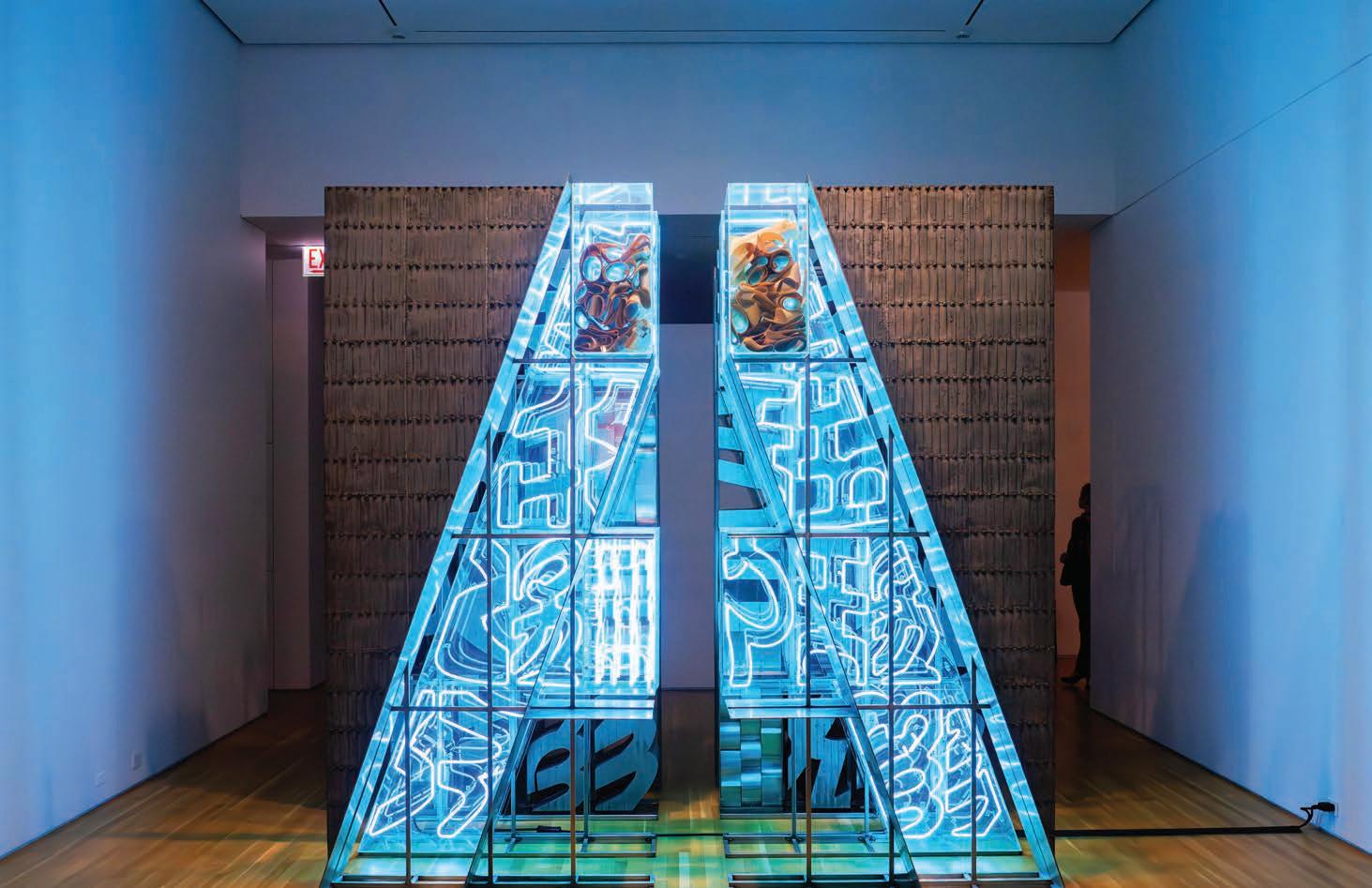

RALMA CREATES X PREP4TEENS
almachicago.org/almacreates prep 4teens.com
A new LGBTQ+ fellowship at ALMA encourages young Latinx artists through art advocacy.
By CRISTOBAL ALDAYFrom May 1 to June 16, a group of LGBTQ+ artists ages 17 to 24 gathered at workspaces online and in Pilsen to discuss sexual health, identity, art, and activism as part of a new LGBTQ+ youth fellowship. The ALMA Creates x PrEP4Teens fellowship, currently in its first year, was developed as a way to foster health-focused activism and community engagement through an art lens among queer Latinx youth. It’s led by David Gauna, a community advocate, artist, and board member for ALMA (Association of Latinos/as/xs Motivating Action) from 2016 through 2022.
ALMA has been a beacon of resiliency for the Latinx LGBTQ+ community since its inception in 1989. In the midst of the AIDS epidemic, the organization mobilized to provide culturally sensitive services, safe spaces, and advocacy for gay, bisexual, queer, and questioning Latino men. Over the years, ALMA evolved its mission to encompass the spectrum of the LGBTQ+ community, and it stands as one of the oldest and most impactful organizations of its kind in the midwest. Central to its mission is the belief in community engagement, policy reform, and the creation of inclusive spaces.
ALMA Creates is an innovative initiative formed in 2022 that aims to provide a space for Latinx queer youth to explore their identities and create meaningful art. PrEP4Teens, their partner in this project, is a health-care mobilization project officially launched in November 2023 to engage teens in sexual health awareness. For this iteration of ALMA Creates x PrEP4Teens, Gauna is leading a sixweek fellowship with six emerging artists: Eli Colon (he/him), Jocelyn M. (she/her), Addis Quiterio (they/them), Angel Campos (he/they), Xochitl Ramirez (she/her), and Allan Ayala (they/them). The fellowship with PrEP4Teens is the first such collaboration for ALMA Creates and the second ALMA Creates workshop (the first workshop was held in the spring of 2022), but ALMA “intends to make
imposing rigid guidelines, Gauna encouraged participants to create from a place of authenticity, reminding them that their Latinx identity is already an integral part of their art.
For Gauna, the fellowship and other youth development programming is not just about imparting knowledge but also about being open to new perspectives and evolving language within the queer community. “The way these young people own their identity through their

this an annual program from now on,” noted Gauna.
ALMA Creates x PrEP4Teens began with workshops on community advocacy, PrEP and HIV awareness, and community engagement, where fellows were encouraged to combine arts and activism. Participants were also asked to create artist statements and bios that connect with the prompt “Culture and Care: Embracing Self-Love and PrEP in the Latinx Community.” Weekly workshops emphasized the importance of self-care, decision-making, and accessibility in nurturing empowerment and well-being within the Latinx community, and coaching sessions o ered feedback to the fellows. This dialogue was designed to be a source of inspiration that would fuel participants’ creative endeavors and deepen their understanding of the connections between art, identity, and advocacy.
The power of individual interpretation and expression is also emphasized. Rather than
art and lives is something I was never able to do at their age,” he reflected.
Currently an After School Matters professional development specialist, a role he’s held since 2020, Gauna has an extensive background in activism and youth development work. After high school, he took on mentorship and community coordination roles and brought resources and opportunities to high school students. During this time, he discovered the transformative potential of art as a tool for self-exploration and social change. In 2016, he created Bloom through After School Matters, which ran until 2020 and became a sanctuary for more than 100 young Chicagoans in its four-year span.
“When I created youth programming in 2016, it was originally called Creative Action. It was an arts program that mentored youth in exploring their identity, building community, and learning about di erent social issues they were passionate about [like gentrification]
through art. I found myself using flowers and growth as metaphors in my teachings and mentoring, [concepts] that youth were able to absorb. Planting seeds in their mind, one was planted in me: Bloom.”
In Gauna’s vision, the fellowship at ALMA Creates is not just a program but a catalyst for transformation—a space where Latinx queer youth can bloom, thrive, and inspire others to do the same. As they continue on their journey of self-discovery and advocacy, they carry with them the seeds of change, sowing them in the fertile ground of their communities and paving the way for a brighter, more inclusive future. The hope is that young artists emerge from the fellowship feeling empowered to create their own communities and e ect change, both within themselves and in the world around them.
“Although there are beautiful spaces for queer youth across the city and spaces that may not be queer-focused but are accepting, there is no greater impact than a space made by queer Latinx youth, for queer Latinx youth, that celebrates their history, allows them to connect with those that have similar backgrounds, meet professional adults living their truth who they can relate to, and heal from cultural and/or society oppression that many of us have to navigate as we grow up, such as toxic machismo stereotypes,” Gauna said. As the fellowship progressed, participants were equipped with the support necessary to bring their projects to fruition, whether they were making a film exploring the accessibility of resources for the Latinx community or portraits celebrating acceptance and chosen family. The culmination of the fellowship was marked by a series of showcases and events in Logan Square and Uptown, where participants shared their work with community leaders and peers. Through these exchanges, fellows exhibited their artistic talents and developed techniques to amplify their voices as advocates for social change.
In a world where their spaces are disappearing, these young artists are reclaiming their narratives and asserting their presence. “That is why I am so passionate about using art to create space, even if temporary,” Gauna said. “I see ALMA Creates x PrEP4Teens as a seed for a pathway to real programming for queer Latinx youth, and these current [fellows] are articulating and demonstrating beautifully why it is so important.” v
m letters@chicagoreader.com
billcrisafi.com
instagram.com/billsafi
The artist mixes Western folklore and witchy aesthetics with a queer sensibility.
By CHARLIE KOLODZIEJWhen I caught up with Bill Crisafi in his Ravenswood studio, he was busy working on his latest creation, a dragged-up Pac-Man ghost costume for a Super Smash Bros.–themed bar crawl. “I had a martini when I was picking my character and so I thought it would just be funny to wear a bowl-cut pink wig with eyes on it,” Crisafi said. “A pink Pac-Man ghost if she was an extra in Showgirls.”
Complete with a sequined leotard, pink corset, and purse designed to look like a dead Pac-Man, this mash-up of ghostly and glamor, camp and macabre, is classic Crisafi.

The costume designer and illustrator has garnered a sizable Instagram following in recent years for his drawings that mix Western folklore and witchy aesthetics with a queer sensibility that can only be described as stupid fun. Jack-o’-lanterns in full gimp suits parade past toad familiars sipping martinis in Goldie Hawn–style glam. In Miss Phillip, Crisafi’s take on the satanic goat Black Phillip reclines in a red thong and stripper heels. “Sad but Hot,” says the caption. It’s as if Anjelica Huston, the Wicker Man, and the goat from The Witch all did poppers together.
“I feel like they’re all extensions of me in di erent ways,” Crisafi said about his bestiary of kinky creatures.
Crisafi often re-creates his illustrations



L to R: Crisafi among his creations; Crisafi ’s costumes, made from paper-mache, felted wool, and lots and lots of glue. Each costume resembles a high femme tarot card character come to life. CHEZPHOTO
through painstakingly crafted costumes. Made from paper-mache, felted wool, and lots and lots of glue, each one resembles a high femme tarot card character come to life.
His drawing Slutfor October is reimagined as a huge orange frog with a bra shaped like witches’ hats and black thigh-high boots. Another resembles the creature from the Black
Lagoon if she had Botox and lip fillers, complete with a long sequined gown.
“Costuming has given me something very similar to what drag gives a lot of people,”
continued from p. 21
Crisafi said. “It’s about accessing a power or a di erent energy that you may not have in your everyday life. So whether I’m doing an illustration or dressing up in a costume, it’s about becoming something else, or even a heightened version of yourself.”
cult to his childhood in eastern Massachusetts. “New England always feels haunted to me, which I know is a cliche, but it’s true,” Crisafi said. “All over the place, you can see things in decay or something being taken over by nature again. . . . It’s always felt a little magical.”
bubble dress.
For their second Peabody show, “Midsommar,” Crisafi and McLaughlin created a series of looks inspired by the eponymous Scandinavian summer solstice festival.
“Costuming has given me something very similar to what drag gives a lot of people.”
Crisafi grew up on a steady diet of magical movies that lean into camp aesthetics: Labyrinth , Hocus Pocus , and The Witches of Eastwick , to name a few. If a canon of queer Halloween films exists, these are certainly in the mix, and their influence can be seen in Crisafi’s signature blend of humor and horror.
He recalls frequent trips to the witch shops in Salem with his mother. Years later Crisafi would return to Salem to debut two shows at the Peabody Essex Museum with his partner and frequent collaborator Hogan McLaughlin. “Alchemical,” the duo’s first-ever show together, in October 2022, featured a series of
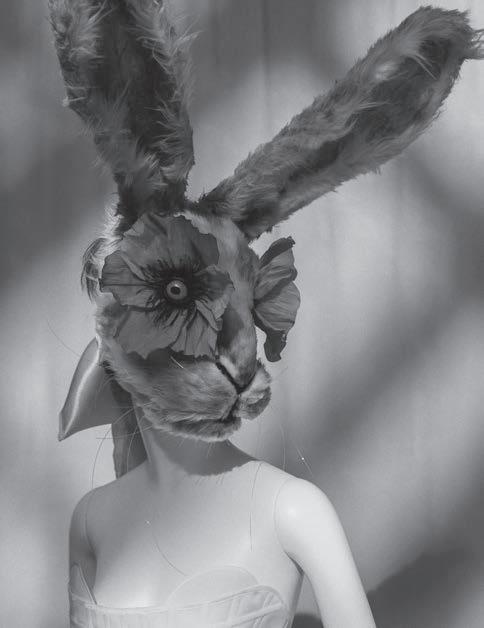
Crisafi believes this fascination with magic is shared by many in the LGBTQ+ community; there’s a reason Halloween is informally known by many as gay Christmas. “Queer people like identifying with the witches in movies. . . . I think it’s because they’re on the edge of society, but also kind of diva,” Crisafi said. “I’m obsessed with Ursula or Maleficent. A lot of the time they were queer-coded anyway.” The design for The Little Mermaid ’s Ursula was inspired by the legendary drag queen Divine, and Disney has a long history of queer-coding their villains.
Crisafi also attributes his interest in the oc-
The show featured a May queen, adorned in a veil and sculpted flowers, surrounded by her fairy attendants—anthropomorphized animals in di erent stages of magical transformation. “I like to think of them as these witches’ familiars shapeshifting into a human form, but there’s something o about it. Maybe they’re in between stages or kind of transforming into
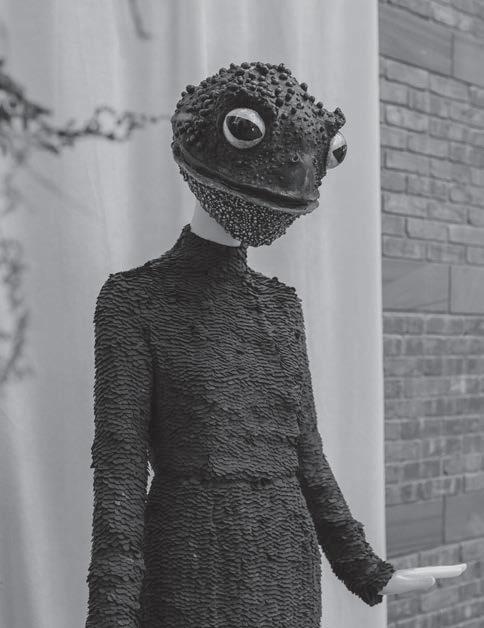
eight dresses designed by McLaughlin paired with masks by Crisafi. Each figure represented different stages in the medieval alchemical process for turning waste into gold.
The looks in the collection have a sort of puppetlike quality, as though they leaped from a stop-motion Tim Burton film. In one, two white peacocks protrude from a forehead of carefully laid feathers meant to signify the bright light of alchemical transformation. For another, a lion with a flowing green mane adorned with stars is paired with a black faille
‘Hårgalåten,’ in which the devil comes during midsommar in disguise and plays a fiddle,” Crisafi said. “The young people of the town cannot stop dancing to the music and eventually drop dead. It is discovered during the dance that the stranger with the fiddle has cloven hooves and is revealed to be Miss Thing incarnate hunty.”

something else,” Crisafi said.
“It’s about accessing a power or a different energy that you may not have in your everyday life.”
In one particularly striking mask, an orange face stares menacingly from beneath thin drag queenesque brows. A short goatee and beehive of ginger curls complete the look, an almost exact replica of one of the wigs from FelliniSatyricon, Crisafi said.
This particular look was designed to represent the Beltane flame, a midsummer festival tradition in which large wooden effigies are burned to ward off evil spirits. “They are also loosely based on the Swedish folk song,
Crisafi is currently working on another collaboration with McLaughlin scheduled for October 18, to be staged outdoors at the Seaport in Boston. Called “Play it by Fear,” the duo’s creations will accompany a candlelit concert by Boston’s Beacon Street Quartet.
In the meantime, Crisafi is looking forward to finishing their diva-fied Pac-Man ghost. If you’re lucky, you might see them haunting Ravenswood mid-bar crawl. Be warned, however, they might just put a spell on you. v
m
letters@chicagoreader.com







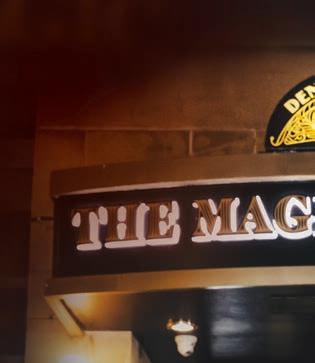





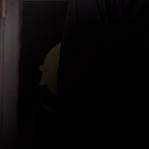

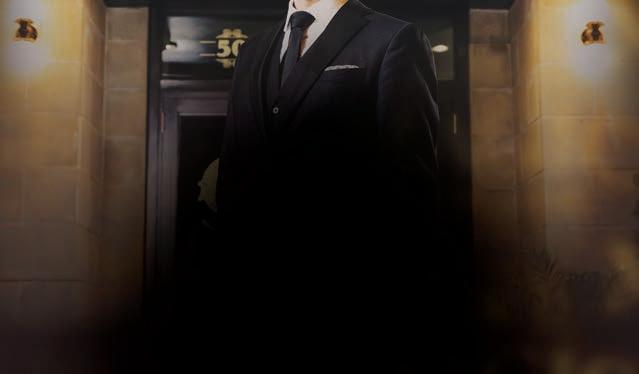














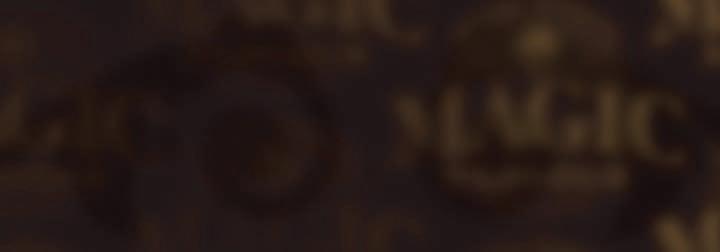


Through 6/22 : Sat-Sun 6/ 15 -6/ 16 3 PM, Thu 6/20 7 PM, Sat 6/22 2 and 5 PM; Den Theatre, 1331 N. Milwaukee, aboutfacetheatre.com/education/litplaylab2024, free (see website for complete schedule)
New voices help the LGBTQ+ company expand their reach.
By KERRY REIDAbout Face Theatre was founded in 1995—the year before the Defense of Marriage Act became federal law and the same year that the first HIV protease inhibitor was approved for prescription use. But the company’s focus has always gone beyond the issues defined by headlines as central to LGBTQ+ experience. As founding co-artistic director Kyle Hall observed, the company’s name reflected the desire for “a turning of the tide—changing perceptions and the direction of discourse by, of, and about queer lives and experiences.”
Hall and Eric Rosen established About Face’s profile early on by working with national artists like director-adapter Mary Zimmerman ( Eleven Rooms of Proust ) and Doug Wright and Moisés Kaufman. (The playwright and director duo sought About Face’s help with producing the earliest version of I Am My Own Wife , about German trans woman Charlotte von Mahlsdorf, prior to its New York run; the play went on to win the 2004 Pulitzer Prize for drama.) But over the years, the company has also centered voices that aren’t just white gay men.
through the tumultuous 2020 COVID-19 shutdown. As the company gears up for its 30th season, she reflects on where About Face has been and where it’s headed. “We were born out of this idea that LGBTQ+ lives weren’t reflected in a meaningful way onstage,” she says. “And back in the day, in the 90s, that
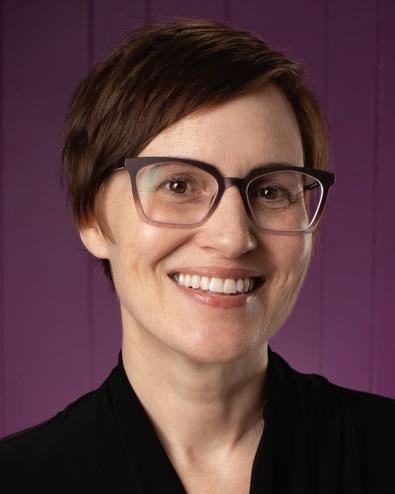
New work and adaptations have been a hallmark of the company through several artistic directors. (Bonnie Metzgar assumed the lead role in 2007 after Rosen and Hall departed, and Andrew Volkoff served as AD from 2013 to 2017.) But so has a commitment to youth and emerging artists. In 1998, About Face inaugurated About Face Youth Theatre (AFYT), a shifting ensemble of performers whose shows (a dozen created so far) reflected the many textures and challenges of the lives of queer young people, while also teaching young artists the tools for effective social justice activism.
Megan Carney has been About Face’s AD since Volko ’s departure and led the company
and that’s always been a special interest of mine,” says Carney. “I also think that we’ve really found a valuable role to play in Chicago in that regard because, as we all know, some of those important spaces for developing new work are no longer around.”
This month, About Face presents Lit Play Lab 2024: Hot Streaks, a new workshop and reading series conceived by Metzgar and presented in partnership with the University of Illinois Chicago. This Saturday and Sunday, you can see The Leads: A Queer Disassembly of a Very Straight, Critically Acclaimed Play (read: David Mamet’s Glengarry Glen Ross) by Jesse Morgan Young and Matthew Sherbach.
doing theater with us again.”
About Face, which Carney says operates currently on an annual budget of $650,000 (they’re also an Equity company), has limited its season to two full productions since returning to live performance in 2022. Carney attributes some of that to the desire to achieve greater pay equity. (ILesa Duncan, artistic director for Lifeline Theatre, made a similar observation about her company’s programming when I talked to her for this series earlier this year.)
“Centering pay equity really shifted what the budget looked like and where the resources could go in terms of shows,” says Carney. She further notes that About Face has four full-time staffers and a couple part-time employees alongside the paid members of the Green Room Collective. “We pay over a hundred artists who come through every year, who work on all the different kinds of projects that we have. So we really make that amount of money work in a very big way. We’re a pretty lean machine.”
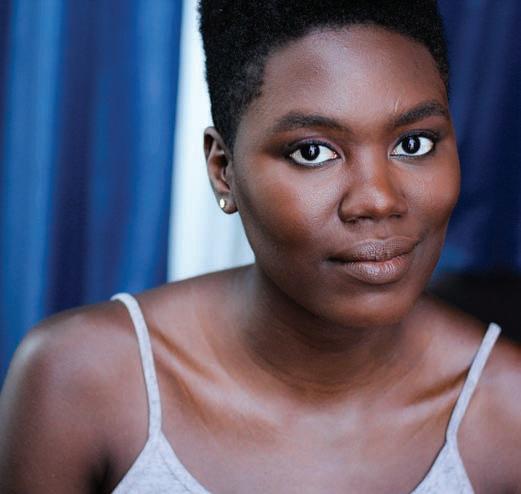
looked like being the butt of the joke or being the funny neighbor or always kind of being stereotyped.”
Before assuming the role of AD, Carney was the founding director of AFYT, which she notes was envisioned “as an onsite artmaking process with an intergenerational team of adult artists working with youth from all around the Chicagoland area.”
In 2021, About Face launched the Green Room Collective, which provides paid opportunities for early-career queer artists to learn the ropes of running a theater. In 2022, the company launched the Re/Generation Studio, a reading and workshop series for new work. (Lavender Men by Roger Q. Mason, which just finished a run with About Face, was in the first Re/Generation cohort.)
“We have been focusing a lot on new work,
Next Saturday, About Face’s education manager, Dionne Addai, unveils We Could Be: The Future of Sex Ed, created out of “true stories of Illinoisans of all ages” and designed to be a touring production. (Metzgar’s Jump the Shark and Nelson A. Rodriguez’s Estrellazo complete the lineup.)
Addai notes that the Youth Ensemble hasn’t produced a live show since prior to the shutdown. (They did produce the virtual show, Whodunnit? A Groovy Queer Murder Mystery, in 2021.) “What I’ve been excited about with creating this touring show is that hopefully it’s a way to get young people to work on telling their story and talking about how they would like to learn about sexual health education and gender identity and that kind of thing. And then I’m also hoping that as it goes to schools, we can get more young folks interested in
For Addai, the commitment to new work and intergenerational voices at About Face means they can help artists stretch in unexpected ways. “For me personally, I had the chance to come to About Face as an actor and writer. I got one of my first directing opportunities with About Face during the pandemic. And now I’m in this role which just kind of fits because I’ve been doing teaching-artist work along with acting for a long time. As a writer, I think [About Face] was probably the first time I took writing seriously.” Addai’s play Pangea was part of the online Kickback series, created by About Face’s former associate artistic director Mikael Burke, in 2021.
Addai also finds strength in the company’s continuing willingness to address all the letters of LGBTQ, along with other kinds of diversity. “We’re mixing all these di erent groups together and being like, ‘OK, maybe if this person doesn’t know everything about this experience, we’re gonna see if this person can kind of be the checks and balances.’ We want to make sure we’re figuring things out. There’s also a level of humbleness and understanding that we don’t know everything, either.” v
m kreid@chicagoreader.com
TRANSVENGENCE: PRIDE EDITION
Tue 6/ 18 7: 30 PM, Clash on Clark, 4416 N. Clark (second floor), guildcomplex.org, free
In our age of capital “P” Pride, words like euphoria, community, and progress are tossed around to the point of platitude. “All that shit is great, but that shit sells products. That’s the [artificial intelligence] algorithm bot,” says Joss Barton, creator of Transvengence, a quarterly poetry and performance showcase for trans artists. “Vengeance is hard to sell.”
Transvengence is, first and foremost, a night for trans people made by trans people. Held at rotating venues throughout the city, each showcase begins with a short opener from Barton, usually a joke or quick anecdote from her daily life. (Those that have seen Barton perform can attest: every word from her mouth has the air of an oracle delivering prophecy.) This is followed by a lineup of featured performers and an open mike where anyone, trans or cis, homo or hetero, can have a moment to speak their piece. The parameters for these performances are left intentionally ambiguous. People sing, do drag, read poetry, freestyle, and tell stories. The only real requirement is that you arrive ready to be real.
Barton created Transvengence after moving to Chicago from her hometown of Saint Louis in June of 2022. Eager to get involved in the city’s DIY poetry scene, she began performing at Exhibit B events run in partnership with the Guild Literary Complex (GLC), a literary arts organization that funds performance spaces centering historically marginalized voices. It was at one of these events that Barton met Guild executive director Andrea Change, who asked if she would be interested in curating a showcase of trans performers for the GLC’s Press Room series. A million ideas already bouncing around her head, Barton accepted Change’s offer and began putting together the groundwork for what would later become Transvengence.
Barton came up with the name “Transvengence” while on a DIY poetry tour with frequent collaborator Demian DinéYazhi’. During the tour’s last stop in New York City, the duo spent an afternoon at Jacob Riis Park—often called the “people’s beach,” Riis holds a
special place in the hearts of many queer and trans New Yorkers. Leaving Riis that day, Barton spotted some gra ti on one of the concrete barriers dividing the sand and the parking lot. Scrawled in thin red letters was the word “Transvengence.”

“I thought it was so fucking dope. It wasn’t spray paint, it was really thin lettering. It almost looked like blood was on the fucking wall!” says Barton. “So of course we took a million photos of us in front of it too, as queers do.”
This notion of Transvengence, or “trans revenge” as Barton sometimes calls it, bounced around in Barton’s head until it landed at the Guild Literary Complex’s door. “A lot of what I was writing, performing, and workshopping at the time had come out of a lot of anger I had right after the Colorado Springs gay bar shooting.” Barton is referring to the shooting at Club Q in which a gunman murdered five people and injured 19 others at an LGBTQ+ nightclub in 2022. The shooter later claimed in court filings that he identifies as nonbinary, seemingly to avoid being sentenced for the more serious charge of committing a bias-motivated crime.
“I was also very pissed about everything that had happened through the Trump presidency and very pissed about what felt like wasn’t happening under our current administration,” says Barton. “I was thinking, ‘What does vengeance look like for our community? Nothing’s working. So what do you do after that?’”
Each Transvengence event wraps with what Barton calls her “tranny Oprah moment,” a Q&A where she asks the performers, “What does Transvengence mean to you?”
For Barton, whose work sometimes waxes poetic about gunning down transphobes and
white nationalists, Transvengence is about creating an imaginative space where revolution becomes possible. “Taking that moment and stealing your imagination for just a brief second and making you imagine a form of trans retribution, to me that is Transvengence. It is working with the mind through, for me at least, the power of the word, through the power of performance, through the power of poetry.”
Transvengence also means not having to settle for a piecemeal vision of liberation. “I think one of the problems with the way we have been taught to seek liberation and freedom, is being told there’s an appropriate way to get it. If you don’t do it that way, you’re an extremist; don’t do it this way, you’re hurting the movement. . . . But the people that say that are themselves not imagining the true depth to which liberation can really go. . . . Like, why can’t we just ask for all of it? Why can’t we all be free? Why can’t we all be liberated from this bullshit?”
Last year’s Transvengence Pride showcase featured poet Noa Fields and one of Newcity’s Breakout Artists of the Year, Ava Mirage Wanbli. Resembling something between a drug peddler and a priest o ering Holy Communion, Fields performed a spoken-word piece in which she tempted the audience with a handful of free estrogen pills. Wanbli performed an original poem alongside projections from her multimedia work Sertraline Dolls, a video game where players encounter 3D scans of Wanbli’s body taken at various moments throughout her medical transition. These scans were projected around and sometimes over the top of Wanbli’s body, creating a virtual palimpsest of (un)gendered forms. “It was so punk rock,” says Barton.
Transvengence’s June 18 Pride event will feature performances by dancer and nightlife legend Lynzo the Heartthrob and storyteller and local doll-about-town Jack.
Barton is also Jack’s trans mother—or grandmother, depending on how you want to read the family tree. If it’s trite to say Transvengence builds community, then perhaps legacy is a better word. The pair met at Jack’s first Transvengence show in March 2023.
“It’s funny because basically I was brought to Transvengence by my, we’ll say my OG trans mom from Chicago, Eva, for whom Joss is like her trans mom. She was just like, ‘Let me bring you to this space of one of my friends,’ and that’s kind of how I was able to win another
mother, basically. I met her at the event and we just talked and the rest was history.”
Jack notes that Transvengence is often a space to celebrate younger trans women who may not otherwise have a platform to share their experiences. Jack is pointing here towards a tension that exists within the trans community—namely who gets to speak, where, and when. This conversation matters, since those with the loudest voices are often the ones shaping intercommunity perceptions of what it means to be trans.
“Some of the people that have the biggest platform right now are academics, trans academics, and a lot of the time their experience diverges from the vast majority of trans women’s experiences. And the same with people who come out later in life. Which includes a lot of people in the academy,” says Jack.
The June 18 event will fall shortly after Jack’s 25th birthday and only six weeks before she is scheduled to have bottom surgery, a confluence of life events she plans on channeling into her performance. “I am just talking about my life, and how I feel as a 25-year-old trans woman, and how I feel about going through this huge thing. Hopefully I’m sharing that with the audience in a way that is coherent, maybe a little humorous, and has some kind of greater meaning to it. Which is hard, because I’m trying to find a greater meaning in my life in general.”
Jack felt comfortable opening up about this private topic in part because the audience, as well as the performers, are also mostly trans or gender nonconforming. This helps alleviate the specter of cis-legibility, creating a vibe that feels instantly familiar, like meeting someone who shares your big three. (Jack is a Gemini sun, Scorpio moon, Aquarius rising.) “This space is not for big-name performers. It’s just for pretty much the local girls to get together and say what’s on their mind. So it’s also, I think, a great testament to the trans women community in Chicago,” says Jack. “Then the attendees, it’s all the people who fuck with us. It’s always been a very friendly space. It’s great to bring new people in but in the last couple of times it’s just like, ‘Oh, I know everyone here.’”
What does Transvengence mean to Jack? “I think the thing that comes to mind is trans women getting their lick back. I think it’s about getting the last word in, even just getting a word in and having this brief and small time to just say our life from our own mouths.” v
m letters@chicagoreader.com





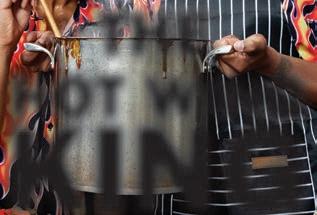




















Anne Carson’s Antigonick comes to life (and death) at Trap Door.
Antigonick, Anne Carson’s 2012 translation of Sophokles’s Antigone, is both heavy and light, with terse language hand-lettered in black and red caps, interleaved with illustrations by Bianca Stone on vellum. You see each image twice: blurred with the words on the next page peeping through like a palimpsest—then faded and reversed against a white page, like an unruly corpse imprinted upon the formal prism of a grave.
This reversal illustrates the central question of Antigonick: whether the law is human or divine, whether the burial of the dead is the obedience of nature’s order or the transgression of (a) man’s.
In Trap Door’s Trap Open Series production, directed by Anna Klos, hands pour leaves and feathers on a form surrounded by chalk marks, outlining not the body on the ground but measurements of another dimension. Antigone (Lolo Ramos) and her sister, Ismene (Tia Pinson), bicker about the interdicted interment of their brother Polyneices. Kreon (Sarah Wisterman), drunk on diction, demands (in dactyls): “Tell me who buried the body I said was unlawful to touch”—and the guard (Juliet Huneke) jumps to respond.
Wisterman’s Kreon has a seductive perversity, cleaving apart nouns and verbs to independent proclamations. But the universe is not so particulate—in the body of Antigone, alive and dead, condemned and holy, outlaw and lover merge in sister.
unrelated. Maybe she was murdered by shadowy figures, as a sound collage of voicemail messages suggests at the outset. Maybe she’s a terrorist. Maybe she’s a refugee from a Balkan-like war zone. Maybe she’s a car. (Crimp’s love of absurdism is underscored by the fact that he’s also translated Ionesco’s Rhinoceros and The Chairs). This is a play designed to make us confront our own expectations of what a narrative should be, and if opacity frustrates you, then this may not be your show. Or maybe it is. TUTA, which has always been neck and neck for me with Trap Door in bringing small-scale gritty intensity to productions of plays that are canonical in Europe, doesn’t disappoint here. This staging feels both physically claustrophobic and intellectually expansive. Tatiana Kahvegian’s appropriately generic setting (white sliding panels of vertical blinds and blood-red shag carpet) keeps us from identifying a specific world within the dialogue. Crimp’s script doesn’t specify who says what, leaving it up to each director.
But it’s never arid. Like Kane, Crimp’s forays into experimenting with dramatic form aren’t mere smartypants exercises. Nor do the more extreme details that
seats available at each performance. —KERRY REID ATTEMPTS ON HER LIFE Through 7/14: Thu-Sat 7:30 PM, Sun 3 PM; no performance Sat 6/15; TUTA Theatre, 4670 N. Manor, tutatheatre.com, suggested $20, $45, and $60 for reserved seats, pay what you can at door (pending availability)
Factory’s Die Hard 4 Your Luv combines boy bands with action films.
During a decade for Chicago theater that has largely felt like an endless in memoriam reel for retiring or shuttered companies, there’s something reassuring about Factory Theater—a company that’s very serious about not taking itself too seriously—crossing the incredible 100-productions milestone. Even more inspiring is that the 32-year-old company has managed to do so full-throatedly, in its own broadly comedic voice—wacky accents and all.
For the big hundo, Becca Holloway directs Kirk Pynchon and Mike Beyer’s new throwback 90s-set com-
applied to a lot of the bits here.
Like southern televangelists and infomercials, boy band and Hollywood phony archetypes are so perennial in sketch-style comedy that it can be hard to find a new take. It’s certainly possible to make new riffs on an old joke (one of the better television ensemble comedies right now, Girls5eva, does just that), but Beyer and Pynchon don’t veer outside well-trodden paths here. There’s even a clunkiness to the soundboard-comedy, on which Holloway’s production relies heavily.
And yet, as a hapless outcast, Wheaton-Werle makes for a rootable protagonist, and Brittany Ellis achieves some comedic pops as a drag queen-esque Russian villain. —DAN JAKES DIE HARD 4 YOUR LUV Through 7/13: Fri-Sat 8 PM, Sun 3 PM; also Thu 6/27 and 7/11 8 PM; accessibility performance Sun 6/23, understudy performance Sun 6/30; Factory Theater, 1623 W. Howard, 312-275-5757, thefactorytheater.com, $25
The Impostors find an attic of wonders in Footholds Vol. 5.
Blood runs. Yet when they carry it away, the body is uncannily light. The program-as-zine is a beautiful touch.
—IRENE
HSIAO ANTIGONICK Through 6/15: Fri-Sat 8 PM, Trap Door Theatre, 1655 W. Cortland, 773-384-0494, trapdoortheatre.com, $15
TUTA returns with Martin Crimp’s challenging Attempts on Her Life.
Martin Crimp’s 1997 play, Attempts on Her Life, won international acclaim. But Crimp, like fellow controversial 90s Brit playwright Sarah Kane, remains more talked about than seen onstage. So for that reason alone, it’s good to see TUTA return to live production for the first time since the 2020 shutdown with a revival of Crimp’s challenging but compelling piece.

An attic is a blank canvas for artistic expression and endless imagination in the Impostors Theatre Company’s Footholds Vol. 5. This is the fi h installment of the annual anthology series developed by ITC ensemble members as an opportunity for writers to construct and collaborate around a single limitation, or “foothold.” Seven different works from playwrights across Chicagoland, directed by ITC executive director Rachel Borgo and featuring several ITC ensemble members, make a show that takes place in an attic brimming with forgotten items. In each play, a unique cast of characters explore terror, humor, nostalgia, and heartbreak in the attic, a space which presents endless opportunities for discovery, connection, and return. The seven-person ensemble portrays a range of characters that include a vampire hunter in training; a pair of sentimental adult siblings; a grieving spouse with a mild-mannered ghost; and a group of friends encountering the end of the world. Each performer succeeds in finding humanity in even the silliest and most dubious circumstances, while consistently breathing new life and perspective into the attic with each passing story.
Directed by Aileen Wen McGroddy, TUTA’s production features six fluid and tensile performers who all mesh well in telling the story of Anne (or Annie, or Anya, or Annushka), through 17 scenes that are mostly
emerge in Attempts on Her Life exist simply to titillate. At points, I was reminded of Caryl Churchill’s examination of authoritarianism and nihilism, Far Away. At other times, I felt like I was watching an embodiment of an exquisite corpse. I can’t say I understood everything. But I was never bored watching TUTA’s show, and given that I can’t remember the last time anyone produced Crimp’s work in Chicago, those who are already fans or merely curious should hurry to get tickets—there are only 24
edy, Die Hard 4 Your Luv, about a TRL-topping musical foursome (Matt Chester, Chase Wheaton-Werle, Jeffrey David Thomas, Liam Ryan) stumbling into a life-or-death high-rise plot for Y2K codes. Above Fred Durst’s New Year’s Eve party, no less.
Is this particular collection of jokes my cup of SoBe Elixir? Not really. Or at least some are the first time, but the trouble with Die Hard is that the phrase, “It was pretty funny the first time” is something that can be
As a matter of preference and sensibility, individual audience members might feel drawn to or moved by some characters and their circumstances more than others. But those who can catch Footholds in its brief run can find something that speaks to them among the well-realized hijinks, horror, and magical realism. —KATIE POWERS FOOTHOLDS VOL. 5 Through 6/15: Thu-Sat 7 PM, the Edge Off Broadway, 1133 W. Catalpa, theimpostorstheatre. com, $20 general admission, $25 reserved

Strawdog’s The Importance of Being Earnest offers goofy delight.
If you’ve ever imagined how Oscar Wilde would fare in contemporary queer Chicago life, look no further than Strawdog Theatre’s sparkling and delightful adaptation of The Importance of Being Earnest by Dusty Brown and Elizabeth Swanson, directed by Swanson.
Brown and Swanson get around some of the stumbling blocks for Wilde in the 21st century with economy and grace. Johnard Washington’s Jack Worthing may not have to give his legal consent for Andi Muriel’s Cecily (to whom he has been a “guncle” for most of her sheltered life in Saugatuck) to marry Jack Seijo’s Algernon. But he can control her Vanguard trust fund.
Invictus’s Three Sisters embodies Chekhov’s wounded souls.
“Any idiot can face a crisis,” Russian playwright Anton Chekhov wrote in one of his cheerier moods. “It’s this day-to-day living that wears you out.” Actually, the quote may belong to another dour playwright, Clifford Odets, but that hardly matters here. I can’t think of a line that better sums up the major theme of Chekhov’s gorgeous, glorious, relentless masterpiece, Three Sisters, in which four talented, well-educated, upper-middle-class siblings (three daughters and a spoiled son) in tsarist Russia (circa 1900) are worn down by the boredom and mundane disappointments of everyday life.
This description makes the play seem grueling, but the play is, for those with a taste for (and the patience for) full-strength Chekovian drama—three hours of




Kade Cox’s Gwendolen, admittedly, seems like the kind of club vixen who wouldn’t let anyone hold her back, but gay daddy Augustus Bracknell (Michael Reyes) still exerts influence, financial and otherwise.
Studded with references to pop culture (RuPaul’s Drag Race comes up as part of Bracknell’s marriage test for Jack) and Chicago gay hangouts (“He always wants to go to Big Chicks. What am I—45?”), the show at times feels like gay bingo. I mean that in the best possible way. Brown and Swanson understand that the specificity here isn’t just about in-jokes (though they abound and are quite funny), but in creating a believable framework for the celebration of silliness-as-revolution that Wilde endorsed. The ensemble (which also includes Matt Keeley’s coy manservant, Lynne Baker’s Mrs. Roper-esque Miss Prism, and Crystal Claros’s dotty Dr. Chasuble) digs into this update with relish and good-natured glee, and it all goes down like a fizzy champagne cocktail on a warm summer day.
—KERRY REID THE IMPORTANCE OF BEING EARNEST Through 6/30: Thu-Sat 7:30 PM, Sun 3 PM; Rivendell Theatre, 5779 N. Ridge, strawdog. org, free with advance reservations (donations encouraged)
closely observed provincial life, packed with heartbreak, thwarted ambitions, tiny moments of quiet desperation—very moving indeed.
Especially when it is being done by a theater company like Invictus, a company that knows how to keep a play with as many characters, and stage moments, as this one moving briskly all the way to its shattering end. Director Charles Askenaizer pulled off a similar feat a year ago, with their intense revival of Arthur Miller’s The Crucible. As in that production, the performances are universally first-rate (because the casting is pitch-perfect). You couldn’t ask for better actors at the center of the drama than Katherine Schwartz, Maria Stephens, and Ellie Duffey. Each of them embodies in every glance and gesture the essence of Chekhov’s wounded souls. Duffey, in particular, is incandescent as the youngest, Irina. Watching her be ground down over the course of the play—she begins as an energetic naif and ends as just another emotionally scarred wretch—is utterly heartbreaking. And very Chekhovian. —JACK HELBIG THREE SISTERS Mon and Fri 7 PM, Sat 2 and 7 PM, Sun 2 PM; also Wed 7/3 7 PM, no show Fri 7/5;
City
3014 W. Irving Park,
In the 1960s, Chicago was home to the country’s first fetish clothing store. The groundbreaking business later became a leading purveyor of BDSM erotica during the Golden Age of Bondage.
By MICCO CAPORALEFirst, there was the Golden Age of Porno. From roughly 1969 to 1984, adult entertainment gained wider mainstream approval and enjoyed lucrative capital before home video arrived and reshaped portraying and consuming sex onscreen.
Then: there was the Golden Age of Bondage. At that time, fetish media was not as easy to make and distribute by independent and “amateur” creators as vanilla porn, so from roughly the mid-1970s through the late 1990s, kinky movies and magazines enjoyed some porno chic treatment—more investment, glossier magazines, and wider reception. The Golden Age of Bondage had three major production companies: Harmony Communications (also known as Harmony Concepts), California Star, and House of Milan. But before House of Milan became a powerful woman-owned publishing empire run out of southern California, it started as a boutique clothing store operated by two friends in downtown Chicago called Futura Fashions.
In the fall of 1964, Futura Fashions opened in a high-level suite at 162 N. State. It was the country’s first explicitly fetish boutique. There had been several overseas, especially in France, which had stores like Diana Slip and Yva Richard—the latter of which popularized the studded steel cone bra. Domestically, many makers supplemented their income with secret lists of fetish clientele, like costumers who worked with theater and circus performers, as well as manufacturers of items such as boots and heels, dog clothing and accessories, and horse riding gear (saddles, riding crops, and such). But until Futura Fashions, there was no place in the United States to reliably procure play items, publications, and outfits specific to the tastes of people who enjoyed power play and how certain props, fabrics, cuts, or silhouettes could shape it.
Even though the business operated aboveground in a neighborhood of penny arcades, tattoo shops, strip clubs, and adult bookstores, it was still quite taboo. Fetish was the strangest of the unusual, so Futura Fashions was only advertised within very niche circles and operated mostly as a mail-order business. There’s not a ton known about its history, except that it was founded by a man named Yogi Klein and a woman named Barbara Behr, who went by “Ms. B” at the time. How or why they met is unclear. According to an interview with adult filmmaker Janus Rainer logged at the Leather Archives & Museum, Klein and Behr were married, but this remains otherwise unsubstantiated. In 1969, the store closed, and in 1970, Behr took over the remnants and relocated the operation to California, where she built it into House of Milan.
But none of this would have been possible without Klein. Klein was the cousin of Leonard “Lenny” Burtman, a New York–based fetish photographer who built the first nationwide fetish publication distribution network called Burmel Publishing Company. Among his titles were Masque , Exotique , and Bizarre Life , which capitalized on the namesake of the popular 1940s publication Bizarre magazine.
Sometime in the late 1950s or early 1960s, Burtman released a publication called The Bizarre Costume Catalog , advertising “footwear, lingerie, costumes, & accessories for theatrical, masquerade, and impersonation.” In theory, all the clothes were for sale, but they were exorbitantly priced—because the real goal for Burtman was to get people to buy the catalog, not the clothes. Positioning the publication as a clothing catalog was a way to get wider distribution for what was niche porn, similar to how physique magazines posed as bodybuilding lifestyle publications. Klein had the opposite goal of Burtman: he wanted to sell clothes more than magazines, and he used the Catalog as bait. According
to Robert V. Bienvenu II’s The Development of Sadomasochism as a Cultural Style in the Twentieth-Century United States, just before opening Futura Fashions, Klein bought a few hundred of Burtman’s back stock of The Bizarre Costume Catalog . At the bottom of the back cover was unused white space where Klein stamped “House of Milan” (the exact origin and purpose of this phrase in this context is unknown) with a logo and Futura Fashions’s address.
The store enjoyed a five-year run. Why it closed is unclear. Most likely, selling publications and toys was still more lucrative than selling explicitly fetish gear, clothing, and lingerie. It’s possible too that Klein and Behr were married and then divorced, prompting their separation. What’s certain is, after the store closed, Klein stayed in the greater Chicago area while Behr moved to southern Califor-

nia. If she’d wanted to continue the operation as a clothier, New York would have made more sense; at that time, it was the cultural leader for developing a uniquely American sense of fetish fashion. But making porno magazines and movies—that was happening in and around Los Angeles.
Once in southern California, Behr took the skills and knowledge she gained running Futura Fashions and built the publication side of that business into one of the most influential
suppliers and distributors of BDSM-oriented erotica. House of Milan was a mail-order business that produced three to four publications a month and distributed up to 30 similar titles, eventually expanding from books and magazines into home videos. Some of the operation’s best-known titles are Bound to Please , Knotty, and Hogtie
What’s perhaps most noteworthy about the operation is how many women were involved. Behr was very hands-on about soliciting and editing stories, responding to reader letters, hiring photographers, and organizing shoots. Much of the mastheads are populated with women’s names, and most of the images depicted are women alone or together. Only occasionally were men involved in production or photos. Of course, it’s easy to assume images catered to a straight male fantasy—and many of Behr’s letters from the editor speak to bondage, submission, and sadomasochism as acts best practiced between a husband and wife. In a passage she often recycled, Behr wrote, “Bound to Please magazine is for the bondage enthusiast who loves his/her wife/husband.” But framing the contents of the magazine this way added a veneer of respectability that helped the material better fly under the radar and reach a wider audience while still o ering plenty that was made for—and likely made by—lesbians. There are many nuanced clues in the photos and writing of such publications that suggest this, especially in House of Milan’s earliest releases. In 1987, Behr was a judge at the inaugural International Ms. Leather (IMsL), the feminine counterpart to Chicago’s International Mr. Leather. While one does not have to be gay to participate in either contest, both events center the gay community, and the first IMsL winner—Judy Tallwing McCarthey—as well as many of Behr’s fellow judges were out leatherdykes. Whether Behr herself was a leatherdyke is unclear, but she was undoubtedly in community with them. Unfortunately, the Reader could not find anyone who remembers her.
By the mid-1980s, Behr sold her stake in House of Milan. She spent some time working for one of the competing bondage distributors, California Star, before joining a fetish clothing company and dying in the mid-1990s. California records indicate she never married or had children. Her only legacy is being one of the greatest BDSM porn purveyors of the 20th century—and that’s something to truly be proud of. v
m

Thirty years after its initial premiere, Go Fish proves that the more things change, the more they stay the same. Whether it’s recurring conversations in queer circles or existing in familiar Chicago locations, life goes on much as it did in the version of 1994 presented in the film—which is exactly why Go Fish has remained an enduring classic of both the queer canon and independent Chicago cinema.
In the early 1990s, Go Fish writer-actor Guinevere Turner and writer-director Rose Troche met at ACT UP (AIDS Coalition to Unleash Power) meetings in Chicago and quickly became both romantic and creative partners. (By the time they were finishing up shooting on Go Fish , they were in the middle of their breakup.) After working on some projects for ACT UP, the pair turned their attention to creating something for themselves and the other lesbians they knew. In a Frameline interview for the film’s 20th anniversary a decade ago,
Turner says a lesbian club scene in the late Blake Edwards film Switch (1991) lit a fire in her to create something that accurately portrayed lesbian life.
She and Troche began to develop Go Fish as a short romantic comedy about Ely (V.S. Brodie) and Max (Turner) that would paint an honest picture of what a lesbian romance might look like near the end of the 20th century. The film soon expanded to a feature, allowing for more discursive and didactic scenes. And Go Fish is honest about its pedagogical position from the start: It opens with a classroom naming possible lesbians from pop culture and history. When one student asks the point of the exercise, professor Kia (T. Wendy McMillan) explains, “Lesbian lives and lesbian relationships . . . barely exist on paper, and it’s with that in mind, and understanding the meaning and the power of history, that we begin to want to change history.”
That line functions as a thesis statement for the film, which goes on to include various
There are the sprawling multibedroom apartments that anyone who’s lived here with roommates will be familiar with. A key scene takes place in zine and comix shop Quimby’s (formerly Quimby’s Queer Store), a queer- and punk-friendly space in Wicker Park with singularly stocked shelves, that’s easily spotted by viewers who have been to the store—even though it moved from Damen to North Avenue in 1997. A musical montage sees Kia walk down a well-gra tied Milwaukee, Max walk out of the sadly now-shuttered but fondly remembered novelty shop Uncle Fun in Lakeview, and Daria set up the bar in Wicker Park’s Gold Star Bar. Images intercut with the closing credits show Max and Ely’s burgeoning relationship as the two wait for the el at the Belmont platform and take walks in Lincoln Park in front of the downtown skyline.
discussions about lesbian and queer culture more broadly, many of which remain the same today or have evolved but never ended. After seeing a movie, Ely and Max disagree about the responsibility of queer filmmakers to represent the community, with Ely saying that’s too much to ask of any individual artist, and Max bemoaning the “negative representation from within our own ranks.” In a different debate, Kia asks, “What would you rather our collective lesbian image be? Hot, passionate, say-yes-to-sex dykes or touchy-feely, softfocus sisters of the woodlands?”
In one of the most memorable scenes, Daria (Anastasia Sharp), the Casanova of the film, is kidnapped after sleeping with a man and dragged before what can only be described as a lesbian identity tribunal. The group litigates whether or not Daria can call herself a lesbian if she slept with a man; the back-and-forth digs deep on the topic without espousing a definitive stance.
Then there are the lighter chats about the di culty of finding a sexy but not vulgar word for vagina (“honeypot” ends up on top by default), and “this nonmonogamy, hip thing” (which has only become more hip in the intervening decades).
These dialogues occur indoors and outdoors in spaces many Chicagoans will recognize.
Go Fish is a distinctly Chicago movie through and through, which makes its victories as an independent film meaningful to the community of indie filmmakers in the city as well as the queer community. Go Fish made history when it became the first film bought during the Sundance Film Festival and shockingly went on to make around $2.5 million at the global box o ce. That success inspired more lesbian artists to create their own films and made distributors interested in those films. Filmmaker Angela Robinson, whose movie D.E.B.S. (2004) about a straitlaced teen girl superspy falling for a bad girl supervillain is a lesbian camp classic, told NBC Out earlier this year that Go Fish was “earth-shattering” in its impact.
Many of the films that followed centered on teenagers, like high school rom-com The Incredibly True Adventure of Two Girls in Love (1995), grimy coming-of-age drama All Over Me (1997), and conversion therapy satire But I’m A Cheerleader (1999). Others, like When Night is Falling (1995) and High Art (1998), explore what happens when adult women’s ostensible heterosexual bliss is challenged by strange and alluring lesbians. In 1996, Chicagoborn filmmakers Lilly and Lana Wachowski made their feature film debut with Bound (1996), a lesbian neo-noir that’s remarkable for prefiguring intimacy coordinators on set by employing lesbian sex expert Susie Bright to choreograph sex scenes.
Like many of those movies, Turner and Troche’s work following Go Fish has only sometimes crossed into the mainstream while making a significant impact on the world of queer entertainment. If only that world were better funded, they might both be household names in every demographic by now.
Both worked on The L Word alongside Laurel Holloman and Leisha Hailey, stars of The Incredibly True Adventure of Two Girls in Love and All Over Me. The show, which later brought on Robinson and But I’m a Cheerleader writer-director Jamie Babbit, became a hub of lesbian creatives over its initial six-season run from 2004 to 2009. Today, the series has seen one reboot/sequel come and go (the three-season The L Word: Generation Q) with another in development (The L Word: New York).
In 2000, Turner began a recurring creative partnership with director Mary Harron when the two cowrote the adaptation of American Psycho, a film that’s likely the most familiar to general audiences precisely because its queerness isn’t explicit. More recently, Turner wrote an essay that then developed into a book about her experiences growing up in the Lyman Family cult. Troche followed Go Fish with Bedrooms and Hallways (1998), a film about gay men starring Simon Callow, Kevin McKidd, and Hugo Weaving; and The Safety of Objects (2001), based on the short story collection of the same name by A.M. Homes, before turning to television. On TV, she’s directed episodes of all kinds of shows, including Vida, a show
featuring Latine queer characters (Troche is Puerto Rican).
It remains inspiring that a group of Chicago lesbians, brought together by activism and flyers, with $15,000 and equipment borrowed from several universities around town, changed history.
Troche and Turner have also played major roles in other artists’ careers. When Kevin Smith saw Go Fish, he was inspired to make Chasing Amy (1997), a film about a lesbian who begins dating a man, which continues to divide the queer community despite Turner’s seal of approval in the form of a cameo. In 1996, Turner costarred in Cheryl Dunye’s masterpiece The Watermelon Woman, which deftly combines an interracial lesbian rom-com with an investigation into a fictional Black lesbian actress of the Classical Hollywood era. Troche and her casting department also arguably altered the course of Hollywood’s future when they cast ten-year-old Kristen Stewart in her first speaking role as tomboy Sam in The Safety of Objects. It’s almost impossible to quantify the impact of Go Fish on the landscape of queer entertainment. And 30 years later, it remains inspiring that a group of Chicago lesbians, brought together by activism and flyers, with $15,000 and equipment borrowed from several universities around town, changed history. v
m letters@chicagoreader.com




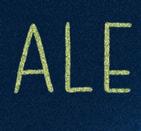





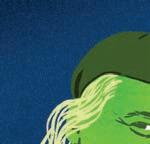
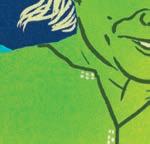


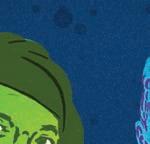



clinical social

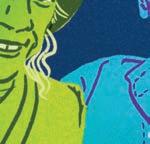


met in 2012 while working at Chicago House and crossing paths

organizing. Initially connecting through butting heads and challenging one another’s ideas, they’ve developed a great fondness and mutual respect for one another and lovingly describe each other as best of friends and chosen family.






Book by TAYLOR MAC
Music and Lyrics by JASON ROBERT BROWN Choreography by TANYA BIRL - TORRES
Directed by ROB ASHFORD
Based on the New York Times Best-Selling Book by JOHN BERENDT

Acclaimed author John Berendt’s iconic New York Times best seller becomes a seductive new musical.
Southern charm is bountiful in Savannah, Georgia. But behind polite smiles, the eccentric residents are filled with secrets and motives. When wealthy antiques dealer Jim Williams is accused of murder, the sensational trial uncovers hidden truths and exposes the fine line between good and evil – which sparks Lady Chablis and other Savannahians to change the city forever. MacArthur “Genius” grantee Taylor Mac, Tony Award winners Jason Robert Brown and Rob Ashford, and choreographer Tanya Birl-Torres bring the true-crime blockbuster book and its beloved characters to life in a new musical adaptation. JUNE 25 - AUGUST 4

Join us for Pride Night OUT on June 25th! Save 25% on tickets, have a drink on us and celebrate Pride at the Goodman before our first performance. Learn more at GoodmanTheatre.org/Pride
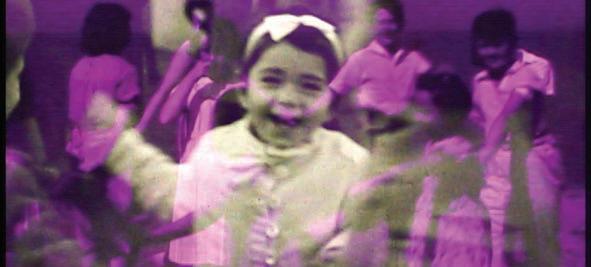



Since 2012, the Chicago Film Archives (CFA) has hosted a yearly media mixer in which three local visual artists and three musicians are paired to create a short work with archival footage. I’ve written about CFA and its myriad offerings (even awarding the Media Mixer a Reader Best of Chicago distinction in 2023 for being the “Best annual collaboration between local filmmakers and musicians”), but for those unfamiliar with the organization, it’s a regional archive dedicated to “identifying, collecting, preserving and providing access to films that represent the Midwest,” per their website.
As the midwest is often relegated to flyover territory, it’s refreshing to be able to support an archive whose mission is to safeguard that which may have otherwise been similarly relegated to its original ephemerality. The Media Mixer doesn’t just exhibit the archive but breathes new life into the material—the collaborations between visual artists and musicians also become collaborations with the original material and its makers, be they families’ recordings of both special and everyday moments; cinematic visions brought to life by amateur filmmakers; or sponsored films such as advertisements, educational films, industrial films, and the like.
Some editions of the Media Mixer take a specific direction, like when several years ago, U.S.-based filmmakers were paired with Italian musicians and Italy-based filmmakers were paired with Chicago-based musicians. This year, the visual artists and musicians were assigned a specific collection within the archive and set to work directly with family members connected to them. “Homemade,” it was called; the videos screened last Thursday at Constellation, with artists and family members adjacent to the collection present to discuss the pieces afterward.
Filmmaker Henry Hanson and musician Fire-Toolz worked with the Lieb-Hootnick Family Collection to create Happy Birthday Happy American , which radically explored


immigrant assimilation through an Americana aesthetic, the epitome of which is Polish emigrant Harry Hootnick’s young daughter singing patriotic songs on the Fourth of July, which also happened to be her birthday. A family member present remarked on how they were talking about something they couldn’t have even imagined when the movies were made. It’s an extraordinary thought, really, this public alchemizing of once-private keepsakes.
Kioto Aoki and A.J. McClenon—visual artist and musician, respectively—made Frank, from the Frank Miyamoto Collection. It’s a portrait of an archivist, a document of the documenter; it illuminates Uncle Frank himself by way of his own footage. The family contributed new rough-hewn drawings to help illustrate aspects of their family and Frank’s lives. McClenon’s accompaniment was similarly unpurified, that being the beauty of it; like the documentation of one’s life, it felt intuitive and innate.
Lastly, Kiss the Rest , made by filmmaker Caitlin Ryan and musician Johanna Brock with footage from the Glick-Berolzheimer Collection, is a haunting memory play made even more poignant by the family’s recent loss of a beloved wife and mother. Brock’s operatic performance was an uncanny complement to Ryan’s wistful abstractions. In one part, the woman who’d recently passed is seen waving; her daughter fought back tears and thanked the duo for having included it in the piece. This was otherwise a low-key week. I watched several Georges Méliès shorts soon to expire from the Criterion Channel and reviewed the new restoration of Rose Troche’s 1994 lesbian classic Go Fish for Cine-File, which hopefully some readers were able to catch at the Gene Siskel Film Center this week. Until next time, moviegoers. —KAT SACHS v
The Moviegoer is the diary of a local film bu , collecting the best of what Chicago’s independent and underground film scene has to o er.
Get showtimes and see reviews of everything playing this week at chicagoreader.com/movies
Once in a blue moon, a performer comes along who is so charismatic that it’s impossible to see them as anything other than a star. In her breakout role as Kayla, the hilariously chaotic talent assistant in HBO’s Hacks, Megan Stalter is one of those people.
Her career began in Chicago, where she would use her nannying paycheck to cover classes at the Second City and Annoyance Theatre. Now, Stalter transforms from a scene-stealing supporting character into a fullfledged leading lady in Cora Bora, which premiered at the SXSW Narrative Spotlight in 2023.
In this dramedy directed by Hannah Pearl Utt, Cora is determined to fix an ever-growing list of problems. With her music career floundering, she flies home unannounced, hoping to salvage her open relationship with her long-distance girlfriend, Justine. However, upon arrival, she realizes she’s actually an intruder in Justine and her new girlfriend’s domestic bliss. With the same swagger and blind conviction as Kayla from Hacks, Cora is challenged to address the bigger picture on a journey of self-discovery, redemption, and a series of social faux pas.
and his cra smanship is impeccable. If the thought of spending 100 minutes contemplating the precious irony and the ironic preciousness of friendship and life is what you’re looking for, Robot Dreams is unmatchable. If that all sounds too sugary to stand . . . well, yeah, you’d probably best stay away. —NOAH BERLATSKY 102 min. Gene Siskel Film Center, limited release in theaters
It feels unfair to judge director Ishana Night Shyamalan’s debut feature against the famous achievements of her father, M. Night Shyamalan. But from the first 20 minutes, The Watchers decisively declares itself part of
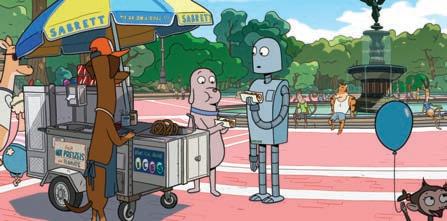

The moments in which Cora’s self-assured facade slips bring richness and depth to the film; Stalter seamlessly weaves humor and sincerity, never so ening her distinct comedic voice but grounding the character in reality with moments of heartbreaking vulnerability. —KYLIE BOLTER 92 min. Limited release in theaters
Pablo Berger’s Robot Dreams is imaginative, bittersweet, and unrelentingly, almost unbearably, twee. Based on a graphic novel by Sara Varon, it’s set in a funny animal version of 1984 New York, where a friendless, hapless, but lovable Dog decides to purchase a Robot friend to chase away his loneliness. The two embark on a montage of buddy activities set (somewhat inevitably) to Earth, Wind & Fire’s “September,” until Robot rusts into motionlessness at Ocean Beach on the last day of summer, and Dog can’t figure out how to retrieve him till the following year. (We mentioned Dog was hapless, right?) The two spend months pursuing separate adventures—immobile dreams of dancing flowers and a friendship with some birds for Robot; an almost romance with Duck for Dog—their joys touched by the melancholy of loss, their sorrows touched by the joy of remembered good times. The animation is consistently and insistently inventive, the tone steadfastly whimsical, the happy ending repeatedly offered and whisked away in an ever-escalating twanging of nostalgia and heartstrings. Berger has a real, deep love of New York City and its diverse inhabitants (real and fictional),
the Shyamalan brand. The film is at its strongest when it adheres to some of M. Night’s hallmarks—namely, a fast-paced first act and an intriguing concept. The titular Watchers are a mysterious race of creatures whose entire purpose for keeping their human “pets” is, seemingly, to watch them. Mina (Dakota Fanning) finds her depressive life upended when her car breaks down in the middle of a forest and she is thrown in with a band of humans who show her how to survive by putting herself on display for the unseen Watchers. Protected behind a two-way mirror in an incongruous research station, the humans dance, eat, and watch TV, all for the Watchers to study. “We fascinate them,” the magnificently creepy Madeline (Olwen Fouéré) tells Mina.
The film starts to stumble when it clarifies the Watchers’ motives and identities. M. Night’s strongest films, like The Village and The Sixth Sense, have the simplest premises and the least amount of onscreen time for the “monsters.” His weakest, like Signs, buckle under the weight of their own complicated—or just plain silly—lore. The Watchers, a er a promising start, unfortunately falls into this same trap. The frightening mystery of what exactly the Watchers are and why they’re fascinated by humans has a disappointingly elaborate answer, which the film clumsily belabors in its final act. This is, perhaps, the result of a too-faithful adaptation from the source novel by A.M. Shine. In all, The Watchers has its good points, most of which can be found in its first hour, before the (quite obvious) trademark Shyamalan “twist.” Ishana may well have a shining career in horror ahead of her—if she can escape the narrative sins of her father. —COLLEEN MORRISSEY PG-13, 102 min. Wide release in theaters v




For transmasculine singers, the choice to undergo hormone replacement therapy is rarely a simple one.
By DMB (DEBBIE-MARIE BROWN)The first time I started testosterone, I stayed on it for three months. The 2022 edition of my four-piece band was only a few months old. After I was done fishing around online for “street ’mones” that spring, a transmasculine homie gave me several months of T gel as a gift to begin my own transition. T gel causes physical changes at a much slower rate than intramuscular testosterone injections, but I wasn’t ready even for that. I was terrified of what my family would think; I was scared of transphobic social repercussions if I were visibly trans or even visibly a man. I wanted specific changes (body hair, bottom growth, increased muscle mass) and not others (deepening voice, acne, potential balding), but with hormone therapy you can’t pick and choose. My internalized transphobia told me that having a beard and breasts at the same time (even if only briefly) would be ugly. And I wasn’t ready to lose my alto singing voice—testosterone treatment thickens the vocal cords of people assigned female at birth, and it can drop your pitch by octaves. I returned to the boy juice a year later because I’d gotten frustrated with constantly being misgendered. After I got sober in summer 2023, I dug my heels into my gender—I’m a nonbinary trans man—and resumed daily applications of the T gel that I’d abandoned in my bathroom cabinet. It was exhilarating; even without immediate results, each application a rmed to me that I was not a girl.
I went to my family home for a few weeks during that time, and I remember applying the gel in secrecy, carefully discarding the empty bottles out of my parents’ sight. Before the season was over, I was leaving Planned Parent-
nor Ratsula had used intensive testosterone treatment. They’d made gender-affirming bodily changes (including the development of facial hair) via top surgery, weight lifting, and other nonhormonal methods.
I actually didn’t know of a single transmasculine singer with an unchanged singing voice, and that realization threw me into a depression. My identity as a singer is as strong as my identity as a nonbinary man, and I don’t have faith I could relearn to use my voice after a second puberty. I’m also recording my first album this summer. In what world does it make
arrive at a more thorough understanding of the stakes.
Here’s how that’s going.
When I reach gender-nonconforming singer Dreamer Isioma for our video interview, he’s working on his next album, staring at 70 instrumental stems in the interface of a digital audio workstation. A soprano-alto singer who uses they and he pronouns, Isioma earned a gold record for the 2020 song “Sensitive,” but the plaque is sitting in a box in a corner of their bedroom. In October 2023, he joined Janelle Monae’s The Age of Pleasure tour for six dates. Isioma says he “dabbles” in testosterone—he has some on hand but hasn’t used it regularly or seriously. They want to make sure they’re taking it because they want to, not because they feel like they’re supposed to.

hood at Division and La Salle with six months’ worth of testosterone vials and syringes.
My transition fears had mostly subsided, and I became more willing to embrace the unknown. Two transmasculine singers I admired, Chicagoan Dreamer Isioma and Californiabased Miki Ratsula, had both transitioned with no change in their singing voices, so I felt confident I could do the same. But my confidence was ill-informed—neither Isioma
sense to guarantee myself a croaky, squeaky voice while I’m paying thousands in studio fees? I ignored the lump in my throat and shoved the testosterone under my bathroom sink. That second trial run lasted only 60 days. Since then I’ve realized that I don’t have to decide by myself, in a vacuum, whether what hormones might do for me is something I want. By practicing some Good Old-Fashioned Journalism, I can better parse my feelings and
As a self-described “angsty-ass emo nigga,” Isioma finds the thought of a second tumultuous puberty off-putting. Then there’s his voice. “My voice is my literal main source of income. I also just really like my voice,” they say. “I don’t really want to, like, fuck up the brand.”
On May 16, 2019, Alaskan Native singer- songwriter Quinn Christopherson won NPR’s Tiny Desk Contest with “Erase Me,” a song about being a transgender man experiencing privilege for the first time. “I don’t know what to do with all this privilege / ’Cause I got a voice now and I got power / But I can’t stand it,” he croons in a sometimes gentle, sometimes fervent tenor. Even more astonishing to me than Christopherson’s victory was the fact that he’d started hormone therapy roughly a year and a half earlier. I stored that information away so it could help me later, like a mystery mouseketool from Mickey Mouse Clubhouse My band’s bassist, Arya Woody (they/he), has been on testosterone for four years and identifies as agender transmasculine. Their
range is just shy of three octaves, but before transition they could sing five.
“The best way I can usually explain it to people is—you know that song by Minnie Riperton, ‘Lovin’ You,’ with its really high whistle tones?” they say. “I could go about five whole tones above the highest note in that song.” As a kid in choir, Woody could show his peers how to hit the notes on the sheet music—and he could help basses as well as sopranos.
Woody did intensive research before going on testosterone, but it stressed them out that so few studies had been conducted—another example, as they put it, of “professionals not really knowing what they’re doing when it comes to queer people.” Eventually he found himself in a painful feedback loop: he liked what he could do with his voice, but listening to it on playback made him dysphoric.
“I knew that I wanted to do music for the rest of my life,” Woody says. “But when I wanted to songwrite, I couldn’t bring myself to really develop [my voice] in any meaningful way, because I couldn’t fathom recording how it sounded.” After Woody’s voice changed during HRT, it took a year or two to stabilize so that they could use it more e ortlessly.
Jay Marchand Knight, who’s nonbinary, lectures at McGill University in Montreal and is working on a PhD in gender perception in the voice at Concordia University. They already have a PhD in vocal performance and pedagogy from the University of Miami, and they teach singing lessons virtually at the Voice Lab in Chicago. Knight explains that for a long time, nobody in academia was studying or documenting the transmasc post-transition voice.
“People kind of forgot about the [transmasc] voice. That was the last thing, and it was an afterthought of transition,” they say. “People thought, ‘Oh well, T will drop the voice, and then you’ll just sound like a man so it doesn’t matter.’” But testosterone affects every trans man in a distinct way, Knight says, so researchers “just don’t know enough to tell anybody [transitioning] what’s going to happen [to their voice].”
Kelli Morgan McHugh is vocal coordinator for Northwestern’s musical theater certificate program and a private voice teacher, and in both realms she focuses on gender-a rming voice care. McHugh started working with transgender students three or four years ago, around the same time her young son came out as transgender.
“I felt like this was my purpose and my passion,” she says, “trying to push the boundaries
of what we think the voice type is and what our voices mean to us uniquely and individually.” One way she does that is by encouraging her students to describe their voices without designations like “soprano” or “tenor.” One might have a “warm jazz voice,” for instance, or be a “contemporary rock belter.”
McHugh explains that people assigned male at birth usually develop a prominent Adam’s apple, whose cartilage protects the vocal cords during the rapid structural changes of puberty. Trans men don’t develop this structure during an exogenous puberty— meaning a puberty catalyzed by HRT, not by hormones produced in the body. This means that the changes brought on by T can make your throat feel constricted, like it’s harder to breathe, as your body adapts. The lowering of your voice typically happens within nine months. McHugh advises students to continue singing as their vocal cords thicken, to keep their voices flexible and agile.
says his voice still fatigues more quickly. “My work on my own has been about managing my emotions as much as managing my voice,” he says. “It’s really frustrating to not be able to do things I used to be able to do.”
He likes how his laugh sounds, though, and he likes that he can make his students laugh by doing silly or scary low voices for puppet characters. “I’m still in a particularly tricky part of my transition, but I’m also really early in my HRT journey,” he says. “In a decade, two decades, these first few years of my voice changing and all this frustration will just be a blip.”

Michael-Ellen Walden is a genderqueer trans man who teaches early childhood music classes. He’s been on testosterone for two years. “I’m constantly singing,” he says. “I’m singing instructions, singing redirections, singing almost the entire class, because that’s what keeps their attention.”
Walden says that it’s very vulnerable to be an adult man “whose voice is cracking, whose voice sounds like a teenager’s.” His unchanged voice was a high soprano; today he sings tenor, though he has a strong falsetto that can reach the mezzosoprano range. Walden has never had vocal dysphoria, and he didn’t want his voice to be lower. The potential loss of vocal agility and ease was the primary reason he delayed HRT, even though he su ered from body dysphoria that caused depression.
McHugh says that watching her formerly upper-register singing students struggle with the anxiety of losing their range during transition is one of the biggest challenges for her. “I’ve seen someone desperately want their voice to align with their gender identity and their body, and they start taking testosterone, and that is so happy,” she says. “But they miss those old high notes that they had.”
If you decide not to pursue HRT, there are still ways to masculinize or feminize your voice without hormones.
She says the culture of vocal performance maintains that high notes are the most impressive, so her transmasc students have to shift mindsets. “What are your high notes now?” she says. “What is impressive now? What do you like about your voice now?” When her students’ voices start cracking at around three months, she introduces fresh music into their lessons. “We have to not think about what was—we have to move forward into what is going to be.”
coach in Montreal who’s spearheading the development of exercises that help you get to your target voice without HRT. Yoxon calls their exercises “cognitive load games,” and they’re designed to train you into the habit of holding your larynx higher or lower, thus raising or lowering the pitch of your voice. Knight points out that the culture of masculinity in North America tends to push cis men to make their voices bigger and deeper in a way that doesn’t align with the physiology of their vocal cords and larynx. “So we can teach that behavior to trans men too, right?” they say.
Izzy Reidy (they/he) identifies as transmasc nonbinary; they’re not on testosterone, and they sing as an alto in their band Izzy True. Reidy says that being around a community of people who inhabit the spectrum of gender presentation makes him feel comfortable in the body he has. At this phase in his life, he doesn’t want a di erent voice. “I don’t experience a ton of [gender-related] dysphoria,” Reidy says. “I get ‘sir’ a lot. I get ‘ma’am’ a lot. I’m a teacher, and often my students don’t know what my gender is. And that’s my happy place.” Henry Smith is a trans male who’s been on testosterone for seven years. He has an electronic postpunk project under the name Henry Hank that relies on a lot of high-intensity singing. Before he started HRT, it freaked him out to know his voice would change. “So much of my self-worth came from being a singer,” he says. “And my identity was really wrapped up in it.”
Sometimes Smith forgets he ever had another voice; at other times he misses the ease of harmonizing and contorting his old one. But his gratitude surpasses his grief. “Your voice and how you express yourself as a singer will be the most impactful when you like being who you are—when you’re o ering what you need,” Smith says. “And that’s definitely been the case for me.”
Walden’s voice hasn’t settled yet, but he’s worked with McHugh for the past year. He
If you decide not to pursue HRT, there are still ways to masculinize or feminize your voice without hormones. Brains are powerful, McHugh reminds me, and you can change your voice to a surprising extent just by doing vocal exercises.
Renée Yoxon is a gender-affirming vocal
After all these conversations, I’ve made up my mind—as much good as testosterone treatment has done for other people, right now it’s not for me. My body already presents androgynously in a way that feels euphoric. I can address chest dysphoria or a desire for facial hair without a testosterone metamorphosis. If my feelings ever change, HRT will still be an option. Transmasculinity is diverse. My queer masc siblings and I all embrace masculinity to feel closer to our internal center, and only each of us individually knows the precise path we need to take to approach that center. v
m dmbrown@chicagoreader.com

“The
music industry, and by extension
the voice-lesson industry, is very cishet. Many queer and trans singers have been forced into boxes.”
As told to MICCO CAPORALE
Liz Jackson Hearns wants to challenge how you think about the voice. As founder of the Voice Lab, she’s a leader in providing genderaffirming vocal coaching—and in teaching new coaches. She’s written two popular books on the subject: The Singing Teacher’s Guide to Transgender Voices (cowritten with Brian Kremer) and One Weird Trick: A User’s Guide to Transgender Voice. Developing this expertise was a natural outgrowth of her passion for music, physiology, and problem-solving. She loves exploding ideas about what a voice is “supposed” to do.
Growing up in Idaho, Hearns was always involved in music, whether studying piano, sing-
Imoved to Phoenix in 2006. I had started a business with my first husband, who works in video-game sound design. We moved there for a job for him, but we also had a sound-design business.
After moving, I went to the Conservatory of Recording Arts and Sciences to do a vocational program at the intersection of music and engineering sciences. My favorite part was learning about stu like signal flow and troubleshooting soundboards. Biology feels kind of similar—like tracking signal flow and seeing what happens when one little piece changes in the puzzle.
After that, I thought I was going to do sound engineering and continue down the path I had started with our business, but then I got hit by a car. Some bones in my knee were broken, so live sound engineering wasn’t possible anymore. There’s a lot of walking and carrying heavy things and going up and down. My body couldn’t keep up. So I started giving voice lessons to make money. It turned out to be super fun!
In 2008, I moved to Chicago. My husband and I had just split up, and I had an internship here. I started working for Midlothian Music in Orland Park, mostly with kids. I got my teaching chops and met my current spouse. After a few years, I started working at Flatts & Sharpe, and it became clear to me that grown-ups needed their own place for vocal training.
The vocal-coaching industry caters to kids because children will start lessons in early elementary school, then stick with it through high school graduation. Grown-ups have lives. They’re probably not going to stick around for ten years.
book The Singing Teacher’s Guide to Transgender Voices, and we’re still close. Then I had a metal singer referred to me, and during our work, she decided to transition.
Ten years ago, the whole industry of genderaffirming voice care was brand-new. It was hard to find resources on anything related to gender and voice. It was smacking me in the face that this was an underserved community. I decided to start the Voice Lab to cater to adults, especially queer and trans ones.
One element of the work we do addresses gender and sexuality. The music industry, and by extension the voice-lesson industry, is very cishet. Many queer and trans singers have been forced into boxes, like, “This is your voice type, this is the kind of repertoire you do, and this is the kind of character that you play.”
You don’t have to be limited by the ways that you were trained up to this point. We work with a lot of singers that have been trained as high-voice singers, like sopranos. Many fear that they’re going to lose that piece of their voice and identity if they take T. Sometimes there’s a reckoning with how much individual identity has been funneled into a voice type.
I’ve worked with clients who started singing lessons before taking T and were told it’s unhealthy to sing in a particularly low part of their range. That’s not true. It’s not dangerous to them as an individual. It’s dangerous to a heteronormative standard of performance practices. When we dismantle those kinds of falsehoods, people discover ranges they didn’t know they had.
ing in choirs, or jamming at family reunions. When she enrolled at the College of Idaho in 2001, she thought she was going to study biology and become a geneticist. But at her first college choir practice, she realized, “No, music is my path.” In 2006, she moved to Phoenix to grow a sound-engineering business with her then husband, but a life-altering accident led her to begin teaching singing lessons instead. In 2008, she moved to Chicago to develop her vocal-coaching career, and she gradually came to recognize an underserved community of queer and trans adults who needed resources specific to them. In 2014, she founded the Voice Lab.
Singing is usually a new hobby for adults, and it often carries a lot of crappy childhood memories. Putting grown-ups in environments that cater to kids means not only is their inner child not being served, but they’re also watching other kids go through the same thing. Grown-ups need some freedom to play and to be terrible at something and still be loved.
At that time, I also started working with my first trans student—an author and gender philosophy professor named Das Janssen. He was learning violin, but his joints started getting stiff after he started T [testosterone], so he decided to switch to singing. Because I had a strong background in biology, vocal function, and voice science, the team recommended me.
I learned a great deal from him. At one point he literally sat me down, held my hand, and taught me about gender in a way that was just . . . amazing. He wrote the foreword to my
Another part of our work is focused on speech. We work with a lot of trans folks on developing voice techniques to be read as more feminine. Inevitably, we come to a point where we have to discuss misogyny. It’s really tough to confront some of the realities of being perceived as more feminine. They suck! The beauty is that you’re not obligated to use any of these vocal habits beyond when you want or need to. It’s like a dial. Maybe there are certain situations where you dial it up and others where you dial it down.
A lot of folks think of the voice as a static thing, but that’s untrue. Voices are incredibly resilient and flexible. There is no reason why someone couldn’t sing tenor and soprano. The human voice can do so much. It’s phenomenal watching people discover how much control they actually have—and combat being genderpoliced through their voice. v m
SUNDANCE INSTITUTE X CHICAGO • CHICAGO BLACK DANCE LEGACY PROJECT • VANESSA GERMAN • DOUBLE DUTCH • SAM THOUSAND & JAY TAYLOR • MARCUS THE ARTIST • COURT THEATRE & ESSENCE MCDOWELL • DORIAN SYLVAIN • …AND MORE! YOU WANT TO BE HERE.
The Logan Center’s wildly popular Summer Series returns, o ering an array of arts experiences and education. This summer’s line-up features a rich blend of workshops, exhibitions, and live performances designed to engage and inspire participants of all ages. With events at the Logan Center and a special performance at Millennium Park, the series promises vibrant cultural immersion for everyone. Join us for a Summer Series filled with learning, entertainment, and community connection.
Plan your summer now at logancenter.uchicago.edu/summer boxo ce@uchicago.edu • 773.702.ARTS (2787) @loganUChicago

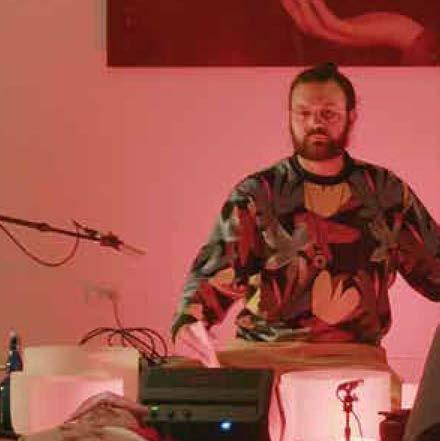


Logan Center for the Arts 915 E 60th St • Chicago • Free parking
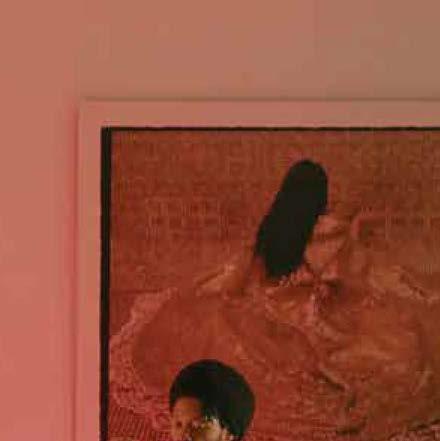
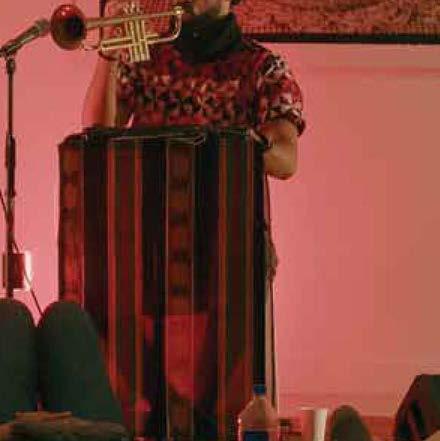

Recommended and notable shows with critics’ insights for the week of June 13 b
Hip-hop polymath Rich Robbins celebrates a year of Soft and Tender with a big hometown show

Orville Peck Durand Jones and Debbii Dawson open. 7 PM, Aragon Ballroom, 1106 W. Lawrence, $59.25. b
Before Beyoncé came strolling in with Cowboy Carter, another provocateur was stirring up the country scene and challenging perceptions of what Americana can be. Out-and-proud gay crooner Orville Peck merges the classic outlaw styles of Merle Haggard and Waylon Jennings with a modern-rock bent that often diverges into gothic atmospherics—on his 2019 single “Dead of Night,” his vocals recall the romantic sound of Chris Isaak.
Venerable indie label Sub Pop released Peck’s 2019 debut album, Pony, and the response catapulted Peck to the status of LGBTQ+ icon. Lady Gaga tapped him to cover “Born This Way” in 2021, and that same year he collaborated with drag queen Trixie Mattel on the single “Jackson,” which recalls country music’s golden era. In April he released his latest duet, a version of Ned Sublette’s 1981 track “Cowboys Are Frequently, Secretly Fond of Each Other” where he trades lines with Willie Nelson (who’d covered the song solo in 2006).
Peck performs in a fringed mask, and in combination with his leather ensembles and sequined chaps, it makes him look like a glam rodeo Zorro. The air of mystery he cultivated didn’t last long, though, and it’s now known that “Orville Peck” is the stage name of Daniel Pitout, who cut his teeth in Canada’s punk scene (most notably drumming in Nü Sensae). A sense of liberty has permeated Peck’s music ever since, including on last month’s EP Stampede Vol. 1. While it shares a motif with earlier equestrian- themed album names (2019’s Pony, 2022’s Bronco ), its collaborative spirit represents an artistic about-face for the formerly lone ranger: the EP features an assortment of guests, including singer-songwriter Nathaniel Rateliff, indie-pop artist Tobias Jesso Jr., and two of the Cyrus kids (Noah and Braison). But the pièce de résistance is a duet with Elton John on a rendition of the latter’s “Saturday Night’s Alright for Fighting.” This Aragon performance is part of Peck’s Stampede tour, and he seems poised to throw open the gates and let his badlands ballads rush in. —SELENA FRAGASSI
Sensor Ghost Future Living headline; Sensor Ghost and Regal Machines open. 8 PM, Burlington, 3425 W Fullerton, $10. 21+
RICH ROBBINS WAS VOTED “Best individual hip-hop artist” in the Reader’s 2023 Best of Chicago audience poll, but he’s much more than a rapper. He’s real soft, real tender, and so dedicated to his craft that he almost got hit by a car while trying to fi lm content for his 2023 single with Mick Jenkins, “Now We Got Money.” He’s also a slam poet, TV show host, educator, and founder of the much-needed open-mike series Respect the Mic, which takes place monthly at Positive Space Studios in Logan Square. He’s released a steady stream of quality projects since he started making music in 2015. Combine that with his community-based work and his willingness to pay his good luck forward, and it’s no wonder that 2024 is shaping up to be Robbins’s biggest year yet.
As a smooth neojazz rap poet and crooner, Robbins advocates for taking time to focus on what really matters; on his YouTube talk show, Soft and Tender , he explores family strength, Black fatherhood, and mental health while holding space for other like-minded creatives. That’s the spirit he’s taking into this headlining performance at Metro. The evening, which commemorates the first anniversary of Soft and Tender , features a stacked lineup with hazy funk guitarist and producer Elton Aura, eccentric soul band GreenTTea & the Tempos, and bouncy, melodic vocalist Aero Austaire. Hosted by slicktalking teaching artist Naira, this show is a celebration of partnership, intentionality, and dedication to our local scene—snagging a ticket is a no-brainer. —CRISTALLE BOWEN
Sensor Ghost’s brief, bitten-off art-punk songs slice through the air like an alarm clock buzz-sawing into your sleeping brain. The D.C. trio partake of their hometown’s storied punk legacy, and all three members are scene veterans. Guitarist Amanda Huron established herself with the mid-90s emo band Impetus Inter, and more recently she played in a spunky group called Puff Pieces with Sensor Ghost bassist-vocalist Mike Andre. Andre had previously been a member of criminally overlooked Dischord band Antelope, alongside Justin Moyer (also later of Puff Pieces), and Sensor Ghost drummer Sam Lavine plays with Moyer in percussion-heavy postpunk band Light Beams. On Sensor Ghost’s February EP, 3 Songs (Dischord/Lovitt), Andre talk-sings his puzzling lyrics in a sharp, adenoidal voice, and
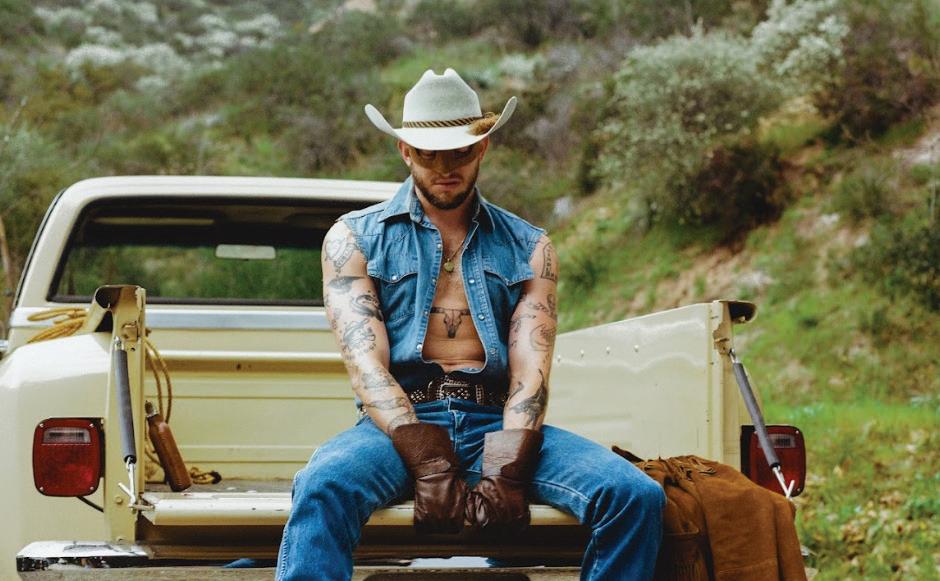
his strange performances underscore the feeling that the band’s direct-seeming songs are treading on unstable ground and could plunge through it at any moment. This sense of unease doesn’t come from any particular element you could tease out of the music—the rhythms are mostly blunt and metronomic, and Huron’s rangy guitar is as likely to feel inviting as it is prickly and off-putting. It’s more like an emotional halo that surrounds the whole, hovering in the imaginary space between anxiety and fury. Even Sensor Ghost themselves don’t always seem sure what direction their songs will veer, and it gives them a frightening magnetism. —LEOR GALIL
Rich Robbins See Pick of the Week at le . Elton Aura, GreenTTea & the Tempos, and Aero Austaire open; Naira hosts. 8 PM, Metro, 3730 N. Clark, $20, $15 in advance. b




EVENT
+ Elton Aura / Green ea & The Tempos
JUN 22 / 10PM / 21+
Lyrical Lemonade Summer Smash day one See also Sat 6/15 and Sun 6/16. Today’s bill features Cactus Jack (Travis Scott, Don Toliver, Sheck Wes, SoFayGo, Chase B), Big Sean, Destroy Lonely, Flo Milli, That Mexican OT, Bktherula, Black Kray, BLP Kosher, Famous Dex, Clip, Lazer Dim 700, OsamaSon, VonOff1700, Boss r, Elijah Wallace, and Kami. 3 PM, SeatGeek Stadium, 7000 S. Harlem, Bridgeview, $150, $395 three-day pass, two VIP levels also available. b
In 2018, Chicago hip-hop blog Lyrical Lemonade threw the first outdoor Summer Smash festival in Douglass Park (then still spelled with a single “s”). Last year the Summer Smash moved to SeatGeek Stadium in Bridgeview, and Lyrical Lemonade founder Cole Bennett and his team are calling it the largest hip-hop fest in the midwest. The event owes its rapid growth in part to Bennett’s astronomical climb as a go-to videographer for rising and mainstream rappers; Lyrical Lemonade’s
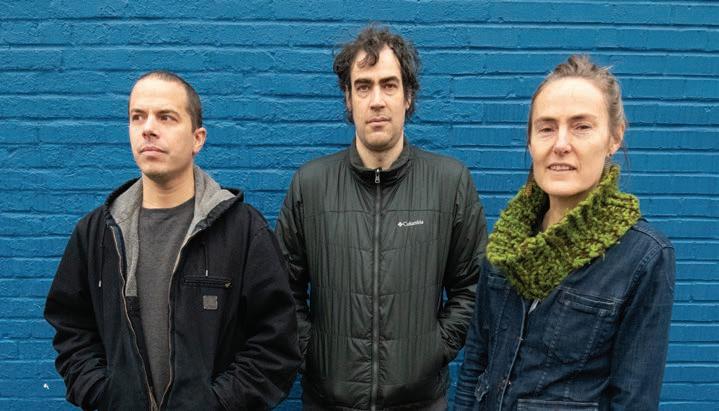
THU JUN 27 / 7:30PM / ALL AGES
+ Sisters of Your Sunshine Vapor
MUSIC: THELIMITDOESNOTEXIST (NYC) Boots (DJ Set) / Jenny Fox / Miss Toto and more! FRI JUN 28 / 9PM / 21+
METRO & SMARTBAR PRESENT ALL-BUILDING EVENT
IN METRO: VITIGRRL * Stasney * iceybby IN SMARTBAR: Jenny Fox b2b karrenoid TRQPiTECA / Virago and more!
FEATURING: Derrick Carter / Michael Serafini / Janky Blu9 / Candy J / Vitigrrl / Lori Branch and more! SAT JUL 06 / 11:59PM / 21+
CHICAGO BLACK PRIDE PRESENTS THE ULTIMATE BLACK PARTY TEAIRRA MARI with Stevia Smoke Da Rapper / GakTrizzy ThizzMarley / Aki Da Rapper and more!

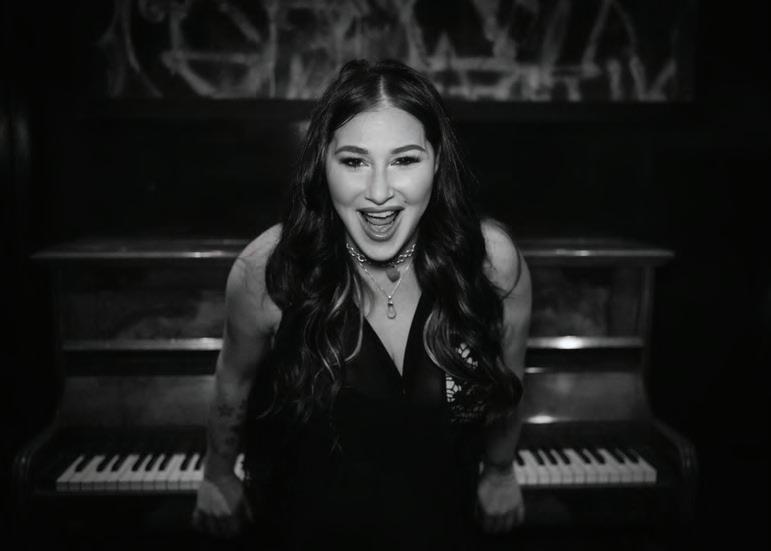


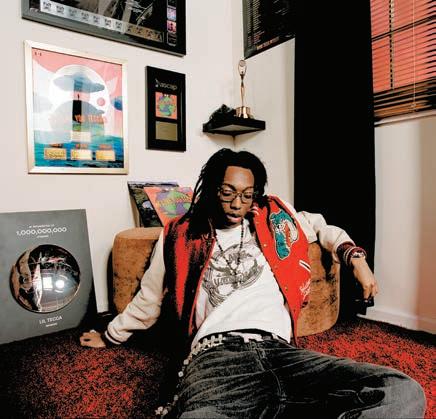

continued from p. 39
history is intertwined with that of Juice Wrld, not least because Bennett directed the rapper’s breakout “All Girls Are the Same” video. Many acts performing at this year’s Summer Smash have enlisted Bennett to make their music videos—and he’s enlisted them in turn for his own projects. In January, Lyrical Lemonade partnered with Def Jam to release a scattershot compilation album called All Is Yellow , and roughly one-third of the 34 artists who appear are also on the 2024 festival bill, including Lil Skies, Lil Tecca, and Lil Yachty. Bennett has also achieved crossover success, collaborating with the NFL on a run of Chicago Bears clothes and merch with Lyrical Lemonade branding. On July 3, the Chicago Cubs will host a Lyrical Lemonade–themed night, offering a special ticket deal that’ll get you a Cubs jersey with the hip-hop outlet’s lemonade-carton logo on the sleeve.
In April, the TRiiBE shared a collection of X posts in an Instagram slideshow, aiming to start

a conversation about Bennett’s role in the local scene: “What do y’all think? is Cole Bennett a vulture or an ally for Chicago hip-hop?” As I see it, Bennett has done a lot to uplift MCs who might not otherwise have gotten much exposure, and he’s remained loyal to those acts (for better or worse) as Lyrical Lemonade has grown into a bankable brand. (Famous Dex and Kodak Black, both of whom now seem to be uncanceled, are performing at this year’s Summer Smash.) To see Bennett’s success as a threat to the Chicago scene, you’d have to vastly over estimate Lyrical Lemonade’s influence. The world of hip-hop is too vast for that to be a problem—in fact, if you ask me, we need more operations like Lyrical Lemonade. I love finding new grassroots hip-hop outlets that can put artists on my radar, and I don’t think it would hurt the culture if, say, Chicago vlog and event-production collective Real Ones got just as big.
The Summer Smash isn’t the only way to see hiphop at a Chicago festival, of course, so I wouldn’t read too much into its lineup either—it’s a reflection of Bennett’s musical sensibilities and a peek at his Rolodex, and he doesn’t seem to care to avoid repeat bookings. Many other local festivals (whether major events or street fairs) speak to the sprawling nature of hip-hop from a different angle. That said, Bennett wouldn’t have earned his reputation as a tastemaker if he didn’t stay on top of trends, and this year’s Summer Smash lineup includes 2023 breakout hitmaker That Mexican OT, prolific experimentalist Lazer Dim 700, and maximalist OsamaSon. Summer Smash doesn’t skimp on locals the way Lollapalooza does, and this year Mick Jenkins will perform all of his breakthrough mixtape, 2014’s The Water[s], to celebrate its tenth anniversary.
The big “get” for the fest is Sunday-night headliner Chief Keef. Keef hasn’t performed in the Chicagoland area in nine years—and you can only get a number that low by counting his 2015 “hologram” appearance at Craze Fest in Hammond, Indiana, where police pulled the plug a er just a few minutes. Keef had intended that virtual appearance to be at a Chicago benefit concert (he was avoiding in-person shows in the city due to outstanding arrest warrants stemming from child-support and

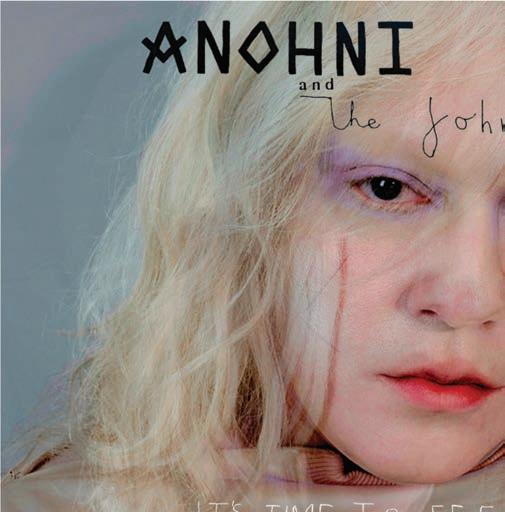






SHED THE SALT SHED THE SALT SHED THE SALT SHED THE SALT SHED THE SALT SHED SALT SHED THE SALT SHED THE SALT SHED THE SALT SHED THE SALT SHED THE SALT
THE SALT SHED THE SALT SHED THE SALT SHED THE SALT SHED THE SALT SHED THE
SHED THE SALT SHED THE SALT SHED THE SALT SHED THE SALT SHED THE SALT SHED
SALT SHED THE SALT SHED THE SALT SHED THE SALT SHED THE SALT SHED THE SALT THE SALT SHED THE SALT SHED THE SALT SHED THE SALT SHED THE SALT SHED THE SHED THE SALT SHED THE SALT SHED THE SALT SHED THE SALT SHED THE SALT SHED
SALT SHED THE SALT SHED THE SALT SHED THE SALT SHED THE SALT SHED THE SALT
THE SALT SHED THE SALT SHED THE SALT SHED THE SALT SHED THE SALT SHED THE
SHED THE SALT SHED THE SALT SHED THE SALT SHED THE SALT SHED THE SALT SHED
SALT SHED THE SALT SHED THE SALT SHED THE SALT SHED THE SALT SHED THE SALT
THE SALT SHED THE SALT SHED THE SALT SHED THE SALT SHED THE SALT SHED THE SHED THE SALT SHED THE SALT SHED THE SALT SHED THE SALT SHED THE SALT SHED
SALT SHED THE SALT SHED THE SALT SHED THE SALT SHED THE SALT SHED THE SALT THE SALT SHED THE SALT SHED THE SALT SHED THE SALT SHED THE SALT SHED THE
WITH FLYING LOTUS, TANK AND THE BANGAS AND KARINA RYKMAN
SHED THE SALT SHED THE SALT SHED THE SALT SHED THE SALT SHED THE SALT SHED
SALT SHED THE SALT SHED THE SALT SHED THE SALT SHED THE SALT SHED THE SALT
THE SALT SHED THE SALT SHED THE SALT SHED THE SALT SHED THE SALT SHED THE

JUNE 13 JON BATISTE ....................... .FAIRGROUNDS
JUNE 22 BROTHERS OSBORNE ................. .FAIRGROUNDS
WITH SPECIAL GUEST THE CADILLAC THREE
JUNE 28 HAWTHORNE HEIGHTS .................... THE SHED
WITH I SEE STARS, ANBERLIN ARMOR FOR SLEEP, EMERY AND THIS WILD LIFE
JULY 4 MY MORNING JACKET ................ .FAIRGROUNDS
WITH NEAL FRANCIS, ANDY FRASCO & THE U.N. AND HANS WILLIAMS
SALT SHED THE SALT SHED THE SALT SHED THE SALT SHED THE SALT SHED THE SALT THE SALT SHED THE SALT SHED THE SALT SHED THE SALT SHED THE SALT SHED THE SHED THE SALT SHED THE SALT SHED THE SALT SHED THE SALT SHED THE SALT SHED SALT SHED THE SALT SHED THE SALT SHED THE SALT SHED THE SALT SHED THE SALT THE SALT SHED THE SALT SHED THE SALT SHED THE SALT SHED THE SALT SHED THE SHED THE SALT SHED THE SALT SHED THE SALT SHED THE SALT SHED THE SALT SHED SALT SHED THE SALT SHED THE SALT SHED THE SALT SHED THE SALT SHED THE SALT THE SALT SHED THE SALT SHED THE SALT SHED THE SALT SHED THE SALT SHED THE SHED THE SALT SHED THE SALT SHED THE SALT SHED THE SALT SHED THE SALT SHED SALT SHED THE SALT SHED THE SALT SHED THE SALT SHED THE SALT SHED THE SALT ON SALE NOW
probation charges), but it got shut down before it even started. Keef’s reputation as a hip-hop innovator has grown significantly since he burst onto the scene in 2012, and his set here is a big deal no matter how it goes. —LEOR GALIL
Lyrical Lemonade Summer Smash day Two See Fri 6/14. Today’s bill features Playboi Carti, Kodak Black, Lil Tecca, Lucki, Ski Mask the Slump God, Bia, Lil Skies, Mick Jenkins, Paris Texas, Rich Amiri, Baby Kia, Cash Cobain, Nettspend, TiaCorine, Xaviersobased, 2Rare, Freddy Got Magic, Uneek, and $am. 1 PM, SeatGeek Stadium, 7000 S. Harlem, Bridgeview, $150, $395 three-day pass, two VIP levels also available. b
Lyrical Lemonade Summer Smash day Three See Fri 6/14. Today’s bill features Chief Keef, Denzel Curry, JID, Ken Carson, Lil Yachty, Waka Flocka Flame, YG Marley, Anycia, Babytron, Bashfortheworld, Homixide Gang, Lil B, Hardrock, Icytwat, Joeyy, Laundry Day, Lil Gnar, Robb Bank$, FukyurPain, and Shed Theory. 1 PM, SeatGeek Stadium, 7000 S. Harlem, Bridgeview, $160, $395 three-day pass, two VIP levels also available. b
Nourished by Time Urika’s Bedroom opens. 8 PM, Schubas, 3159 N. Southport, sold out. 18+
Nostalgia-drenched synth-pop projects are thick on the ground right now, but few feel as fresh as Nourished by Time, the solo project of Marcus Brown. This music sounds like what might happen if Boys II Men wrote songs with Siouxsie & the Banshees while crammed inside a teen girl’s closet. It’s as kaleidoscopic as studying a locker-door collage of heroes and inspirations from two inches away, so that it’s impossible to make sense of the whole—but the effect is viscerally fun and free in ways that are both strange and elegant.
Brown recorded Nourished by Time’s 2023 debut, Erotic Probiotic 2 (Scenic Route), in their parents’ basement in Baltimore, but it’s light-years beyond your typical lo-fi bedroom pop. The record is intricately layered with references to 80s freestyle, disco, early-90s R&B, and funk, and it embraces a Prince-ly rock ’n’ roll spirit. “Daddy” became the album’s breakout single, and for good reason; it’s a thrill ride through Brown’s relationship with a partner who ditches them for a full-time sugar daddy. How’s a struggling indie musician supposed to compete with someone who has that kind of bag?
The track opens with Brown singing a reverbdrenched refrain, “I’ll never be alone, daddy”; between the production and harmonies, it sounds almost like a small choir. Then the song gives way
to a series of 808s and keyboards played with the hungry precision of someone running a tire obstacle course. Nourished by Time flexes so much artistry over that sugar daddy’s riches that you’ll wonder how anyone could choose money over imagination. Losers will find nourishment elsewhere; Nourished by Time’s Erotic Probiotic 2 is a supplement for real dreamers only. —MICCO CAPORALE
Monsieur Periné Letón Pé opens. 8 PM, Thalia Hall, 1807 S. Allport, $30, $45 balcony, $360 opera box (seats six). 17+
Monsieur Periné are musical maximalists. Based in Bogotá, Colombia, they write songs informed by a wealth of Afro-Colombian, European, and Latine styles, and they sing in Spanish, French, English, and Portuguese. The ensemble, led by vocalist Catalina García and multi-instrumentalist Santiago Prieto, formed in 2007 and started out playing covers at weddings and corporate events before developing their own material, which merges cumbia, bolero, tango, cabaret, pop, and more. As serious as they are about their music, they’re not staid: they love imaginative costumes and productions, and their sense of humor is sometimes delightfully off-color. Their name riffs on the French word for “perineum” (périnée) and throws in an honorific (I think we can all agree that “Monsieur Periné” sounds more sophisticated than “Mister Taint”).
Last month, Monsieur Periné joined forces with Cuban funk and hip-hop star Cimafunk on the sexy, danceable duet “Catalina.” The group’s latest full-length album, last year’s Bolero Apocalíptico , confronts societal woes such as climate change and oppression with their trademark inventiveness and romance; in a January interview for Latine pop-culture podcast Highly Relevant , Prieto describes its songs as “different expressions of love in apocalyptic circumstances.” The band sprinkle R&B, dub, and jazz manouche in among traditional rhythms and elements of Latin pop, and they showcase guest appearances from the likes of Chil-

ean activist-rapper Ana Tijoux and Brazilian reggae group Natiruts. The album plays like a book where you can’t stop turning the pages. —JAMIE LUDWIG
Mdou Moctar See also Tue 6/18. Lia Kohl opens. 9 PM, Empty Bottle, 1035 N. Western, advance tickets sold out. 21+
Mdou Moctar was born to shred. The spirit of rock ’n’ roll lies deep in his soul and pulses through his fingertips every time he grabs his ax. When Moctar was growing up in Niger, his parents disapproved of rock music, but he was so determined to play electric guitar that he built one in secret, using a board and bicycle brake cables. It only had five strings, and he had to practice it covertly.
Like a true rock star, Moctar is surrounded by a robust mythology. His early releases were hot with

the Saharan fans who traded music between their cell phones using Bluetooth or memory cards, then the most popular file-sharing system in the region. They caught the attention of American archivist and film director Christopher Kirkley, founder of the Sahel Sounds label, who included Moctar’s song “Tahoultine” on the 2011 compilation Music From Saharan Cellphones and later recruited Moctar to star in his 2015 Tuareg remake of Purple Rain, titled Akounak Tedalat Taha Tazoughai (which translates to “Rain the Color of Blue with a Little Red In It”). Yes, this man is Niger’s psych-rock answer to Prince—and he’s got the talent to support the comparison.
Moctar’s music is electrifying and inventive. Most of his lyrics are in Tamashek, and they celebrate the beauty of Islamic virtues as much as they decry the rampant misogyny in Nigerien culture. But you don’t have to understand the words to appreciate that Moctar is doing something special. He borrows guitar licks from traditional music (mostly assouf, usually called “desert blues” in the West, and takamba) and fuses them with his unabashed love for classic rock. This alchemy has resulted in seven incendiary, tripped-out records to date. The latest, last month’s Funeral for Justice (Matador), also goes the hardest. It’s deeply political, detailing the plight of the Tuareg people under postcolonial rule and stating plainly (among other things) that France sucks shit for everything it’s done to Niger, including exploiting the country for uranium and contributing to the political instability that’s led to five coups since the country gained its independence in 1960. The most recent coup, in July 2023, precipitated a crisis that has kept Moctar and his bandmates in the States, unable to return home, ever since. Funeral for Justice is smoldering, furious, and alive—exactly as rock music should be. —MICCO CAPORALE
TUESDAY18

ON THURSDAY, JUNE 13, idiosyncratic Chicago hip-hop group Mother Fortune drop their third release, Ma, Don’t Look Back. This wild EP emphasizes the band’s chemistry and “live in the room” interplay, in a clear break from the relatively studio-oriented material of their first two albums, 2020’s Mama Ain’t Dead and 2022’s Mommy Is Missing Rapper Shami cofounded Mother Fortune (MoFo for short) in 2018, naming the group after his spiritual grandmother, Lily Mohammed. “She’s like Yoda—she’s one with the Force. She’s the wisest person I’ve ever met,” he says. “I was like, ‘I wanna be wise like her. I want to make music that’s wise like her.’ But, you know, I like n---shit, so if I can fuse her with a bit of my own sensibilities.” Shami has worked with several collaborators while shaping Mother Fortune, and he says that this iteration of the band—made to focus on playing live—is the third. Shami found an eager onstage collaborator in visual artist and vocalist Moira (the band members use mono nymic performance names).
“I love playing and performing live,” Moira says. “So I spoke with Shami, who is like, ‘I want to perform our music live.’ And I was like, ‘I would love to do that as well.’ I loved working with him and the energy that he brought, so that’s what brought me into it.”
Shami next brought aboard bassist Tyler Meneese , who also plays sax in punk band Edging . That still wasn’t a complete lineup, though. “I was like, ‘Well, we can’t just have a bass and two vocalists. We need more,’” Shami says.
“So I went on Reddit and Facebook, like, ‘Looking for band, this is what we sound like.’” Taskin answered the call and showed up at Shami’s home with her drums.
“She brought them in,” Shami says.
A furry ear to the ground of the local music scene
on these billings that are, like, all punk bands or jam bands or hip-hop acts that do backing tracks. It was a weird fit.”
But Mother Fortune made the most of it.
“We did a SubT show with a ska band,” Taskin says. “It was like, ‘How hard can we rock this fucking ska show? And get these ska people to get into it?’ Sometimes it has been a challenge, but we’ve enjoyed the challenge.”
Mother Fortune celebrate their new EP with a headlining gig at the California Clip-

need—my own need—but will also be beneficial to the community?’”
Mahadevan came up with the idea to create a digital media platform, which would also host a show of her own. Last year she debuted Kismet Radio with a series she hosts called Something Slight , which combines interviews with occasional guest mixes. Something Slight celebrates its first anniversary with a live show at the Humboldt Jungle on Thursday, June 13.

“We sat there, we shared a beer that she bought, and we rapped over three songs. She was like, ‘Yep.’ ‘You in?’
‘Yeah, I’m in.’”
Mother Fortune completed their lineup with guitarist Cesar, a er finding him at a jam session at defunct Lincoln Park venue Golden Dagger. Everybody in the band was down with Shami’s oddball humor and musical ambition, but it took a while for Mother Fortune to fi nd other acts in Chicago on their wavelength—and that resulted in some incongruous bookings. “I feel like at first we did struggle a little,” Taskin says. “We would get put
per on Thursday, June 13, and they’ve got a slate of like- minded artists to help: Slo ’Mo resident DJ and singer Icey Bby, postgrunge group Orisun, and DJ Earn Money. The show starts at 8 PM, and there’s a $5 cover.
CHICAGO MUSIC JOURNALIST (and Reader contributor) Tara C. Mahadevan has developed a project that can fully engage her creative drive. “I have my work, and I write for Complex , but that doesn’t really satiate the storyteller in me,” she says. “As I moved away from freelancing, I was like, ‘What will fill this
Mahadevan first floated the idea in early 2023, suggesting it to her friends at hip-hop collective, label, and studio Private Stock . They not only encouraged her to build the platform, they also offered their services: Mahadevan has conducted all the Something Slight interviews at Private Stock’s Irving Park headquarters, and their team records the audio and video and hosts it on the Private Stock website.
“I’m really grateful to collaborate with people, and they’re so down to do it,” Mahadevan says. “That’s really cool. As a woman in music, men treat you a certain way, and generally, in the world, people tell you ‘no’ a lot. I’m really validated by my team because all my ideas, they’re like, ‘That’s cool.’”
Something Slight has focused on people involved in Chicago music; Mahadevan’s interview subjects include DJ Bonita Appleblunt , Classick Studios founder Chris Classick , rapper Jay Wood , and Illanoize Radio founder Bekoe (Full disclosure: Mahadevan has also interviewed me.) “Some of these conversations are really long,” Mahadevan says. “I’m talking to people who don’t get a chance to tell their story or don’t get a chance to sit down and really reflect on their experiences in all this.”
At the first-anniversary party, Mahadevan will interview rapper and chef SoloSam and rapper Mvte, both of whom will also perform; DJ Police State will spin. The show starts at 8 PM. Tickets are available through the Something Slight Instagram page, instagram.com/ somethingslightshow. —LEOR GALIL
Got a tip? Tweet @Gossip_Wolf
Health Care Service Corporation seeks Business Analyst (Chicago, IL) to work as a liaison among stakeholders to elicit, analyze, communicate and validate requirements for changes to business processes, policies and information systems. REQS: This position reqs a Bach deg, or forgn equiv, in Tech or Bus Admin or a rel fld + 2 Yrs of exp as a proj mgr, sys analyst, or a rel position. Telecommuting permitted. Applicants who are interested in this position should submit a complete resume in English to hrciapp@bcbsil.com, search [Business Analyst / R0026599. EOE].
Gelber Group LLC seeks Financial Quant Analyst in Chicago, IL to perf stat analysis by applying math/stat techniques on financial data. Reqs. Master deg or foreign equiv. in Fin. Eng., Finance, or rel. field. Coursewrk must incl Fin. Eng., Cont. Time Models, Machine Learn for Fin Eng & Oper, Compu Methods in Fin, Algorithmic Trading, Analysis of Algorithms. Quantenet C++ Certificate req.Email Resume to: recruiting@ gelber group.com.
Sales Engineer, Metamation Software Sales Engineer, Metamation Software. TRUMPF. Hoffman Estates, IL; 1 day/ week remote; 10% travel annually in US, Mexico, Canada. Conduct live webinars & presentations to support sales by analyzing customer needs & advising on process improvement with mfg software. Must have bach in indust eng & 2 years in TRUMPF, Metamation, or comparable mfg software sales, CAD & CAM software programming, analysis & consultation for sheet metal mfg, user feedback collection & sharing. Apply at www.trumpf.com.
OVE CONSTRUCTION, INC. OVE CONSTRUCTION, INC. seeks a Purchasing Manager. Mail resume to 50 OLD OAK DR #213 BUFFALO GROVE , IL.
Morningstar Research Services seeks Senior Equity Analyst (multiple positions) in Chicago, IL. The position is research-focused and has client-facing responsibilities. BS deg in Econ, STEM, Engg Management, or a related field or foreign equivalent & 5 yrs of rlvt exp req’d. In alternative, MS deg in Econ, STEM, Engg Management, or
a related field or foreign equivalent & 2 yrs of rlvt exp req’d. Add’l specific skills req’d. For position details & to apply, visit: https://www.morningstar.com/careers; ref. job ID REQ-044432.
Research Manager Northwestern University seeks Research Managers for various & unanticipated worksites throughout the U.S (HQ: Evanston, IL) to manage all activities associated w/biomedical & or social behavioral research studies. Bachelor’s in Econ/Pub Policy/Soc Sci/related field+4yrs exp OR Master’s in Econ/Pub Policy/Soc Sci/related field +2yrs exp req’d. Req’d skills: 2yrs managing research projects & staff; Exp must incl conducting advanced statistical/ econometric analysis, analyzing data from large randomized controlled trials; supervising/ managing teams; project mgmt w/data; field exp; Econometric analysis using Stata, incl. randomized evals; Stata w/survey data & large data sets; SurveyCTO. Edu/exp in R/Python, data visualization. Hybrid work available. Must be willing to travel internationally as req’d to support projects. Background check req’. Send resume to: Katie Dallia, povertyresearch@northwestern. edu, Ref: ND
TECHNOLOGY
ServiceNow Inc is accepting resumes for the following positions in Chicago, IL. Senior Software Engineer – Front End (ref# 4153022): Build highquality, clean, scalable and reusable code by enforcing best practices around software engineering architecture and processes. Telecommuting permitted. Annual salary: $175,000-$205,000. Supervisor, Software Engineering Management (ref# 3422243): Support the use of the latest technologies that provide potential improvements to results. Telecommuting permitted. Annual salary: $170,088-$200,088. Email resume to servicenowresumesUS@ servicenow.com. Or mail resume to ServiceNow Inc, Attn: Global Mobility, 2225 Lawson Lane, Santa Clara, CA 95054. Resume must include job title, job ref. #, full name, email & mailing address. No phone calls. Must be legally authorized to work in U.S. without sponsorship. EOE.
Fuji America Corporation seeks Field Service Engineer w/
Assoc or for deg equiv in elec tech or rltd fld & 2 yrs exp in job offer or in fld serv or eng incl exp in surf mount-autom, elec & mech diagn/rep, mdrn PC apps and ntwk concp. Freq dom & intl trvl reqd. Telecom permit. May reside anywhr in US. Apply online https:// www.fujiamerica.com/ hr.aspx or to HR, 171 Corporate Woods Pkwy, Vernon Hills, IL 60061
Sr. Staff Scientist Billups, LLC in Chicago, IL seeks Sr. Staff Scientist to develop & apply geo-location data analysis techniques to solve business problems. 100% remote. Reqs MS + 3yrs exp. $163,328/yr. To Apply: To apply: email resumes to HR, jennifer.napierala@billups. com, reference job title: Senior Staff Scientist.
QUANT TRADER
DRW Holdings LLC has openings in Chicago, IL: Quant Trader (Pos ID QT/ IL/R069): Execute exist trad strat & apply to new prod. REQ Bach or for equiv Math, Engr, or rel quant field & 3yrs Quant Anayst exp Quant Trader (Pos ID QT/IL/X070): Op trad strat, mng auto mkt-system risk, mng vol surfc pric & optmze trad strat para. REQ Master’s or for equiv Math, Stat, Quant Fin, or quant field & 1yr quant tding analy exp. EM apply@drw. com, Attn: M. CARTER. Must ref. Pos ID. EOE.
Tate & Lyle Solutions
USA LLC seeks Senior Network Engineers w/Bach or for deg equiv in CS, EE, Electron Eng or rel fld & 2 yrs exp in job offer or in lrge scle dsgn, impl & suprt bldg cmplt LAN/SDWAN sltns incl exp w/BGP, EIGRP rtng & WAN/ SDWAN suprt; in unif comm dsgn & deploy incl Avaya, Microsoft, Cisco voice/video. Telecom permtd. May rsde anywhr in the US. Apply online at https://careers.tateandlyle.com/global/en or to HR, 5450 Prairie Stone Pkwy, Hoffman Estates, IL 60192
Workday Payroll Specialist Workday Payroll Specialist, AbbVie Inc., North Chicago, IL. Serve as a key Liaison for Workday Payroll functional team to provide support and remediate the Payroll and HCM modules. Serve as the primary Workday configuration and reporting professional for functionality but limited to Payroll, Benefits, Compensation, Core HR, Time Tracking and General Ledger. Utilize systems/ analyst experience in payroll and HR modules.
Design and Develop Reports, Complex Calculated Fields using Report writer and integration solutions in Workday using EIB’S, Custom Reports or RaaS solutions. Serve as a key liaison between business teams, 3rd party vendors and IT for system integrations and issue resolution. Build Advanced Calculated Fields using Report Writer and integrations using EIB’s to support client’s requirements. Work with APIs within the Workday environment using REST or SOAP and XSLT and XML programming Language. Utilize knowledge of Workday and experience integrating with 3rd party applications. Support pre and post payroll activities and payroll audits (e.g. Exempt/Nonexempt Term Audits, CA Audit Reports, High Gross/High Net Audits, Zero Net/Zero Gross, Review master data file quality and confirm time/payroll data completeness). Utilize knowledge of ERP, Workday System Concepts and HCM, payroll module functionality. Assist in resolving input errors and other errors from the third-party vendors or internal AbbVie (Tax, Treasury, Finance and BHR) stakeholders performing root cause analysis. Support Year-End Payroll processing activities (e.g. develop and provide payroll calendar, review year-end tax reports and notify AbbVie employees of availability of tax information. Design, document, build, unit test and support functional tasks, configuration, and programs for Workday HCM and Payroll projects. Research and participate in update training to keep up to date on new Workday functionality to make recommendations for adoption. Support data extraction, audit controls and data quality alerts. Provide end-user support with troubleshooting and issue remediation. Research problems and identify opportunities on suggested solutions with escalation management to Workday Second Level Support team. 100% telecommuting permitted. Must possess a Bachelor’s degree or foreign academic equivalent in Technology Management, Business, or a closely related field of study with at least three (3) years of related experience in the following: (i) knowledge of HR Business Processes like Job Change, Hire, Compensation change, termination; (ii) experience in inbound/outbound integrations Using Workday Studio, managing business processes, working with EIB, Report Writer, creating workday calculated field and Custom Reports and Financial Management Services;
(iii) utilizing XML and XSLT and Web Services technology to transform input within EIB/Studio as per the API webservice request; (iv) knowledge of Workday and serving as a key liaison between third parties and stakeholders to define, implement, design and develop workday and other 3rd party interfaces. 100% telecommuting permitted. Apply online at https:// careers.abbvie.com/en & reference REF25665J. Salary Range: $83,616 - $134,500.00 per year.
Research Engineer
Aquatic Group is seeking a Research Engineer in Chicago, IL. Deliver custom software solutions including investigating novel research ideas & evaluating w/ large-scale experiments. Must live w/in normal commuting distance of worksite. Email res to HR@ Aquatic.com & ref code 88860 in subject line.
Software Developers
Software Developers, Schaumburg, IL: Analyze the requirements and gathering specifications based on technical needs. Offer inputs to SDLC (Software Development Life Cycle) documentation specialists and edit documentation. Assists in the day-today maintenance and improvement of the Enterprise Resource Programs and related systems. Travel/reloc to various unantic locs throughout the U.S. Send res to: Rigelsky, Inc. at 120 W Golf Rd, Suite 106, Schaumburg, IL 60195 or email: info@rigelsky.com
Northwestern Memorial Healthcare seeks Cytogenetic Technologists for Chicago, IL location to perform test procedures in the Human Genetics Lab. Bachelor’s in Med Tech/ Clinical Lab Sci/Cytotech, Biotech/Genetic Eng/related field req’d. Req’d skills: ASCP CG eligible. Eligible as Testing Personnel under the CLIA 88 regs. Background check & drug screen req’d. Apply online: http:// jobseeker.nm.org/ Req ID: REF65701A
Salesperson Salesperson (Bridgeview, IL), Respon for selling custom cabinetry, account management, & business development. 18 mths + of exp as a salesperson, sales specialist, sales consultant. H.S. dipl or equiv. Send resume & letter of interest to T&J Woodworking, 7322 West 90th St., Bridgeview, IL 60455.
Medline Industries, LP in Mundelein, IL is seeking Sr. IS Business Analyst(s) (SAP OTC) to
define, doc, dsgn, implmnt & sup’rt SAP ECC & allied SW solut’ns to meet biz objectives. No trvl; WFH bnft avail. Post’n reqs off-hrs sup’rt as needed, incld’ng on-call rotation. Apply at: https:// med line.taleo.net/career section/md_confiden tial/ jobapply.ftl?lang=en& job=INF01013J
Managing Principal Chaucer America, Inc. - Chicago, IL. Req: Master’s in Eng Management, Computer & Info Tech or rltd + (12) mths of rltd exp & in IT Projects. Send resume to: Vanessa. heintz@chaucer.com
Quantitative Researcher – PhD CTC Trading Group, LLC seeks Quantitative Researcher - PhD in Chicago, IL. Analyze market data and market microstructure. Contribute to production trading through research. Apply @ www.jobpostingtoday. com #48796.
Senior Technology Analyst Senior Technology Analyst: Dsgn & dvlp Software using .Net, C#, Angular, Powershell, WebServices, & SQL Database, incl adhering to best practices & standards in dvlpmnt, tech, & security. Dsgn & dvlp solutions using .Net, C#, Angular, Powershell, WebServices & SQL Database. Manage the source control on Azure & GitLab. Analyze & translate biz reqmnts into tech reqmntss for dvlpmnt & create design docs & tech specs. Supervise comp programmers & serve as project leader for systems projects. Communicate w/project mgmt about status of work & any issues w/work progress. Lead projects w/ clients. Provide post-implementation support to clients, incl, but not limited to, monitoring performance & debugging/correcting codes. Sal $82K/yr. Reqs: Bach’s deg in Compr Sci, IT, Comp Engg, or rel fld. Resumes to: Systems Guild, Inc., Attn. HR, 1800 W Hawthorne Ln., West Chicago, IL 60185.
Medline Industries, LP in Northfield, IL has multi open’gs: A) Sr. IS Developer Analyst(s) (RPA) for full proj dvlpmnt, implemnt’n, & deploymnt. Apply at: https://medline.ta leo. net/careersection/md_ confidential/jobapply. ftl?lang=en&job=IN F01013H B) Lead IS Developer Analysts (Automation Development) to anlyz & assess automat’n feasibility. Apply at: https://medline.ta leo. net/careersection/md_ confidential/jobapply. ftl?lang=en&job=IN F01013I C) Lead Business Analyst(s) to
sup’rt & implemnt solut’ns to biz challenges. Apply at: https://medline.taleo. net/careersection/md_ confidential/jobapply. ftl?lang=en&job=IN F01013G All posit’ns: No trvl. WFH benefit avail; must be in office at least 2 days/wk.
Automations/Electrical Eng. One Rail Group seeks a Automations/ Electrical Eng: Req MS in EE, Automations Eng, or reltd & 3yrs exp as an Automations Eng. Req approx. 10% domestic travel. Wage: $103,896/yr. Position in Romeoville, IL. EMail CV to ATTN: Jeffrey Heisen, 463675, jheisen@ onerailgroup.com. EOE
Logistics Coordinator- WH & Distribution Franklin Park, IL. Handle day to day assigned warehouse functions; resp for timely & accurate distrib\’n of inbound & outbound freight, special projs & comm\’ns w/ other depts.; verify shipments for accuracy & doc any discrepancies; handle issues w/ shipment overages or shortages; Follow all forklift fleet & sched preventative maint checks & processes. Req\’rd: High School/GED & 2 yrs’ exp in warehouse & distrib\’n oprns. Mail resume to Rachel Kim, HR Team Manager, FNS, INC. at 1545 Francisco St, Torrance, CA 90501.
Architect V Sheehan Nagle Hartray Architects, Ltd. in Chicago, IL seeks an Architect V to be responsible for finished plans, specifications, or approvals of materials and construction. Supervises and manages project teams at a project wide level. Master’s degree in Architecture or related field plus five (5) years of experience in the job offered, Architect, Architectural Designer, or related. Must have the following gained through education, experience, or licensure: (1) Extensive working knowledge of 3D design software such as Revit, Rhino, 3DS Max, Vray and Grasshoper as well as the Adobe Creative Suite (Illustrator, Photoshop, InDesign). (2) Superior design skills related to the design of large and complex buildings, including mixed-use, educational, commercial, and/or mission critical facilities. (3) Working knowledge of US based codes, such as the current International Building Code, and standards related to accessibility and sustainability such as ADA, LEED, etc. (4) International project experience. (5) Architectural license. Telecommuting and remote working allowed. Apply online at https:// www. snh-a.com/
I want your old Readers!
Hi, Salem Collo-Julin here, editor in chief of the Chicago Reader. I’m interested in your pre-early 00s copies of the Chicago Reader in print for my personal collection. Will pay reasonable amounts of money (see eBay for what other people are charging). Incomplete issues are ok by me (especially for those fabulous 90s years that we printed multiple sections), but nothing super shredded or soggy please! Looking especially for the 1970s editions. Thanks for reading. Email scollojulin@ chicagoreader.com
All romantic dates women wanted All romantic fun dates all requests 24.7 Call (773) 977-8862 swm
Mature Spanish guy seeking Bearded bro for chill times Mature 54; Handsome latin man; seeking bearded bro/ Linebacker for friendship & laid back times. into 420; a great drink; fun conversation; worshiping & giving a great foot massage & maybe more. Seeking a masc guy with nice, big, well taken care of feet, for my big hands to massage away your long week! Wanting a regular thing :) Please be under 50ish; straight or bi totally great; athletic also a plus. Let’s get together and kick back! Reach out; chillatinguy@gmail.com. Let’s check things out!
CLEANING SERVICES
CHESTNUT ORGANIZ-
ING AND CLEANING SERVICES: especially for people who need an organizing service because of depression, elderly, physical or mental challenges or other causes for your home’s clutter, disorganization, dysfunction, etc. We can organize for the downsizing of your current possessions to more easily move into a smaller home. With your help, we can help to organize your move. We can organize and clean for the deceased in lieu of having the bereaved needing to do the preparation to sell or rent the deceased’s home. We are absolutely not judgmental; we’ve seen and done “worse” than your job assignment. With your help, can we please help you? Chestnut Cleaning Service: 312-332-5575. www. ChestnutCleaning.com
Q: Is pegging only for butts, or can vaginas get pegged too?
a: I’m not a pegging purist. When the term originated in my column—when my readers selected “pegging” as the name for a woman fucking a man in the ass with a strap-on dildo— it was gendered. Pegging was then something a woman did to a man. Now people use “pegging” in reference to someone of any gender fucking someone of any gender in the ass with a strap-on dildo. This is an evolution in use and meaning that I fully support. But also I think it’s good we have a term that refers to a particular and very popular kind of ass fucking. However, meaning follows use, of course, and I am not the boss of the English language, and if people start using pegging to refer to any kind of penetrative sex that involves a dildo and a dildo harness, I won’t be mounting any legal challenges.
Q: Best sex position for celebrating the New York verdict?
a: Not sure—but it should be something you can get away with doing 34 times.
Q: I’m a unicorn to a hot married couple that lives a few hours away. I came up for her birthday and a fun party. For the first time, the sex was off. The wife and I had our usual hot time, but the husband seemed to be ignoring me and focusing only on his wife. I le feeling rejected. I called and said it’s OK if he wants to fuck his wife, but why was I there then? He apologized and assured me he’s still attracted to me and wants me to come back. Should I go back?
a: Maybe the husband felt his wife should be the center of attention on her birthday . . . or maybe you were the center of attention the last ten times and his wife asked to be the center of
attention on her birthday. Either way, if the husband had a plan to focus things on the wife for a change, he should’ve shared that plan with you in advance. But if the sex was good every other time, I think you should give it and them another go. If you expect to be the center of attention during every threesome, you should share that expectation with them— but I don’t think that’s a realistic expectation. A one-off threesome with a couple? You’re the very special guest star and you should be the center of attention. A relationship with a couple that involves lots of threesomes? Everyone should get to be the center of attention once in a while.
Q: A er four years together, I found out that my boyfriend cheated on me. I became suspicious because he didn’t want to have sex anymore and he spent most of his time on his phone. At first, I learned he kissed a coworker a er I found the shadow of a hickey on his neck. He uses a car sharing service to get home, and I asked to see where he got the car, and it was the street where this woman lives. He insisted it only happened twice. Now I know it has happened 15 times in nine months. I love him dearly and I can’t live without him. What am I supposed to do? How can I believe it was just two kisses? Can I ever trust him again?
a: If you can’t live without him, you’ll have to put up with this shit. If you can’t put up with this shit, you’ll have to learn to live without him.
Q: Married 24 years; haven’t had a B.J. in 15 years.
a: That sucks. P.S. Since I’m an advice columnist and you’re a straight married man (men couldn’t marry other men 24 years ago) I’m supposed to ask if you’re doing your fair share of the housework, if you have good personal hygiene practices, and if you’re making
sure your wife comes when you have sex. The implication: you must not be doing these things—or eating her pussy—because otherwise you would be getting regular blow jobs. But there are men out there who do everything right—their fair share of the housework, they shower and brush their teeth, they get their wives off— and they never get blow jobs. They may have married women who never liked sucking cock or they may have married women who loved sucking cock at first but something about the act doesn’t work for them in the context of an established relationship.
P.S. If you want a B.J., ask the wife for one. If she won’t give you a B.J., ask the wife for permission to get a B.J. elsewhere. If she won’t give you a B.J. or let you get a B.J. elsewhere, do what you need to do to stay married and stay sane.
P.P.S. Not calling it a “B.J.” might help.
Q: Will casual gay sex between consenting adult males ever be normalized?
a: God, I hope not—because it feels like discomfort with gay sex is the only thing keeping bachelorette parties out of bathhouses.
Q: How do I get my low-libido partner to fuck more o en?
a: No idea, but if you figure it out and the solution is something you can bottle and sell, you’ll get rich. v
Record your question for the Savage Lovecast and read full columns at the URL savage.love/askdan m mailbox@savage.love








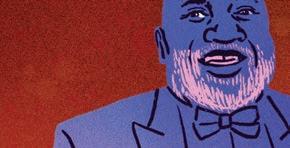
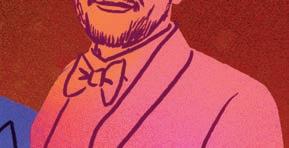




Donald M Bell (He, Him, His) 74, and Christopher Walters (He, Him, His) 31, exemplify the extraordinary intergenerational relationships that can be shared by cisgender African American same gender loving men. A er meeting at a StartOUT entrepreneurial event, the relationship quickly grew from professional to personal to familial. Donald has provided Christopher with the history, legacy, and connection within the community which resulted in Christopher joining Donald as the youngest member of the Board of Directors of One Roof Chicago. Christopher has provided Donald with a connection to the contemporary and assurance of community leadership for the future as exemplified by Christopher escorting Donald to the Center on Halsted Gala to receive the 2024 Human First Award. This intergenerational relationship is airtight!

















































































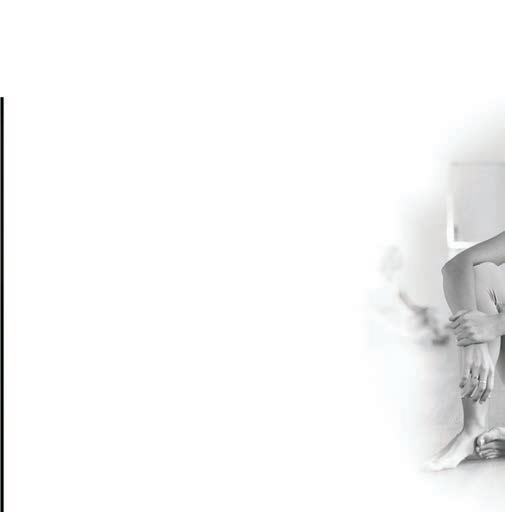






JUN 19
TROMBONE SHORTY & ORLEANS AVENUE with BIG BOI DANIELLE PONDER
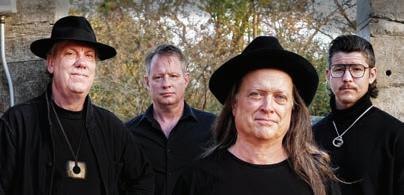
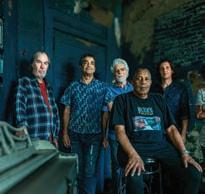

JUN 21
VIOLENT FEMMES with THE CHICAGO PHILHARMONIC
PERFORMING THEIR DEBUT ALBUM

JUN 22
LITTLE FEAT + LOS LOBOS
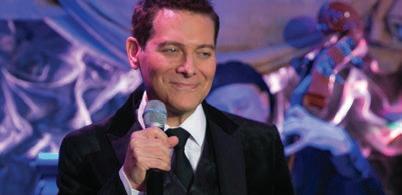
JUN 23
MICHAEL FEINSTEIN
“BECAUSE OF YOU” MY TRIBUTE TO TONY BENNETT featuring THE CARNEGIE HALL BIG BAND
VOL 39, NO. 2 JUNE 13, 2024

Jenn and Leslie Henry discuss their life together—and the challenges living with Alzheimer's can pose
BY JAKE WITTICHLeslie and Jenn Henry, a lesbian couple active in Chicago’s LGBTQ+ community for more than a decade before moving to Michigan, met in 2010 at the Back Lot Bash, an annual Pride party for queer women held in Andersonville.
Jenn, who had been partying all weekend, recalled hearing Leslie’s voice for the first time. Leslie mentioned she was about to leave the festival early, to grab a coffee and head home to walk her dog.





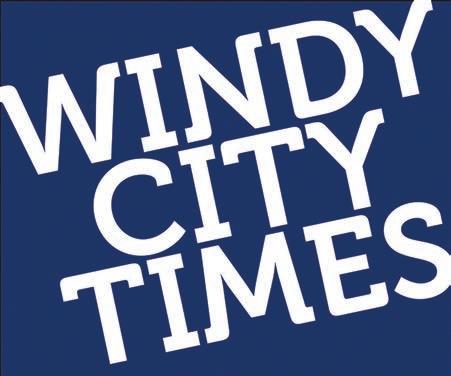
Editorial













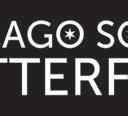
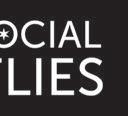
The encounter was brief, but the two ran into each other again a week later at a post-Pride Parade barbecue hosted by Jenn’s ex-girlfriend, whom Jenn was still friends with. The two hit it off, and within a couple of weeks, they had their first date: drinks and dancing at Charlie’s Nightclub in Andersonville.
“I had been drinking a little wine on my deck that afternoon, and then Leslie shows up and tells me she had just done a triathlon,” Jenn said. “So she’s leaving [Back Lot Bash] to get coffee and running triathlons like a complete overachiever. That’s a level of responsibility I never had that she brings to my life.”
The two dated for two years and got married Oct. 6, 2012. Since then, they’ve continued to bond over their love of community service and travel, while overcoming a range of challenges.
Those memories feel like “a different life now.” Leslie was diagnosed with Early-Onset Alzheimer’s Disease in 2023. That diagnosis completely upended their lives together, Jenn said.
Leslie left her job as a business project manager at Deloitte to navigate life with the disease, while Jenn is also staying home as her caregiver. Social outings like street festivals or bar nights have been replaced with nights in, watching true crime shows and working together to maintain a regular routine.
“It’s challenging, but there’s this daily hope that keeps us moving forward,” Jenn said. “I hope everyday is a good day. I hope I’m a good caregiver. And I hope that Leslie always feels safe and happy. Those are my goals for this journey.”
Receiving the Alzheimer’s diagnosis
Alzheimer’s, one of the most common forms of dementia, is a progressive disease that destroys memory and other important mental functions due to brain cells and their connections degenerating and dying. The disease is most common among older adults, but can affect people in their 30s through early 60s, which is known as Early-Onset Alzheimer’s.
Leslie received her diagnosis at 53 years old. Her father has vascular dementia, but the family opted not to do genetic testing that would determine if it runs in the family.
When Leslie Henry first started showing signs of dementia, she and Jenn Henry attributed it to fatigue from being a workaholic. Leslie Henry spent more than a decade in leadership positions at Bank of America and nearly five years at Deloitte. She’s also played an active role within the LGBTQ+ community.
“I remember going to T’s Bar with Leslie not long into dating her and she warned me, ‘I’m going to know a lot of people here,’” Jenn said. “And then we walked in and she was immediately accosted. She knew everybody in the community.”
Leslie’s community involvement continued throughout her career, she recalled. She served on the board of the Victory Fund, a political action committee dedicated to electing LGBTQ+ public officials, and served on the advisory board for Lesbians Who Tech, an organization
increasing representation for women in the technology field.
Other organizations Leslie Henry was involved in include Girls in the Game, Lambda Legal’s Women’s Diversity Council and DEI groups at Bank of America and Deloitte, she said.
So when Leslie Henry accidentally left the water running in 2019, causing minor flooding in the downstairs neighbor’s bathroom, Leslie and Jenn attributed it to Leslie being overworked.
“She would always get so hyper-focused on what she was doing, so I just thought it was workaholism or menopause,” Jenn said.
But Leslie started to suspect the issue might be deeper when she started running red lights while driving and couldn’t explain why.
“It was scary because I didn’t know what was happening with me,” Leslie said.
Things came to a head when Jenn Henry got a late payment notice on a credit card the two of them always kept locked in a safe. Leslie had somehow accessed the safe and used the card to make $170 worth of app purchases, but had no recollection of doing so, Jenn said.
Jenn Henry reported the charges as fraud but realized hours later what had happened.
“That’s when we made our appointment with the neurologist,” Jenn Henry said.
On Feb. 22, 2022, the couple went into Trinity Health IHA Medical Group in Michigan for an evaluation. Leslie failed a mini cognitive test, leading the doctor to suspect the issue was Early-Onset Alzheimer’s.
But the formal diagnosis wouldn’t come until January 2023, after Leslie went through a series of doctor’s visits, psychological tests, MRIs and speech therapy, Jenn recalled.
“It wasn’t fun,” Leslie Henry said. “Especially because I’m a workaholic. It was like, ‘What do I do now?’”
Adapting to life with Alzheimer’s
Leslie said Alzheimer’s makes it harder for her to express thoughts in words or keep track of things, she said.
“I have trouble getting things out,” Leslie said. “I also have difficulty with my phone, or sometimes I’ll lose words or my things. Jenn is always like, ‘Did you lose your phone again?’ But there’s nothing I can do about it.”
Leslie manages the disease by staying active through working out and other activities, she said. Leslie stays physically active by using a Peloton and taking boxing classes.
“Jenn is my calendar,” Leslie Henry said. “She’s the one who got the Peloton and keeps me on track with all these activities, because it’s so important to exercise your brain.”
Maintaining a steady routine is also key, and straying from it can be “discombobulating,” Jenn said.
“We really just take it one day at a time and keep very open communication between the two of us,” Leslie said. “We’re not afraid to talk about Alzheimer’s.”
The couple also found keeping a sense of humor helps navigate the challenges brought on by Alzheimer’s, they said.
“Like the other day, she was trying to tell me to pull forward in the car, but the words
wouldn’t come to her, so she just made a funny noise and silly gesture with her finger. We thought it was hilarious,” Jenn said. “You have to be able to laugh when you’re faced with this stark reality.”
Leslie is also involved in support groups for the Alzheimer’s Association, a nonprofit that leads research on the disease while supporting people living with it and their loved ones.
“It gives me other people to talk to, and a sense of purpose, if anyone in the group needs my help or someone to talk to about something,” Leslie Henry said.
In April, Leslie and Jenn Henry traveled to Washington, D.C., for the Alzheimer’s Association’s Advocacy Days. There, they were able to connect with other people who are navigating life with dementia and share their story with legislators and other powerful decision-makers, Jenn.
Some of the issues affecting families navigating an Alzheimer’s diagnosis include financial strains due to a lack of social security benefits for caregivers in some states, Jenn said. The conversations those days centered on reducing stigma.
“It was powerful because you see there’s a lot of us going through this,” Leslie said. “And by sharing our story, we’re able to advocate for changes that will hopefully make this easier for people who live with Alzhiemer’s after us.”
“I’m most excited about that because my dad would take my brother, mom and I to Niagara Falls, but Jenn has never been,” Leslie said. “It might be a little overwhelming because you’re gonna be underneath the falls and just get drenched, but it’s absolutely beautiful.”
The couple also traveled to Phoenix, Arizona, last year to see Brittney Griner’s home opener game at the Footprint Center. Many of Leslie’s

‘Memories for us and experiences for less’
After Leslie Henry was diagnosed with Alzheimer’s, she created a bucket list of things she wants to do before the disease progresses too far. She got the idea from a workbook she was gifted by one of her nieces or nephews, she said.
“There are some really funny things in there, like ‘eat an insect,’” Leslie Henry said. “Well that’s not happening. But it got me thinking about what I want to do.”
One of the bucket list items Leslie Henry checked off last year was going to the Brandi Carlile concert at the Red Rocks Amphitheatre in Colorado. She also visited the National Museum of African American History and Culture while in Washington, D.C., for Advocacy Days.
In October, the couple plans to visit Salem, Massachusetts, to celebrate Halloween and then take a trip out to Niagara Falls, Leslie said.
bucket list items center around travel, but getting out of state is more difficult now due to the progressing Alzheimer’s, Jenn said.
“It can be hard to navigate travel, but we’ve found that physically driving in a car is much easier than flying for us,” Jenn said. “That’s going to be the mode of travel for us going forward because you don’t have to deal with the crowds, TSA lines and things like that.”
The bucket list originally focused more on large trips, like to Europe or across the country, but as Alzheimer’s has progressed, Leslie said she’s more focused on spending quality time with her family.
“We’re making memories for me and experiences for Leslie,” Jenn said. “At the end of the day, this is what will sustain us: the memories.”
For information about Alzheimer’s, visit the Alzheimer’s Association at alz.org.
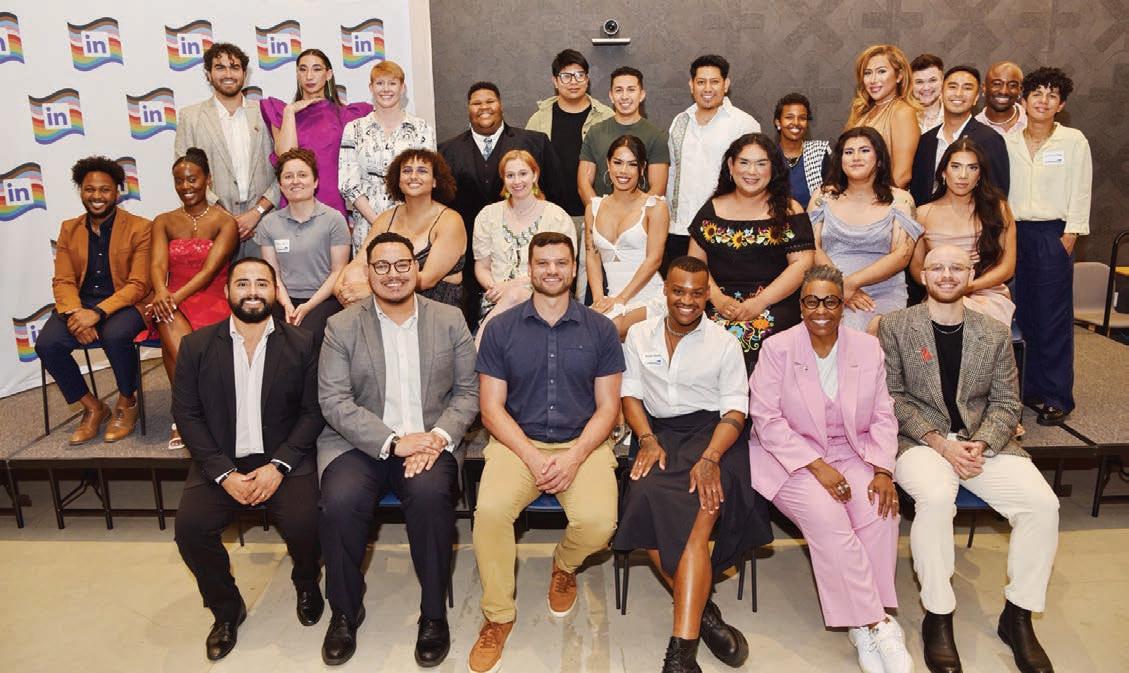
Windy City Times celebrated Pride Month by reviving its annual 30 Under 30 Awards.
The ceremony took place June 6 at LinkedIn’s Chicago headquarters at 525 W. Monroe St. Event sponsors included AIDS Foundation Chicago (AFC), Pride Action Tank, Windy City Times, LinkedIn, Monarq Advisors, Geof and Joshua Brown, Center on Halsted, Equality Illinois, Chicago History Museum/OUT at CHM and Fifth Third Bank.
AFC Vice President of Special Projects & Innovation, Policy and Advocacy Kim Hunt (who is also executive director of Pride Action Tank) and LGBTQ+-rights activist Jose “Che-Che” Wilson co-hosted the ceremony.




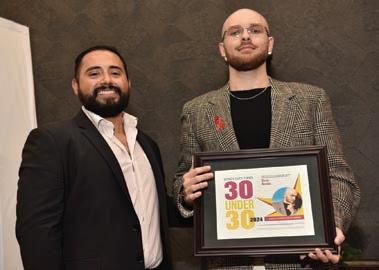
The award recipients were honored for making substantial contributions to the Chicagoland LGBT community in the fields of entertainment, politics, health, activism, academics, sports or other areas. Hundreds of people have been honored by the paper in the more than 10 years since the awards were established.
—Andrew Davisby Kat Fitzgerald (www.mysticimagesphotography.com)
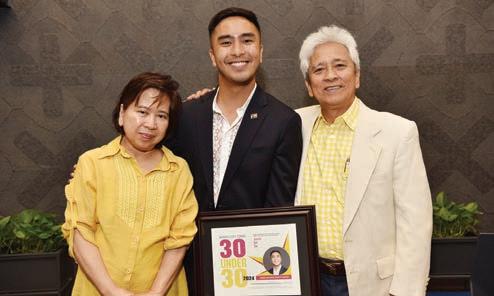
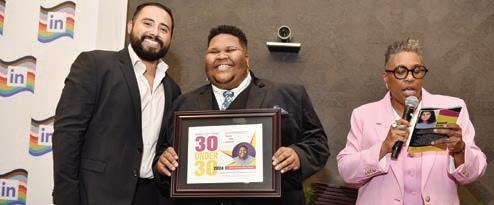

This story is part of the Digital Equity Local Voices Fellowship lab through News is Out. The lab initiative is made possible with support from Comcast NBCUniversal.
Note: This article contains discussion of mental health issues such as suicidal ideation and attempts.
When speaking with Tyris Manney, a few especially noticeable attributes come to the fore— his brilliant smile, his way with words and his almost literally glowing skin.
The latter is a result not just of his personal skincare line, but of a long journey to combat self-esteem issues. Starting in 2018, Tyris Manney Beauty has been more than just a passion product for the young Chicagoan—it’s been an integral part of his mental health recovery journey.
Manney, 26, grew up on Chicago’s South Side around the Chatham neighborhood. He comes from a big family and was raised by a single mother. His family has continued to be a major form of support for him throughout his adult life and business ventures.
Although Manney’s mother initially tried to get him into baseball, he was never interested in sports. He always had an interest in beauty, fashion, music and other artistic pursuits.
In high school, he and a friend got the idea to start a business combining fashion, makeup and beauty. Once they graduated, Manney ended up starting his own clothing line; he revamped vintage clothes and fabrics to create new pieces, and ran it basically by word-of-mouth for a couple of years.
Around 2018, Manney started to experience more skin-related issues—dark spots, acne, clogged pores, etc.—with no products on the market really working for him physically or financially. He also dealt with serious mental health issues around this time. His skin issues only added onto his already low self-esteem. That year, Manney attempted suicide. As he worked to recover and get his depression under control, he tried to determine how to improve his skin himself. With nothing currently on the market able to heal these physical and mental issues, he took matters into his own hands. At the time, he thought skincare was just something chemists could do. But the “do or die situation” of his mental health pushed him to take the leap into creating products.
“I started learning to formulate my own skincare products by taking courses on formulation and the proper way of mixing ingredients,” he
said. “I went to YouTube as well. I bought books. I did a whole bunch of stuff to prepare myself.”
While creating products, Manney used simply-formulated, plant-based, organic ingredients—other products often required more professional equipment, or ingredients that were so harsh on the skin only small percentages of them could be used. He wanted his products to be accessible to everyone, helping all skin types on all types of people.
Manney started out with just two initial products for himself, but soon enough he was giving them to others. He was working at Buffalo Exchange at the time, and his first customer was a coworker who asked if he could make her something for her skin—when Manney brought it to her, she slid her money under the table. Before long other coworkers would buy products from him every single week, and then in turn recommend him to more of their friends.

“I’d bring my products to work,” Manney said. “And right after work I would be standing on the corner in Wicker Park giving people their orders.”
Taija Weakley, one of Manney’s friends since childhood, has followed his progress since he began his work. After seeing Manney post photos of his skin on social media, Weakley reached out to find out what products he was using. She’s a personal fan of TMB products such as the Apple Juice serum, face cleanser and shea butter.
Weakley said Manney has always been a very hardworking and determined person, and she’s enjoyed watching him and his brand grow.
“He’s very ambitious, he’s very about his business and he knows what he’s doing,” she said. “He’s a very kind-hearted person. He’s a very strong person.”
Recently, Manney went through Chicago’s LGBT Chamber of Commerce bootcamp. Although it was an intense experience, he said, it taught him about marketing and branding. For 10 weeks, participants needed to be ready to work on their business plans while assessing themselves outside of the boot camp.
small Black-owned business, was gratifying, and he’s been buying them ever since.
He described Manney’s apple juice product as “liquid gold.”
“It’s not as many steps or processes as the competitors are,” Winters said. “When I think of skincare, I think of having to do this and that and don’t forget this, but his is so simple.”

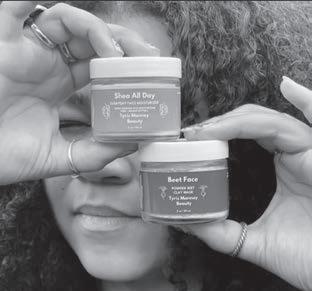
The program allowed Manney to learn about his own work ethic and the potential for his business to go to the next level. He also connected with other entrepreneurs and learned from their experiences and skill sets.
Being Black and queer in the beauty space has been difficult, but Manney has received support from his family and boyfriend throughout the process of growing his business. He said he also had felt that same support when he first came out as gay.
“My foundation has always been really solid,” he said. “I’ve always been able to hold my head high with my identity.”
While he’s a minority in his industry, he met lots of Black entrepreneurs through his experience in the boot camp and built community with them. But he’s been acutely aware of the lack of representation within the beauty industry and its lack of resources for folks like him. He knows he has to be the one to breaking barriers and creating welcoming spaces.
About two years ago, Manney did a pop-up shop where he met future recurring customer Trell Winters. Winters said seeing Manney’s products at the event, which was promoting
Manney’s beauty line is a fully self-funded business, and he recently jumped into running it full time, leaving a corporate job behind.
Within the next year, Manney has set a goal for $113,000 in sales. Although it’s a big leap from under $50,000 this year, he said the boot camp gave him the confidence to believe that, if he puts in the work, he can make it happen. Two years from now, he hopes to also outsource the creation of products. Right now, it’s just him and as-needed help from family, along with freelancers for social media and photography. By three years from now, he’s hoping to be able to place products in stores like Ulta.
Manney is also considering a fundraising campaign on his website, to both fund marketing campaigns and continue providing ethical skincare. He also plans to reach out for partnerships with mental health organizations.
Now nearing five years of running his brand, he’s no stranger to positive customer feedback. Throughout his brand’s existence, he’s received messages from folks who are proud he’s continued to pursue his passion for skincare. He’s rebranded a few times as well, and each time he’s felt the excitement from people around him and gotten to see their testimonies about his products.
“People support people that they know, they like, they love, and they trust,” he said. “The fact that I’ve been in it for so long and they personally know someone [running a] skincare line, I’ve gotten so much love.”
If you are in crisis, please call, text or chat with the Suicide and Crisis Lifeline at 988, or contact the Crisis Text Line by texting TALK to 741741.
Main photo: Tyris Manney. Photo by Moorcroft PhotographyA group of librarians recently launched a free online LGBTQ+ library with more than a thousand ebooks and audiobooks that anyone in the United States can access.


Queer Liberation Library—or QLL, pronounced “quill”—launched in October 2023 and its volunteer curators are dedicated to creating a collection that reflects the diversity of the LGBTQ+ community.
Users sign up for a virtual library card at the website. Once their application is approved, they can access items from the library’s collection on Libby, a free app that libraries use to distribute online materials to their patrons.
Queer Liberation Library was founded by a small group of volunteers who wanted to ensure queer reading materials were accessible to people throughout the country, regardless of what’s available at local libraries.
“With the current climate and book bans and lack of access, there’s a need that we’re happy to fulfill,” said volunteer Amber Dierking. “But there’s also just such a delight and joy to be able to do something like this. So, we’re not just filling a need but also having fun with it along the way.”
It took nearly two years to raise funds, create a website and build out the resource. Organizers chose to create a digital library because it required fewer resources to launch and the collection would be more widely accessible, Dierking explained.
More than 40,000 people currently use the library.
“It is a simple fact that more books have been published about cis gay men than aromantics or intersex people, for example,” Queer Liberation Library’s website reads. “Knowing this, we will actively seek out materials from all parts of the LGBTQ+ community, to resist replicating the historical and ongoing bias within the publishing world.”
Queer Liberation Library is funded entirely by donations. Purchasing ebooks and other on-
remain in the collection.
“We’re trying to be smart about building a sustainable collection and trying to be thoughtful with the kinds of licenses we’re buying so we can get the most out of the limited amount we have to spend,” Dierking said.
People can make recurring donations to support Queer Liberation Library’s work, which help organizers to plan for the future. Signing up for a library card is another way to show support,

Tens of thousands of people signed up for library cards after a TikTok showcasing the resource went viral.
New materials are added to the library each month and its organizers regularly survey members to learn more about what they’re interested in checking out. People can also suggest titles on the library’s website.
Queer Liberation Library is filled with more than a thousand materials that “inspire, celebrate, entertain and educate queer folks,” according to its website. Dierking said they’re trying to provide texts that might be difficult to access in other libraries and prioritizing content from independent creators and living authors.
“When libraries buy copies of something, authors get a portion of those royalties,” Dierking explained. “We love to support authors in that way. We’re trying to balance buying from indie publishers with getting popular books that people really want to read. We hope to keep expanding over time.”
Organizers are “committed to curating a collection that reflects the diversity of queer lives and imaginations,” according to the library’s website. BIPOC voices are a core component of the collection, and curators are working to better highlight other areas of the LGBTQ+ community that have also been historically underrepresented.
line resources can be more expensive than buying physical copies, and each copy comes with its own requirements surrounding how many people can use it at once and how long it can
since that helps organizers demonstrate there is a need for this resource when fundraising and applying for grants, Dierking explained.
See www.queerliberationlibrary.org .
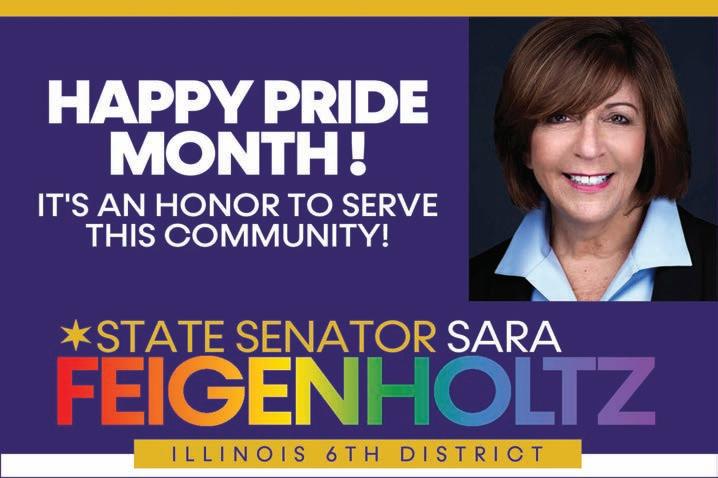

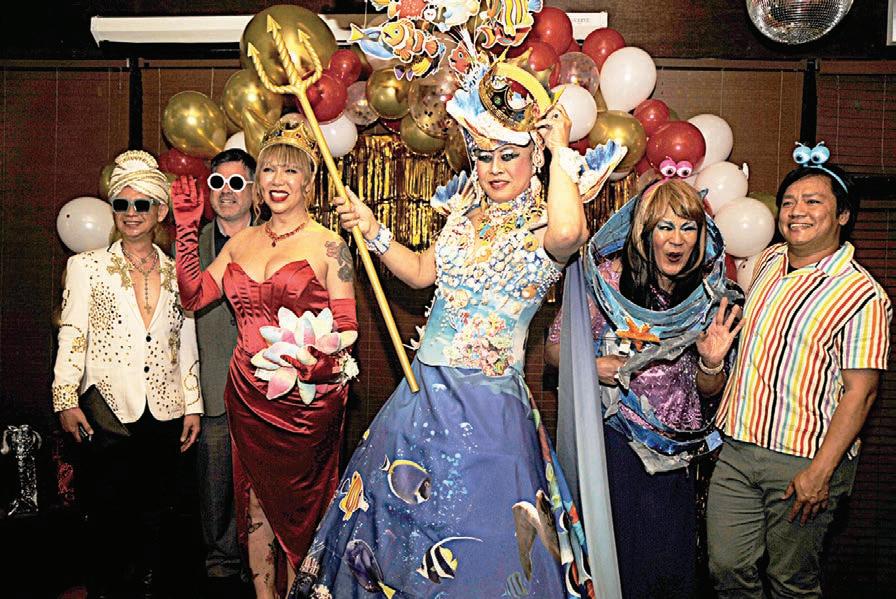
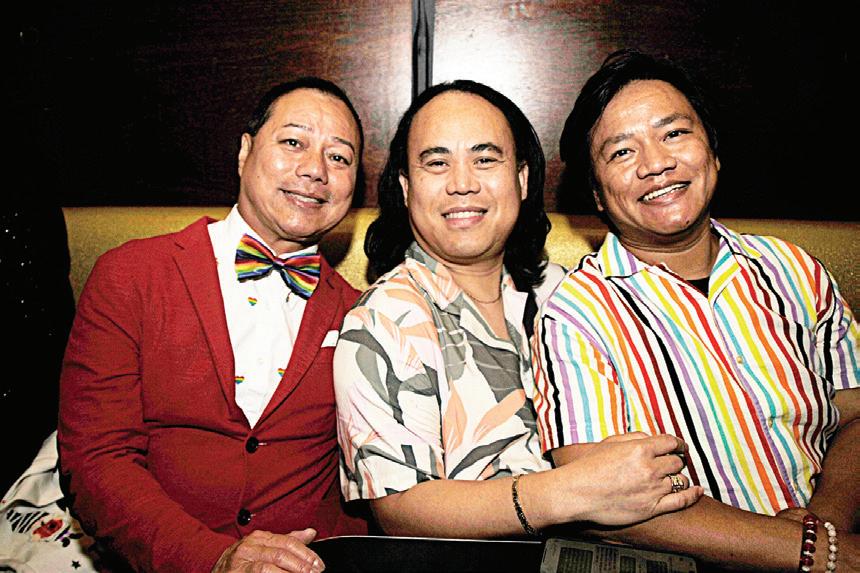

On May 18, Asians and Friends held its first LGBTQ+ prom at the Holiday Club, 4000 N. Sheridan Rd. The event both benefited Humble Hearts, a local organization providing support for under-resourced Chicagoans, and previewed the oceanic theme of the organization’s float in the 2024 Chicago Pride Parade.


This is only a brief summary of important information about BIKTARVY® and does not replace talking to your healthcare provider about your condition and your treatment.
BIKTARVY may cause serious side e ects, including:
� Worsening of hepatitis B (HBV) infection. Your healthcare provider will test you for HBV. If you have both HIV-1 and HBV, your HBV may suddenly get worse if you stop taking BIKTARVY. Do not stop taking BIKTARVY without first talking to your healthcare provider, as they will need to check your health regularly for several months, and may give you HBV medicine.
BIKTARVY is a complete, 1-pill, once-a-day prescription medicine used to treat HIV-1 in adults and children who weigh at least 55 pounds. It can either be used in people who have never taken HIV-1 medicines before, or people who are replacing their current HIV-1 medicines and whose healthcare provider determines they meet certain requirements.
BIKTARVY does not cure HIV-1 or AIDS. HIV-1 is the virus that causes AIDS.
Do NOT take BIKTARVY if you also take a medicine that contains:
� dofetilide
� rifampin
� any other medicines to treat HIV-1 BEFORE TAKING BIKTARVY
Tell your healthcare provider if you:
� Have or have had any kidney or liver problems, including hepatitis infection.
� Have any other health problems.
� Are pregnant or plan to become pregnant. It is not known if BIKTARVY can harm your unborn baby. Tell your healthcare provider if you become pregnant while taking BIKTARVY.
� Are breastfeeding (nursing) or plan to breastfeed. Talk to your healthcare provider about the risks of breastfeeding during treatment with BIKTARVY.
Tell your healthcare provider about all the medicines you take:
� Keep a list that includes all prescription and over-the-counter medicines, antacids, laxatives, vitamins, and herbal supplements, and show it to your healthcare provider and pharmacist.
� BIKTARVY and other medicines may a ect each other. Ask your healthcare provider and pharmacist about medicines that interact with BIKTARVY, and ask if it is safe to take BIKTARVY with all your other medicines.
BIKTARVY may cause serious side e ects, including:
� Those in the “Most Important Information About BIKTARVY” section.
� Changes in your immune system. Your immune system may get stronger and begin to fight infections that may have been hidden in your body. Tell your healthcare provider if you have any new symptoms after you start taking BIKTARVY.
� Kidney problems, including kidney failure. Your healthcare provider should do blood and urine tests to check your kidneys. If you develop new or worse kidney problems, they may tell you to stop taking BIKTARVY.
� Too much lactic acid in your blood (lactic acidosis), which is a serious but rare medical emergency that can lead to death. Tell your healthcare provider right away if you get these symptoms: weakness or being more tired than usual, unusual muscle pain, being short of breath or fast breathing, stomach pain with nausea and vomiting, cold or blue hands and feet, feel dizzy or lightheaded, or a fast or abnormal heartbeat.
� Severe liver problems, which in rare cases can lead to death. Tell your healthcare provider right away if you get these symptoms: skin or the white part of your eyes turns yellow, dark “tea-colored” urine, light-colored stools, loss of appetite for several days or longer, nausea, or stomach-area pain.
� The most common side e ects of BIKTARVY in clinical studies were diarrhea (6%), nausea (6%), and headache (5%).
These are not all the possible side e ects of BIKTARVY. Tell your healthcare provider right away if you have any new symptoms while taking BIKTARVY.
You are encouraged to report negative side e ects of prescription drugs to the FDA. Visit www.FDA.gov/medwatch or call 1-800-FDA-1088.
Your healthcare provider will need to do tests to monitor your health before and during treatment with BIKTARVY.
Take BIKTARVY 1 time each day with or without food.
� This is only a brief summary of important information about BIKTARVY. Talk to your healthcare provider or pharmacist to learn more.
� Go to BIKTARVY.com or call 1-800-GILEAD-5.
� If you need help paying for your medicine, visit BIKTARVY.com for program information.
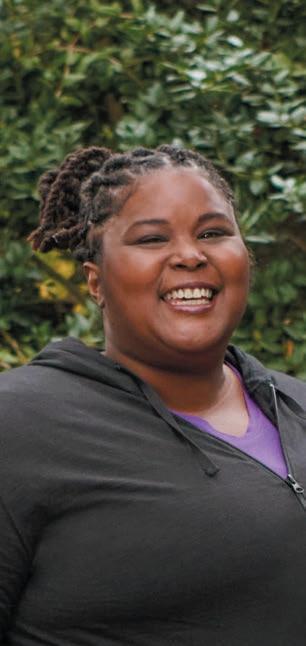
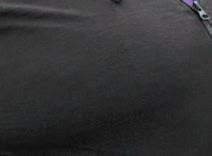



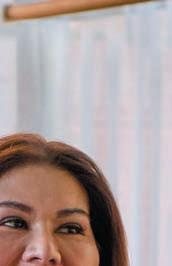





#1 PRESCRIBED HIV TREATMENT*



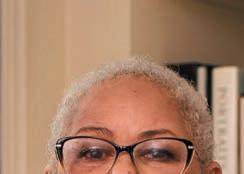





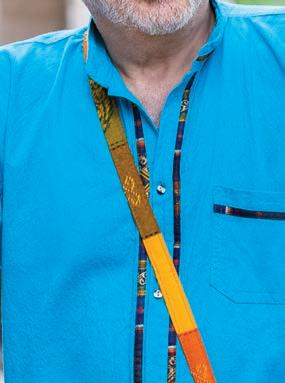






New York comedian and author Rob Anderson just released a new book called Gay Science: The Totally Scientific Examination of LGBTQ+ Culture, Myths, and Stereotypes. Inspired by his viral Gay Science video series, Anderson’s now gone back and recreated several lessons from the series for the page.
Gay Science contains 60 topics including nutrition, genetics and chemistry, among many other science-related subjects. Anderson met up for lunch before his Chicago book signing at City Lit Books in Logan Square.
WCT: Did you study science in school?
RA: The basics and what was required for college. I always loved it, but I didn’t major in it or have a degree in science.
WCT: Did you ever make a science project?
RA: Of course. I feel like we have all done them! I once made a science project about color and light. I had filters with magenta and cyan to show how they work, but it wasn’t thrilling or anything.
WCT: You were making rainbows even back then.
RA: Actually, yes! I always wanted to make the stereotypical volcano thing, but I don’t know if anyone actually makes them.
WCT: Like The Brady Bunch! Was this at the Carly Gay Jepsen University?
RA: Yes! [laughs]
WCT: Gay history and science aren’t taught in schools because of politics.
RA: No and we have to be curious enough to find out on our own. That’s not just the case for queer history, but different races with their history that were also not taught. I would say it
tried to be as inclusive as possible.
The video series was mainly about gay men and lesbians, just because that was who I was familiar with the most in my life. That is really saying more about our culture because we all socialize within our own groups so much. I wanted to have chapters for intersex, trans and asexual people across the spectrum, but that was difficult because I don’t have that as my experience. As a gay man, I know what I can say about gay men, but I don’t know what I can say about the rest of the community.
The chapters about different groups are about the people who misunderstand them. I punch up at those people, not at our community.
WCT: What would you like readers to take away?
is getting better, but it is actually getting worse.
WCT: At least it is somewhat better with higher education. What photo shoot did you most enjoy creating for this book?
RA: The photo for the bidet and getting the hose outside didn’t work. It was a fun try and in the end, it was effective and looked like it was in a lab.
WCT: How much research did you do for the gray sweatpants section?
RA: My whole life I have been researching and I still do to this day! When I was creating the book around the episodes I was posting about it and it kept getting taken down. They are just gray sweatpants, but people were reporting it to be removed.
WCT: Why do you feel “Dolly Parton lives in every cell of gay people,” as stated in the book?
RA: Dolly is a force with a gay mentality. During any interview that I have watched, she is so cool. She is honest, doesn’t take herself too seriously and is still a good person. The essence of Dolly Parton is so queer to me. It is the best part of us and that is why I think she is in all of us. She is in drag in a way too!
RA: I want them to have fun. It is a pure source of entertainment. I hope they laugh and take a break from the negativity that is surrounding us politically. We are fun people who like to make fun of ourselves. Sometimes we are not allowed to because we are fighting for equality or equal rights.
It is a source of entertainment, although there are nuggets of real points that I am mak-
ing along the way. It’s mixed in and out of the satire, so some people may miss the references.
WCT: Why did you start your video series in the first place?
RA: I wanted to explain why gay men love iced coffee, which was a hilarious stereotype that is true for me and my friends. Everyone enjoyed the video so I made another one. I did that for three years and made over 50 of them. I wanted to make a textbook version of the videos with little sidebars that readers could try at home.
WCT: Would you ever make a sequel to your book?
RA: I will definitely write another book. I loved the process of it. I liked taking the page and cramming a bunch of Easter eggs and jokes into it. I wanted it to feel like a video where someone missed a joke so they would reread it. Gay Science is 240 pages of jokes about queer culture and it was a lot! I wrote every word and made every chart. It is all from my brain and will be good for a long time!
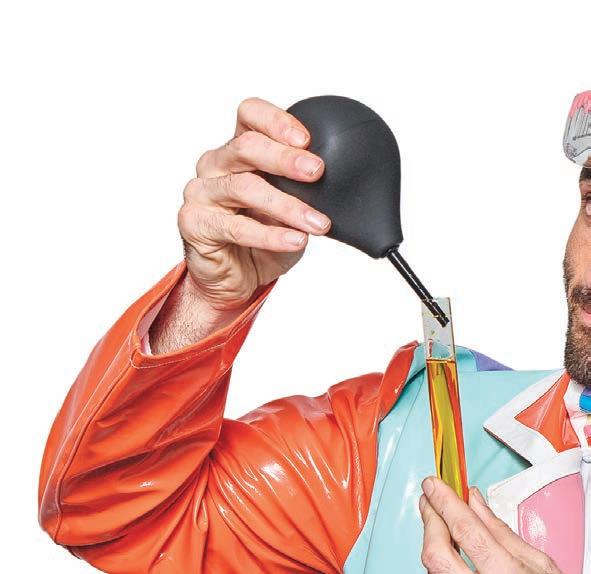
WCT: You mentioned Kim Petras in your book as well. Are you a fan?
RA: I love Kim Petras. I have met her and we have done videos together. In the book, I was making a comment about how gay people like her sexualized music.
WCT: What audience are you looking for with this book?
RA: The book was “dedicated to the girls, gays, and theys,” so that is who the book is for. It is for everyone in the queer community, and I
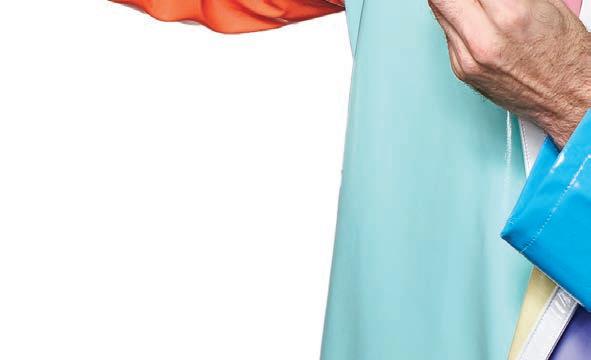 Comedian Rob Anderson, author of Gay Science. Courtesy of Anderson
Comedian Rob Anderson, author of Gay Science. Courtesy of Anderson










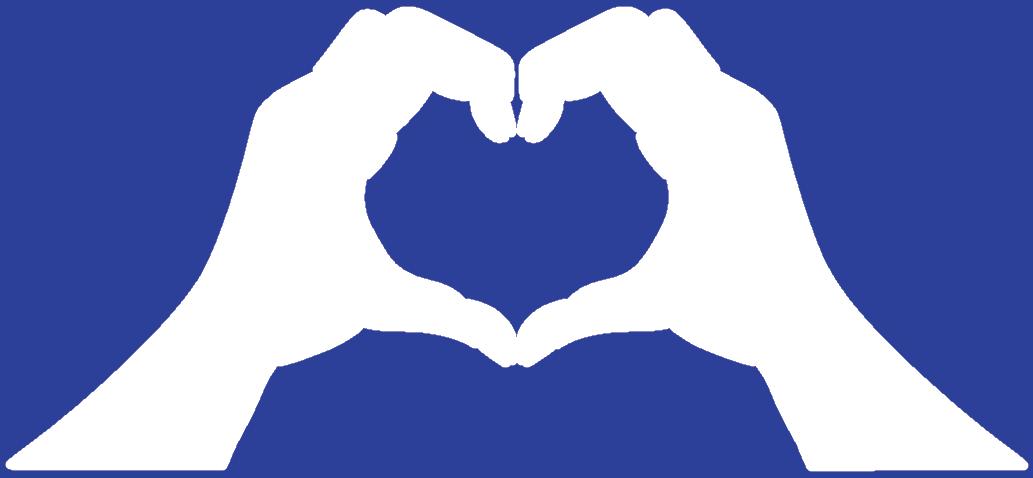





















For just about everyone, life is hard enough. However, talking about ending that life—especially when one is terminally ill—is just as difficult.
Ten states have authorized medical aid in dying, although Illinois is not one of them. Deb Robertson, a 65-year-old Lombard resident (and member of the LGBTQ+ community) who is a retired social worker, would like for this state’s status to change.
Robertson has a very good reason for that. She has been diagnosed with incurable stage four neuroendocrine carcinoma—a rare form of cancer that is very aggressive.
“Two years ago, I was diagnosed with [this] terminal cancer,” Robertson said. “I was a very healthy individual. I was working a lot and was very much into pickleball. I’m sad and angry that I can’t play like I used to.
“I was cold-cocked [by the diagnosis]. I went to the doctor for a slight pain in my side and it turned out to be this carcinoma. The doctors gave me less than a year to live and I’ve outdone that, and they nicknamed me ‘The Warrior.’
“Of course, my whole life changed. I had to retire and I couldn’t play because they put me on chemo, which worked well initially. But [the cancer] came back within three months and it’s progressing a little more—and I can feel it. I’m on my fourth different kind of chemo.”
Robertson said she believes that the extra time she has “been given from God is so I can
be an advocate for medical aid in dying. When I originally got involved with medical aid in dying with [end-of-life advocacy group] Compassion & Choices, I had always been an advocate. My whole life, I’ve worked with young people and I’ve developed programs for homeless and marginalized—especially LGBTQ+—youth. I did that for 30 years; all of a sudden, to not be able to work was devastating to me.
“What I decided was that I needed to find something I was truly passionate about again, to take up the time while I was dealing with all of these life-changing things. So I did research on medical aid in dying, and I called Compassion & Choices.”
However, Robertson revealed that she had “thought about medical aid in dying long before I was diagnosed with this cancer. When I was about 21—my mother’s a doctor and both of my sisters-in-law are nurses—I would always say, ‘I don’t want to die all shriveled up, in excruciating pain and with someone wiping my rear end. So I need someone to commit to that not happening to me.’ I never thought I’d really have to think about this possibility.”
Having this disease has provided Robertson an opportunity to connect with others who have the illness—but there is a serious downside: “I have a group of people all over the world who are on a Zoom call on Thursday nights. Because it’s such a rare cancer, they can’t do clinical trials and research. There are 11 people I’ve watched in the past 18 months who have died painfully from this cancer, so I know it’s going to get ugly and that there’s a possibility I won’t be here for the approval of the bill.”
The bill Robertson referred to is the End of Life Options for Terminally Ill Patients Act (SB 3499), which activists hope the Illinois legislature passes during the spring session. Introduced by Democratic state Sen. Linda Holmes, the measure authorizes a qualified patient with a terminal disease to request that a physician prescribe aid-in-dying medication that will allow the patient to end the patient's life in a peaceful manner.
Some critics have contended that doctors would be violating the Hippocratic oath by participating in terminating someone’s life; the opponents also question what the patient’s state of mind might be when making this decision and some also adhere to religion as a reason. Robertson has heard these criticisms and even
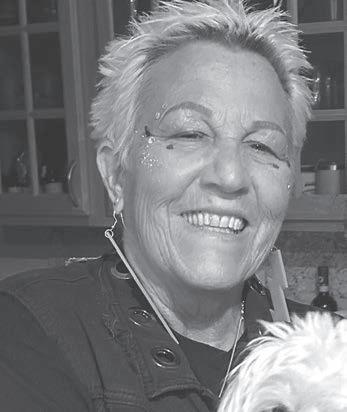 Deb Robertson.
Photo courtesy of Robertson
Deb Robertson.
Photo courtesy of Robertson
had to convince someone close to her: “My brother was a doctor—and he didn’t support [medical aid in dying], initially. So we sat down and talked about it. Now, he understands the whole process. When that bill passes, he will have that option to participate—or not participate. Now he’s supportive of it.”
Robertson feels that religion is a dominant factor as well as the oath, but noted, “My response to [the oath argument] is that people become doctors because they want to help people. Some doctors offer palliative care, but sometimes that’s just not enough. Being shot up with morphine until you’re not moving is [not necessarily helpful]—you don’t know if people are still in pain because they can’t communicate because they’re all doped up. Also, if the cancer [spreads to] my brain, communication will be an issue.
“The argument about medical aid-in-dying being suicide is ridiculous. I spent 30 years helping people not commit suicide and they were struggling with mental-health, gender and LGBTQ+ issues as well as trauma.”
One factor in Robertson’s favor is her support system. “My family, my grandchildren and my wife [Kathleen] told me that they’d continue [advocating] if I’m not around to see the end,” Robertson said, her voice choking with emotion. “It’s about saying goodbye the way I
want to say goodbye.
“I individually met with my grandsons, who are 15 and 17, to explain to them what it’s all about, because we’ve been getting some press. One of them is emotional and asked, ‘Granny, if it becomes legal, does that mean you’re going to die next week?’ The other grandson is very [logical] and asked, ‘Granny, I just don’t understand why the other states aren’t making this okay.’ That, to me, was very telling.”
And regarding Kathleen, Robertson said, “My wife is very emotional, and always has been. It’s been a lot for her. She’s 66 and is still working because we need the insurance for my medications and chemo. If we went on Medicare, a lot of the medicines are not necessarily recognized by the medical profession.
People have suggested to Robertson that she could move to a state that allows medical aidin-dying—but she steadfastly refuses. “Why in God’s name would I leave my family and friends to go to a strange place with strange doctors?,” she asked. “It makes no sense.”
“I want to do everything that I possibly can while I can speak,” Robertson added. “I think a lot of it is about education—to help people understand what medical aid in dying is really about. It’s not physician-assisted suicide or something related to Dr. Kevorkian. It’s really a well-thought-out decision that I think everyone should be able to make on their own. It’s fine if you don’t want to do it; just don’t stand in the way of it being an option for me. It’s about respecting someone’s beliefs and journey. I didn’t choose to have this diagnosis. This passion is what keeps me going.”
When asked what she wanted her legacy to be, Robertson responded, “It’s funny that you ask that. That’s one of the first things I thought about when I was diagnosed. I want to be remembered for trying to make a difference in the world. Medical aid-in-dying is my [current] passion, but I really want to be recognized for my efforts in helping young people.”
She recently received an award from Naperville-based 360 Youth Services for being its most influential employee ever: “I was with them for [more than 20] years. Getting that award was huge for me, because I retired but still served on committees and was a consultant.”
And, now, this warrior will keep fighting a very personal battle.

The Gates of Time Square is considered Chryssa's magnum opus. Photo by Jake Wittich
‘Chryssa & New York’ exhibition spotlights queer sculptor who worked in neonBY JAKE WITTICH
Dozens of sculptures by Chryssa, a queer woman who was a pioneering neon-bending artist in the ‘50s and ‘60s, are now on display at Wrightwood 659, 659 W. Wrightwood Ave., in Lincoln Park.
“Chryssa & New York” features more than 80 works by the artist that were made during her time in New York City, where she emigrated to from Greece. The exhibition runs through July 27.
Chryssa, who died in 2013 and only used her first name professionally, was a leading figure in New York’s avant-garde circles thanks to her innovative approach using light and shadows to activate her sculptures. She also worked with neon, signs and text in creative ways that paved the way for pop artists like Andy Warhol, who she was friends with.
“But her work has been vastly underrecognized,” said co-curator Michelle White, senior curator of the Menil Collection in Houston. “This is not an uncommon story for a woman artist, especially for a woman artist who was ahead of her time.”
White curated the exhibition, which is on the final stop of a national tour, with Megan Holly Witko, external curator for the Beacon, New York-based Dia Art Foundation. It’s the first major survey of Chryssa’s work in 40 years and it sparked Ashley Janke, assistant curator at Wrightwood 659, to research Chryssa’s brief time in Chicago for a subsection within the gallery.
Central to the exhibition is Chryssa’s largescale sculpture “The Gates to Time Square” (1964-1966), which Holly Witko called the artist’s “magnum opus.”
The towering sculpture pays homage to the dazzle of New York’s famous intersection by mixing materials like neon, plexiglass and metal to mirror the signage there. It was restored for this exhibition in partnership with the Buffalo AKG Art Museum.
Another large piece, “Americanoom,” was created in 1963, when Chryssa pivoted toward working with neon and typography. The sculp-
ture features a grid of six squares, each displaying materials like metal, typography and neon tubing in different ways.
Chryssa gathered her materials by visiting the metal and neon-bending shops that made New York’s signs, White said.
The exhibition also shows some work Chryssa completed prior to her experiments with metal and neon. The “Cycladic Books” series (1954-1957), inspired by ancient Mediterranean art, uses plaster and clay to create boxy figures whose shadows take on varying appearances dependent on lighting.
“She’s really interested in the way in which light is activating these surfaces, and the subtle patterns of light throughout the day or year,” Holly Witko said. “Even her early work like this shows how she was thinking about light as a medium.”
Janke noted that Chryssa was active in Chicago around the ‘70s and ‘80s, when she was commissioned by architecture firm Skidmore, Owings & Merrill (SOM) to create a 70-foottall sculpture for one of their buildings at 33 W. Monroe St. The building, along with the sculpture, was demolished in the early 2000s, Janke said.
“Chryssa & Chicago” also includes documents from a proposal Chryssa made to the Art Institute of Chicago for a sculpture,“The Chicago Gates,” similar to the “The Gates of Time Square.” The sculpture never came to fruition, but Janke was able to uncover its design from archival documents.
Because there is no formal archive of Chryssa’s work, many details on her life are still unknown. But the artist is believed to have been a queer woman who had a relationship with artist Agnes Martin.
“There’s a lot of indication they were in a relationship and we believe that to be the case, but [there are] no letters between the two of them that we’ve found,” Holly Witko said. “… How do we address her queer identity without an archive, because that’s something we totally don’t want to erase, but how do we pose it?”

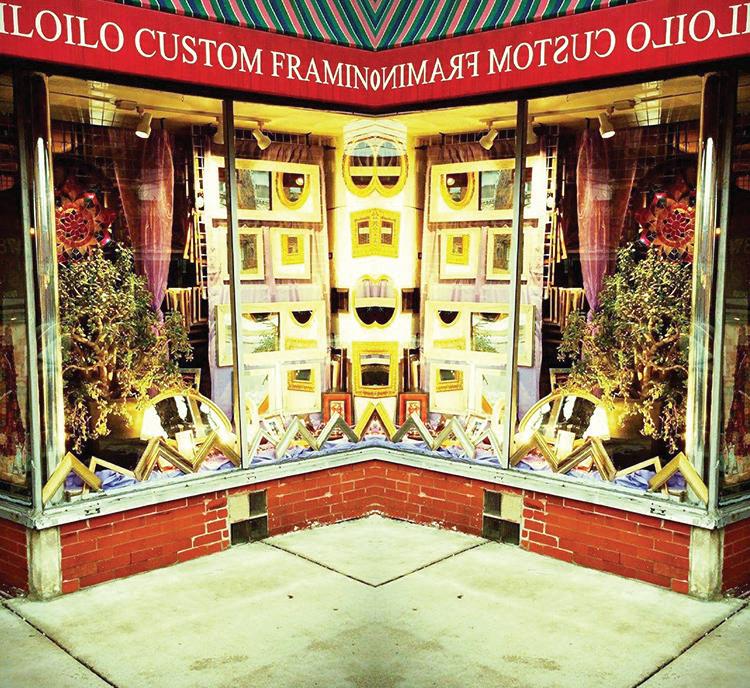




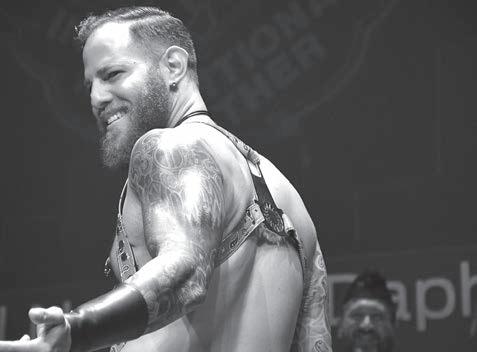

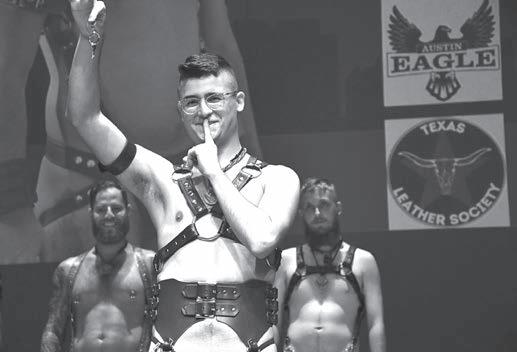

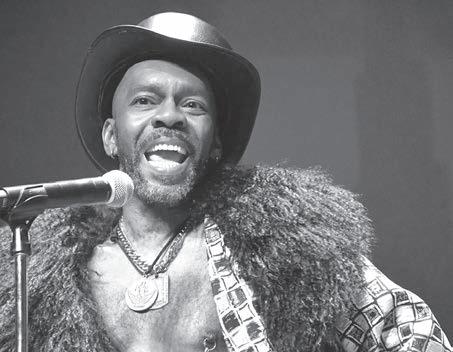

Nestled along the shores of the Gulf of Mexico, Pensacola, Florida, offers a unique blend of history, culture, and coastal charm along with a vibrant LGBTQ+ community. From its lively markets to its delectable dining options and picturesque natural wonders, Pensacola has something to offer every visitor. Let's take a closer look at some of the must-visit attractions in this captivating city.
I began my journey through Pensacola at the Palafox Market, where the community comes alive every Saturday morning. Located in the heart of downtown Pensacola, this bustling market offers a diverse array of locally grown produce, artisanal crafts, and delicious treats. Stroll through the rows of vendors, chat with local artisans, and immerse yourself in the vibrant atmosphere of this beloved community gathering. If I had brought more than a carry-on, I probably would have purchased a few items to bring home.
Pensacola boasts a thriving LGBTQ+ nightlife scene, with an array of bars, clubs, and restaurants that cater to the community. Check out The Roundup and Cabaret, two bars offering a variety of LGBTQ+ events and activities throughout the week.
Check in to the Holiday Inn Express Pensacola Beach for your stay. Located right on the beach, this is not your everyday Holiday Inn Express. The rooms are elegantly appointed, and every room comes complete with unobstructed views of the Gulf. Stroll along the
After exploring the market, treat yourself to a memorable dining experience at The Kennedy (https://www.thekennedy.bar/). This quaint alley, and the laid-back atmosphere was the perfect way to start the evening.
Continue your day with a visit to the Beach Pier, where you can try your hand at fishing or simply admire the panoramic views of the Gulf and Pensacola Beach. The newly reopened pier is 1,471 feet in length and is one of the most popular attractions along the beach. By the time you walk to the end of the pier, you’ll be hovering almost dozens of feet over the Gulf of Mexico. It’s the perfect place to watch the waves or catch the stunning sunset.
Pensacola is a vibrant hub of LGBTQ+ culture and community along the Florida panhandle. From colorful events and supportive organizations to inclusive spaces and advocacy efforts, Pensacola shines as a beacon of LGBTQ+ culture. Pensacola's LGBTQ+ community is as diverse as the city itself, encompassing people of all ages, backgrounds and identities. PFLAG operates a chapter in Pensacola and the city is home to numerous events throughout the Pensacola Pride Festival (https://www.johnnychisholm.com/), held annually over Memorial Day weekend and is the perfect kickoff to Pride month. This year marks the 30th anniversary of the festival which will be highlighted with performances by DJ Dan Slater, DJ Abel and Trixie Mattel and is a highlight of the city's calendar, featuring a colorful parade, live music and drag performances. Pensacola Pride draws tens of thousands of visitors and is one of the largest and most unique pride

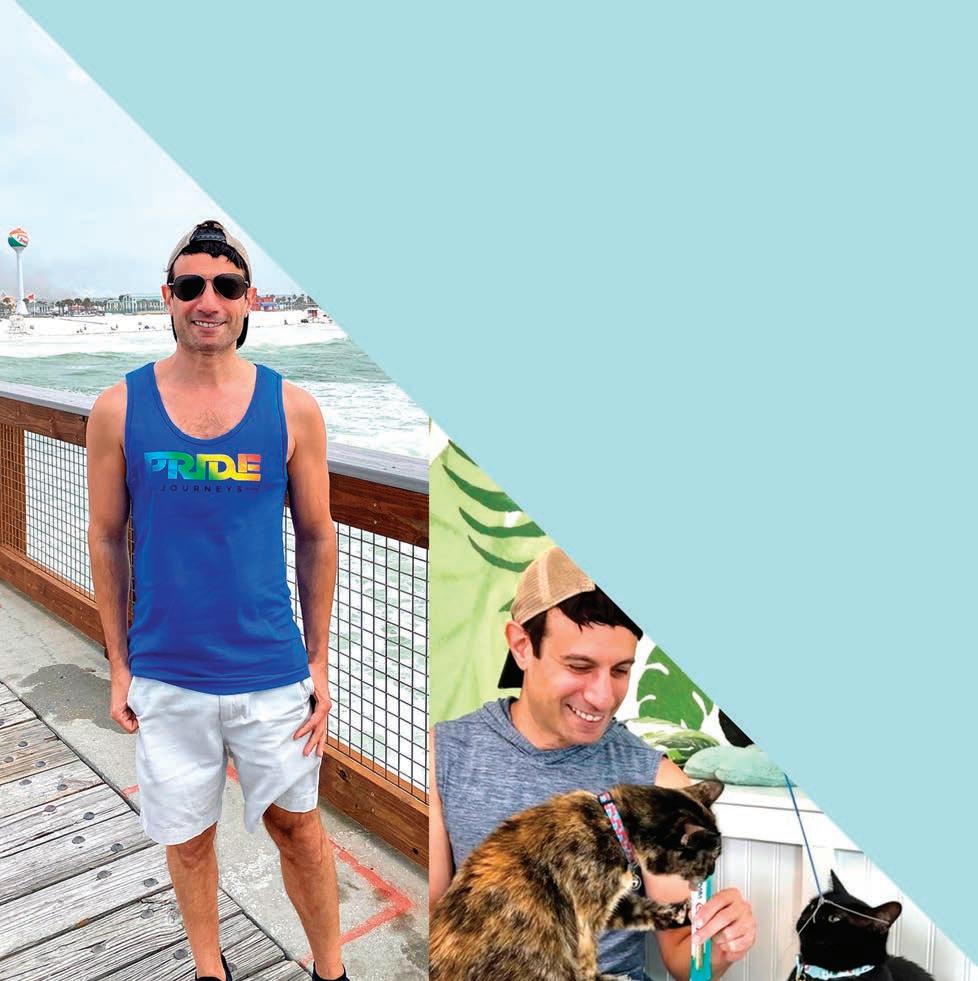
Another not-to-be-missed event in Pensacola is their annual LGBTQ+ film festival called Stamped Film Festival (https:// www.stampedfilmfest.com/) was spearheaded in 2012 by Sara Latshaw to create a more accepting, safe, and educated community. The film festival board and organization has continued to grow over the years with increased attendance at the annual film festival and by hosting other outreach activities. Stamped showcases the artistic contribution of LGBTQ+ film and filmmakers from all over the world. In 2015, the festival re-branded itself from Pensacola LGBTQ+ Film Fest to ‘Stamped Film Festival’, a name paying homage to the days when Memorial Day Weekend LGBTQ+ tourists stamped their money to demonstrate their significant impact on the local economy. For cat lovers, I highly recommend Coastal Cat Café (https://www.coastalcatpcola. com/) to play with and/or adopt one of their beautiful feline friends. The café is opened a few months ago, and reservations are recommended to
Foodies searching for authentic Gulf Coast flavors should head to Flounder’s Chowder House (https://flounderschowderhouse.com/), a beloved local institution since 1979. Located on the scenic Pensacola Beach Boardwalk, this laid-back eatery specializes in fresh seafood dishes, including their famous chowder and signature crab cakes. Relax on the outdoor patio, feel the gentle sea breeze, and savor the flavors of the Gulf as you dine overlooking the pristine white sands and emerald waters of Pensacola Beach. I ordered the legendary Bushwacker, a milkshake-style cocktail created in Pensacola, to accompany my entrée which consisted of blackened red snapper with sauteed asparagus. The snapper was cooked to perfection and was accompanied by a delicious sauce.
End your visit to Pensacola with a sunset dolphin cruise with Frisky Mermaid Boat Tours (https://www.friskyboattours.com/). My particular excursion was led by an all-female crew and was wonderful despite only getting to see a few dorsal fins. The tour lasts for about two hours and the friendly crew try their best to seek out as many beautiful dolphins as possible, although sometimes they can be hard to find. Nature can be unpredictable.
Pensacola offers a wealth of experiences for visitors to discover. From vibrant markets and culinary delights to historic landmarks and natural wonders, this charming city has something for everyone. Whether you're exploring its rich cultural heritage or simply basking in the beauty of its coastal landscapes, Pensacola is sure to leave a lasting impression on all who visit. Enjoy the Journey!
At A irm: The Rush Center for Gender, Sexuality and Reproductive Health, we want your entire health care experience to be relevant and compassionate. From routine checkups to gender-a irming services and surgery to specialists and advanced care, our doctors and sta are dedicated to inclusive care that celebrates who you are.
To learn more about LGBTQ+ care at Rush, scan the code below, visit rush.edu/a irm or call (833) 624-5428 .
